November 28, 2016
Gothic Schubert : Wigmore Hall, London
This recital will be one Lieder aficionados will remember for years. For 19th century Romantics, death was a source of endless fascination, much in the way that sex dominated the 20th century. Many songs in this programme are early works, some written when Schubert was as young as 14, and give an insight into his youthful psyche. Like most teenagers, before and since, he was intrigued by "the dark side". In a strict Catholic society, the Gothic Imagination gave a kind of legitimacy to dangerous, subversive emotions. The whole Romantic sensibility was a kind of Oedipal reaction against the paternalism of neo-Classical values. In these songs, we can hear young Schubert rebelling against his father, connecting to what we'd now call the subconscious.
In Ein Leichenfantasie D7 (1811) to a poem by Friedrich Schiller, a man is burying his son in a crypt. But why is the burial taking place in the dead of night. The son has a "Feuerwunde" penetrating his very soul with "Höllenschmerz". This death was not from natural causes. Suicide was a mortal sin. Schiller's meditation on the reversal of the natural order is sophisticated, the transits in the poem rather more elegant than Schubert's setting. In 1811, he was but still a child, so his transits between ideas are less elegant than Schiller's, but the ideas are original, if not completely coherent. Still, the song is an audacious tour de force lasting nearly 20 minutes, an undertaking that calls for finesse in performance. Eine Leichenfantasie exists in both baritone and tenor versions, though the former is better known, but it would have been asking too much of most audiences to hear both versions together in succession.
There were other sets of songs like Das war ich D174 a and b but the Kosegarten pairs, An Rosa I D315 (1815) and An Rosa II D 316 and the two Abends unter der Linde D235 and D237 (1816) benefited from the greater variety in the settings. The first Abends unter der Linde, for example, is more lyrical, the second more haunted, with its reference to the names of the poet's deceased children. Hence the value of a tenor/baritone recital highlighting contrasts in related pieces. There's clearly a good dynamic between Jackson and Farnsworth, which made the alternations flow together well. Their joint Lied (Ins stille Land) D403 (1816) was extremely impressive, the alternating voices capturing the lively flow of the music in typically Schubertian style, reaching "the land of rest" by vigorous images of movement, vividly depicted by Baillieu's expressive playing. Even with two very different songs, Lob des Tokayers D248 (1815)(Gabriele von Naumberg) and Punschlied 'Im Norden zu singen' D253 (1815) (Schiller) the flow between voices was enhanced by a very genuine sense of conviviality between Jackson and Farnsworth. Sincerity does matter in a genre like Lieder, which is so intense and so personal.
Sincerity matters, too, in strophic ballads like Der Vatermörder D10 (1811) to a poem by Gottlieb Conrad Pfeffel, in which a son kills his father. "Kein Wolf, kein Tiger, nein, Der Mensch allein, der Tiere Fürst, erfand den Vatermord allein, which makes an emotional point, though it's not borne out in nature. The text is maudlin. Having killed his father, the son wipes out a brood of fledgings whom he thinks were mocking him. Such melodrama might call for overblown declamation. Instead, Jackson sang sensitively: we must not laugh. The piano part thunders obsessively, suddenly slowing into watchful near silence, suggesting that the killer is insane, or at least as feral as the beasts of the woods. Like Eine Leuchenfantasie, Der Vatermörder is a teenage piece without much finesse, but Schubert treats it seriously, and so should we. This same emotional truth illuminated another pairing Der Einseidelei I and II, D393(1816) and D563 (1817) respectively. Both are settings of poems by Johann Gaudenz, Freiherr von Salis-Seewis, about hermits who live alone in nature: simple sentiments but not at all simplistic. Jackson's phrasing was sensual yet pure, suggesting that the hermit's choice was riches indeed. In Des Fräuleins Liebeslauchen D698 (1820) (Schlechta), a lovesick knight throws flowers to his ladylove. Jackson's naturalness of expression made us respect the knight, though his love might be in vain.
Jackson and Farnsworth are among the most promising English singers of their generation. I first heard Jackson sing a few songs in a private recital when he was only 22. Yet his voice is so distinctive that I immediately recognized it some years later when he sang at the Wigmore Hall/Kohn Foundation International Song Competition in 2011. Since then, he's developed extremely well, with a blossoming career in opera. Having worked in Stuttgart, his German is also more idiomatic than most English singers. Marcus Farnsworth won the Wigmore Hall/Kohn Foundation Song Competition in 2009 and appears in recital and on the BBC. James Baillieu is a well-known song accompanist and chamber player, who presented an 11-concert series at the Wigmore Hall last year.
This splendid programme, and performance, concluded with Schubert's Fischerweise D881 (1826) (Franz Xaver Freiherr von Schlechta) , a familiar favourite but rarely, if ever, heard with tenor and baritone sharing the honours. An inspired idea! The song moves briskly, with the piano playing jaunty rhythms "gleich den Wellen, und frei sein wie die Flut", which repeat in not quite matching pairs. With two singers, you can also hear how this duality is also embedded in the vocal line.The voices interact, like oars, pulling together. In the final strophe,words like "Die Hirtin" and "schlauer Wicht" are separated more clearly than is often the case, but this further emphasizes the choppy "waves" in the piano part and the concept of the sea as a metaphor for life. Meanwhile, on a bridge, a shepherdess coyly pretends to fish. The fisherman isn't fooled. "Den Fisch betrügst du nicht!"
Anne Ozorio
image=https://upload.wikimedia.org/wikipedia/commons/thumb/7/74/Caspar_David_Friedrich_-_Graveyard_under_Snow_-_Museum_der_bildenden_K%C3%BCnste.jpg/256px-Caspar_David_Friedrich_-_Graveyard_under_Snow_-_Museum_der_bildenden_K%C3%BCnste.jpg
image_description: Caspar David Freidrich : Graveyard under snow (1826)
product=yes
product_title= Franz Schubert Lieder : Stuart Jackson, Marcus Farnsworth, James Baillieu, Wigmore Hall, London 24th November 2016
product_by=A review by Anne Ozorio
product_id=
November 26, 2016
Rusalka, AZ Opera
With water-reflected light bathing the stage, Water Nymph Rusalka and her sisters “swam” sitting on the backs of chairs and waving their arms much as Russian ballerinas do in The Dying Swan.
Their world was separated from the world of humanity by a forbidding white door. Water nymphs and wood sprites wore ethereal gowns that moved gracefully with them and allowed the audience to perceive them as denizens of a different realm. Melinda Whittington was a poignant, tragic Rusalka who enchanted the audience and brought them into her world with her moon song “Mesiku na nebi hlubokem” (“O moon high up in the sky”).
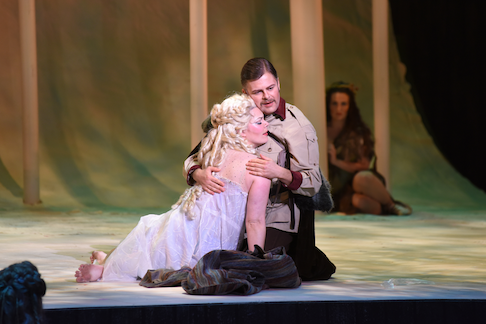 Sara Gartland and David Danholdt as Rusalka and The Prince
Sara Gartland and David Danholdt as Rusalka and The Prince
When Rusalka fell in love with the human Prince, her father, Vodnik, sung magnificently by Richard Paul Fink, warned her that no good could come of the match because humans are sinful. I wonder if Dvořák got his idea for Vodnik and the Three Wood Sprites from Wagner's Das Rheingold. Vocally, the combination of stentorian baritone and three high lyric voices was fascinating. Daveda Karanas was a human looking Ježibaba. With no pointed ears or other marks of an alien being, she wore a dress with a cut-out bustle that would have been quite fashionable in 1890s. She sang with dramatic vocal colors, but her characterization was rather bland.
Kevin Ray was a dramatic-voiced Prince whose character was bewildered by two women, Rusalka and the Foreign Princess, vying for his hand. Alexandra Loutsion was every inch the evil Foreign Princess and she sang with easily produced warm and resonant dramatic notes that made me wonder if she is a future Wagnerite. In this fairy tale, the Foreign Princess got the Prince’s ring and eventually shoved the social climbing water nymph back into her pond. That was a sad lesson, indeed, but one that must sometimes be learned.
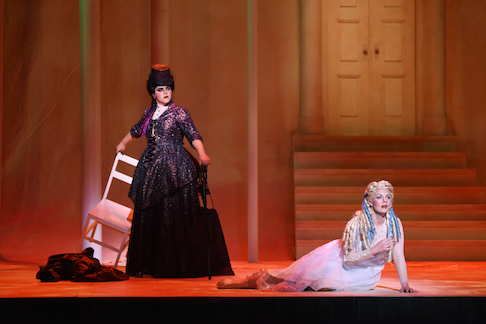 Daveda Karanas and Sara Gartland as Ježibaba and Rusalka
Daveda Karanas and Sara Gartland as Ježibaba and Rusalka
Kevin Newell was a dutiful hunter, but The Gamekeeper in a scruffy wig and the cowardly but limber Kitchen Boy supplied the comic relief that kept Rusalka from being totally tragic opera. Henri Venanzi’s chorus never appeared in front of the curtain and I wondered why. He has a good group but they might have seemed too earthbound for nymphs or sprites.
Dvořák’s music is exquisite and Conductor Steven White presented it in all its liquid, translucent beauty. Although memorable, the moon song is not the only great piece in this opera. There are many other scenes of similar evocative lyricism. The duet between Rusalka and the Prince has been described as one of the most enchantingly nuanced in all opera. Rusalka is a work we need to hear again so that we can get to know and understand its melancholy charm. I hope it won’t be too long before a company in Arizona or Southern California again presents Rusalka. It’s well worth hearing more than once.
Maria Nockin
Cast and production information:
Conductor, Steven White; Stage Director, Joshua Borths; Set Design, Mark Halpin; Costume Design, Adriana Diaz; Lighting Design, Jeremy Dominik; Choreographer, Molly Lajoie; Rusalka, Melinda Whittington; The Prince, Kevin Ray; Vodnik, Richard Paul Fink; Ježibaba, Daveda Karanas; The Foreign Princess, Alexandra Loutsion; Wood Sprites: Katrina Galka, Lacy Sauter, and Mariya Kaganskaya; Gamekeeper, Joseph Lattanzi; Kitchen Boy, Alyssa Martin; The Hunter, Kevin Newell; Chorus Director, Henri Venanzi.
image=http://www.operatoday.com/Rusalka%20dress-14.png
image_description=Sara Gartland as Rusalka [Photo by Tim Trumble]
product=yes
product_title=Rusalka, AZ Opera
product_by=A review by Maria Nockin
product_id=Above: Sara Gartland as Rusalka
Photos by Tim Trumble
November 25, 2016
First new Ring Cycle in 40 Years, Leipzig
This spectacular musical experience by the Gewandhaus Orchestra (GO) enthralled the audience with engaging singers that included Markus Marquardt, Andreas Schager, Evgeny Nikitin, Christiane Libor, and Stefan Vinke and a superb supporting cast. This was a vocally dramatic thrill ride. If you’re a stickler for basic productions, you will be missing out on the terrific orchestra. This Ring Cycle is worth a trip to Germany.
That’s not to say there weren’t any problems. Sound effects clumsily missed their timing. Wotan didn’t catch his stagecall for Die Walküre’s Third Act, so everything needed to be stopped and restarted. But this made the communal experience all the more endearing and disarming: an intimate sharing experience of musical excellence for the audience. It was the strong cast and sublime Gewandhaus Orchestra that turned this Ring Cycle into an unforgettable experience.
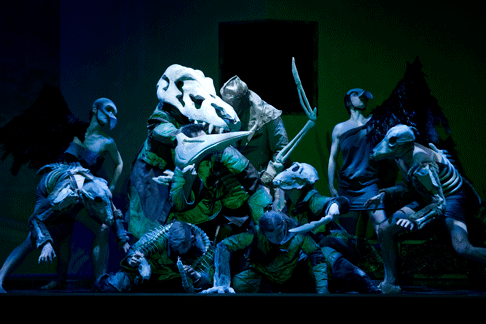
Ulf Schirmer demonstrated why the GO can count itself to best orchestras of the world. With ceaseless intensity, Schirmer elevated Wagner’s luxuriant Romantic score to superlative heights with many goosebumps and hair raising moments. With a history of Herbert Blomstedt and Riccardo Chailly as past Principal Conductors, the development of such high quality German culture is evident. Now Andris Nelsons has made the GO his orchestra together with his Boston Symphony Orchestra. Overseeing both, he plans a partnership and festival. However at the Leipzig Oper, it is Schirmer who brilliantly conducts!
Simple but at times cluttered staging
After their collaboration on Tri Sestri by Peter Eötvös, Leipzig Oper’s General Music Director Ulf Schirmer approached Rosamund Gilmore for this Ring Cycle, starting with the premiere of Das Rheingold in 2013. Even if the staging had its convoluted moments, none were deal-breaking. The simple sets allowed for intensely sung drama to occur between the performers and kept an emphasis on the music.
Gilmore’s ballet background influenced her production. Throughout, the British choreographer included baffling modern dance for the “mythical elements” of Wagner’s world. I could have done without these distracting spasms. They showed up every evening, but it was not until their appearance in Siegfried’s forest setting that they finally seemed to fit in Gilmore’s world. Though what she turned Fafner the dragon into left me a bit confused in his giant appearance.
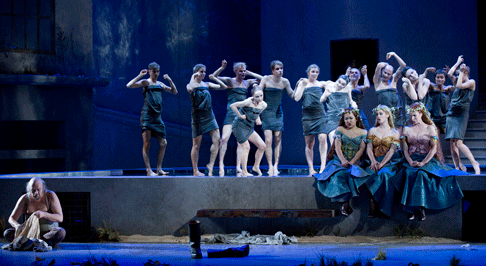
The stage involved geometrical structures and deconstructed buildings. The flashy Das Rheingold had the most interesting set: Carl Friedrich’s Oberle’s dynamically changing Escher-esque design with atmospheric lighting turned Nibelheim into a visually enflamed hell. He enriched the Rhine and the Rhinemaidens with aquatic projections.
Nicole Reichert‘s costumes added an elegant class to the gods. She made the Rhinemaidens look tantalising, and turned giants Fasolt and Fafner into convincing oafs. Her childish outfit for young Siegfried was a bit over the top, but Vinke pulled it off.
Superb vocals and orchestral excellence
In Das Rheingold, Tuomas Pursio convinced as the young Wotan, but Karin Lovelius’ stunning vocals as Fricka overpowered him. Pursio would have an impressive vocal revanche as the manipulating Gunther in Götterdämmerung. With her eerie vocal effects, Nicole Piccolomini had scene-stealing moments as Erda, though in her gothically glamorous dress she particularly dazzled in Siegfried. Jürgen Linn as Alberich carried a devious and resentful air that made him fully dislikable. His voice filled with a dark, hateful intonation. As Mime, Dan Karlström’s impressive voice clashed with more of Gilmore’s awkward choreography.
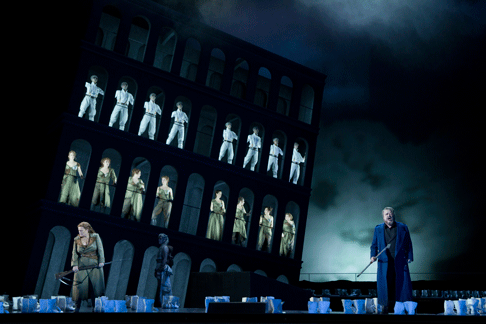
The vocal high point of the four nights was Andreas Schager’s boisterous Siegmund in his impassioned duet with Christiane Libor. Together they delivered great chemistry. With her vocal prowess, she held her own as Sieglinde. Though with his star wattage, Schager was the clear audience favorite; his curtain call led to an endless applause. Hanging on to every breath of the charismatic Schager, the young man next to me sat on the edge of his seat, equally captivated and swept away as I was, as Siegmund exclaimed his love for his sister. After Siegmund’s death, Schager’s absence left a void of glamour.
Later in Akt III, after he killed the momentum due to his missed stage cue, disrupting the thrilling energy of Schirmer’s electrifying “Flight of the Valkyries”, a commanding Markus Marquardt as Wotan made up for as much as he could in his father-daughter drama together with Eva Johansson’s Brünnhilde. Her emotion convinced, though she never quite reignited. This technical interruption resulted in a energetically challenged Third Act.
Die Walküre ruled with its thrilling female power. In Siegfried’s coming-of-age story Schirmer switched to Wagner’s testosterone drive. Bayreuth regular Stefan Vinke took a while to grow into his role as this young Siegfried. He delivered some great comedic timing on his puerile journey through the forest. He finally hit his stride in his interaction with Elisabet Strid’s sensitive Brünnhilde at the end. Their dynamic felt real and served as a disarming finale, leaving me with tears streaming down my face.
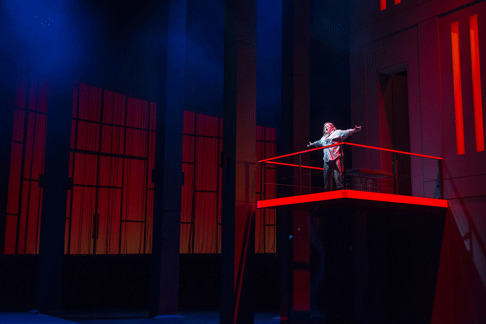
Götterdämmerung came with the stylish severity of the unhappily wealthy (here also alcoholic) siblings Gurtrune and Gunther. Wagner’s passionate interactions exploded on stage. Marika Schönberg turned Gurtrune into a hot mess, shivering in fear from Stockholm Syndrome in her relationship with her brother. Michael Reger as Hagen served showstopping moments.
But on this last night, it was Christiane Libor’s time to shine. She commanded the spotlight as she owned the role of Brünnhilde. Full of passion and despair, she captivated me with her convincing emotion and powerful voice. Mindblowing!
On these four consecutive evenings, Ulf Schirmer demonstrated conducting skills through his professorial discipline enriched by his deep passion and academic expertise. Every night, he kept a thrilling momentum going. Time became meaningless.
With “Siegfried’s Rhine Journey” and the “Funeral March” as monumental highlights, Schirmer produced the GO’s distinguished brilliance and electrifying depth. A crisp sound, lush textures, and an elucidating transparency kept the listener fully intoxicated. Even after the music ended it kept on going in my head. In fact, it was one of those rare life affirming musical experiences.
What more can I say to convince you to visit this Ring Cycle? After the invigorating Vorabend in the early evening, a hilarious scene occurred. Andris Nelsons and the Boston Symphony Orchestra made their debut at the Gewandhaus Hall right across from the Oper Leipzig. So after two and half hours of Wagner, a mass of music fanatics hurried across to be on time for Mahler’s Ninth Symphony. Such concentrated quality programming is not uncommon in the highly cultural Leipzig.
Don’t miss the Oper Leipzig’s Ring Cycle.
David Pinedo
For additional information: http://www.oper-leipzig.de/de/wagner
image=http://www.operatoday.com/Foto-20_Siegfried_12.04.15_%C2%A9Tom-Schulze.png image_description= product=yes product_title=First new Ring Cycle in 40 Years, Leipzig product_by=A review by David Pinedo product_id=Photos by Tom SchulzeSan Jose’s Beta-Carotene Rich Barber
Inventive stage director Layna Chianakas cleverly started the homage to The Rabbit of Seville early on and carried the hijinks throughout the performance. As the orchestra launched into the jaunty up-tempo repeated chords of the overture, suddenly a silhouette of an enormous carrot appeared as a projection on the grand curtain, traveled across the front of it, and disappeared. Before you wondered if you could believe your eyes, another one appeared from the opposite side and did the same.
By then, we got it. The laughter and applause as we recognized the reference nearly drowned out the merry music-making in the pit (a taut, idiomatic reading led by Andrew Whitfield). The overture was “staged” with carrots dancing, parading and moving into positions suggesting the crossed swords of a family crest. With this cheeky beginning, the tone was set for a no holds barred romp.
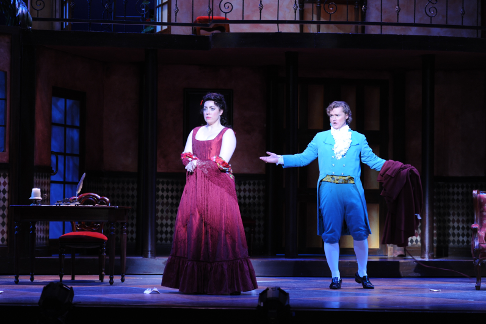 The Count and Rosina
The Count and Rosina
Babatunde Akinboboye put his polished baritone on ample display as a winning Fiorello, serving immediate notice that the standard of the afternoon’s singing would match the ingenuity of the staging, and then some. Maestro Whitfield is also the Chorus Master and the men’s ensemble belied their disparate and ragtag look by offering meticulous harmonizing. We are all waiting Figaro’s signature entrance, of course, to experience one of the most familiar arias in all of operadom.
Brian James Myer delivered a true star turn in the title role. Factotum is too puny a word to describe Mr. Myer’s (dare I say ‘definitive’?) performance. I cannot recall encountering anyone in my many years of seeing this piece who exhibited anywhere near such a total command of the role, the style, the joyous abandon. His arsenal included an effortless stage demeanor, a thoroughly considered subtext, flawless comic timing, and a tirelessly wiry presence.
Brian’s evenly produced, appealing baritone may not be in the burly Milnes or Mattei vein, but it has plenty of ping and sass, with a warmly ingratiating tone that fills the house. Figaro is Brian James Myer’s first role assumption as a Resident Artist, and Opera San Jose can be very proud of their superlative choice in adding such a fine young talent to their roster. Nor was he alone in his accomplishments.
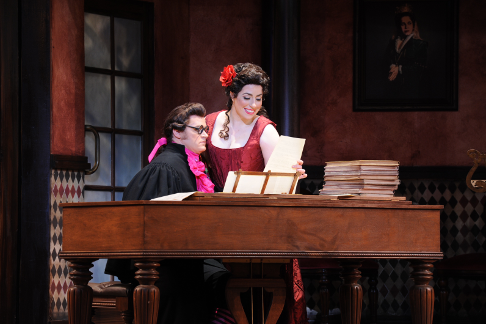 Kirk Dougherty (Almaviva) flirts with Renée Rapier (Rosina) in the Lesson Scene
Kirk Dougherty (Almaviva) flirts with Renée Rapier (Rosina) in the Lesson Scene
The OSJ talent roster has a deep bench and the remarkably versatile tenor Kirk Dougherty turned in another treasurable performance as Count Almaviva. Mr. Dougherty once again regales us with a honeyed voice that is pliable, beautifully produced, and consistently responsive. His forays into the upper reaches of the role are as comfortably negotiated as the characterful melismas.
The Count has several comic guises in this piece to be sure, and Kirk keeps his tone freely produced even as he colors it to suggest less aristocratic denizens of Seville. His beautifully delivered serenade benefitted from his skill at providing his own guitar accompaniment, a singular feat. Like his titular costar, he established his comic credentials early on, and the expository Figaro-Almaviva duet crackled with witty Rossinian interplay.
The radiant mezzo Renée Rapier immediately engaged our ears with a plush, ripe tonal beauty that announced her as a major discovery. In short order, she also captured our hearts with an especially assured Una voce poco fa. Her fresh, spontaneous reading of this thrice-familiar piece immediately established her credentials as a first tier Rosina. Ms. Rapier’s rich lower register was wedded to a solid middle and brilliant top, giving off coloratura sparks as demanded, and coy romantic heat when appropriate.
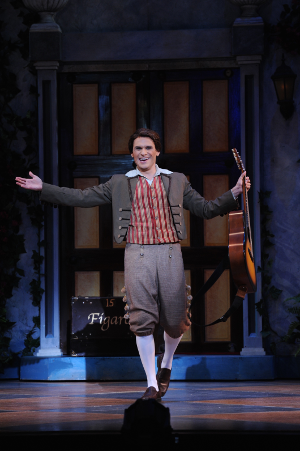 Brian James Myer as Opera San Jose's dynamic Barber of Seville
Brian James Myer as Opera San Jose's dynamic Barber of Seville
She, too, proved to be a well-rounded, richly complicated personality, and she found a variety of meaningful expression in her impersonation. Her comic sensibilities were a formidable component in the day’s success, and she clearly relished interacting and conspiring with her Figaro and Lindoro. Even though I knew it was coming, her spot on revelation that she has already written the love note that Figaro is prompting her to compose was so “right” that I barked a surprised laugh out loud. This cast was treating the audience to Barbiere as if for the first time, and we relished their sense of discovery.
The oily Music Master Basilio was well-served by the wonderfully suave basso voice of another Young Artist, Colin Ramsey. Allowing him to be honestly, unabashedly youthful was an inspired choice, and no comedy was lost by showcasing Mr. Ramsey’s gorgeously rolling tones, with their vibrant young sheen. A solidly delivered La calunnia has rarely been as pleasingly voiced, yet with all the necessary sinuous underpinnings.
Considering that Valerian Ruminski was undertaking the challenging part of Bartolo for the first time, he revealed much in his depiction of the devious curmudgeon. Mr. Ruminski has a smooth, orotund baritone, perhaps a bit too smooth for this volatile character. His was not (yet?) in the tradition of bloviating, blustering practitioners, but is a little (too?) smooth around the edges. His difficult rapid-fire patter was not always as precise as it may become. Still, his persona and physical stature are ideal for the role and he proved a competent player in the twisting plot. His outlandishly comic, brazenly mis-tuned aria in the Lesson Scene was alone worth the price of admission.
It would be hard to imagine a more committed and scene-stealing Berta than that embodied by the vivacious Teressa Foss. Too often this can be a throw-away part, but Ms. Foss played a deliciously willing accomplice in Rosina’s detention, with an apparent girly fixation on carrying stuffed animals, which increased in obsessive number as the show progressed. Teressa is also possessed of a laser-focused whiz-bang of a soprano voice, and her effortless flights above the staff were as admirable as they were totally unexpected. In the small role of the Sergeant, Sidney Ragland made every phrase count with a secure delivery
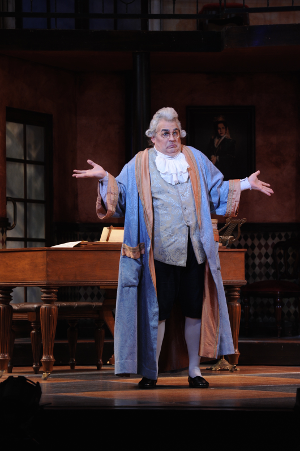 Valerian Ruminski's role debut as Bartolo
Valerian Ruminski's role debut as Bartolo
The physical production was all that could be wished. Matthew Antaky designed an unfussy, practical, attractive set that afforded plenty of opportunities for varied blocking, effective levels, and even a few surprises. The colorful exterior for the opening was wonderfully dressed with palm trees, profusions of flowers, Mediterranean tiles and a fountain. That gave way to a two-level interior with enough doors for a decent Feydeau farce.
Alyssa Oania is credited as being costume coordinator, which may mean she carefully selected the good-looking attire from stock. But Rosina’s well-styled burgundy dress and Spanish shawl seemed far too fetching not to have been created specifically for her, and Basilio’s accessories (including eyewear resembling designer goggles, prissy white hanky, fuschia jabot and matching striped socks) were brilliant touches. And were brilliantly copied for Almaviva’s phony teacher in Act Two.
A highly effective wig and make-up design complemented the dress, with Christina Martin providing excellent support. The gag of having Figaro distractedly tease Bartolo’s wig, not having realized the good Doctor has vacated it, was a memorable visual. And Basilio’s heavily made up doe eyes and high cheekbones made him look eerily like Lily Tomlin in drag. The bobbling, wobbling mustache for Almaviva’s drunken soldier was also a comic plus.
Kent Dorsey achieved a good deal with his diverse lighting design. In addition to even area washes and atmospheric gobos, Mr. Dorsey programmed a number of specialty spots that were helpful in creating a rhythm to the look and flow of the show. He alternated blackouts with spotlighting Figaro during his entrance aria, contributing to the cartoon-like sensibility that permeated the concept. Only the colored disco light effect at the end seemed slightly out of sync.
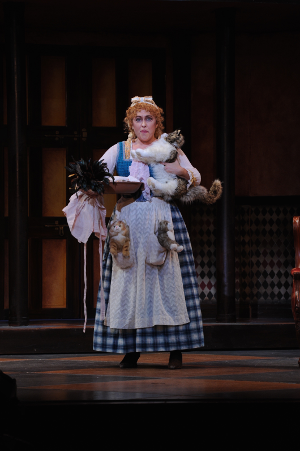 Teressa Foss's Berta loves animals
Teressa Foss's Berta loves animals
With all the key casting and technical positions filled with consummate professionals, it was arguably Maestro Whitfield and Director Chianakas who were the icing on the cake. Or the maple glaze on the carrots. Whitfield helmed a talented collective of solid strings, colorful winds, and punctuating brass that unified into an effective Rossinian arc. And Ms. Chianakas drew out richly detailed interplay onstage that was chockfull of revelatory ideas.
The uninhibited clowning by the choristers at the top, including some balletic goofs, was infectious and conveyed an expectation of what would follow. This included a dizzy moment with the Count and the Barber freezing as “statues” in the fountain to avoid detection by Bartolo, who is exiting his house. The removal of the ladder by some unseen force in the climactic scene was perfectly timed. I am not sure that Mr. Myer’s masterful Figaro needed help putting across his aria by the addition of three chorus girls extras sporting huge wigs studded with salon accouterments, but I appreciate the thought.
A far better thought was turning the storm into a psychological tempest, in which a dreaming Rosina presents a love letter to each of the other principals, then thinks better of it and tears the missives up one by one before returning to her sleep on the settee. A well-considered, serious moment in all the jollity.
But it was not long before those danged carrots were back with us, as a running gag that paid good dividends. Whether being played as musical instruments, tossed about the stage, or God knows what else, those orange veggies always brought us back to the source of this production’s comic inspiration.
So, what’s up Doc? A witty, slapstick celebration of an in-joke that was always characterized by well-calculated physical and intellectual humor, and married to an admirably first tier musical execution. In short, another solid achievement by the resourceful Opera San Jose.
James Sohre
Cast and production information:
Fiorello: Babatunde Akinboboye; Almaviva: Kirk Dougherty; Figaro: Brian James Myer; Bartolo: Valerian Ruminski; Rosina: Renée Rapier; Berta: Teressa Foss; Basilio: Colin Ramsey; Sergeant Sidney Ragland; Conductor/Chorus Master: Andrew Whitfield; Director: Layna Chianakas; Set Design: Matthew Antaky; Costume Coordinator: Alyssa Oania; Lighting Design: Kent Dorsey; Wig and Make-up Design: Christina Martin
image=http://www.operatoday.com/OSJ%20Count%20Basilio%20Figaro%20Rosina.png image_description=From left, Kirk Dougherty (Almaviva), Colin Ramsey (Basilio), Brian James Myer (Figaro), Renée Rapier (Rosina) [Photo by Pat Kirk] product=yes product_title=San Jose’s Beta-Carotene Rich Barber product_by=A review by James Sohre product_id=Above: From left, Kirk Dougherty (Almaviva), Colin Ramsey (Basilio), Brian James Myer (Figaro), Renée Rapier (Rosina)Photos by Pat Kirk
November 24, 2016
Manon Lescaut at Covent Garden
A crumbling freeway flyover juts jaggedly into a black nothingness. As Manon collapses into her desert surrounding, so the terrain itself sinks into abyss.
Puccini’s third opera was premiered in Turin on 1st February 1893 - just over a week before the first performance of Verdi’s Falstaff in Milan - and the work’s blending of obvious debts to Italian Ottocento lyric traditions and an engagement with Wagner’s innovative harmonic language ensured that it was an unqualified success, with contemporary critics declaring Puccini the foremost composer on the Italian scene.
However, to present-day audiences, Puccini’s opera can seem less an evolutionary development of the past, and more a strikingly modern statement. And, despite the undeniable beauty of the score, after its initial triumph the opera’s subsequent critical reception has at times been characterised by disquiet: a sense that there is something insalubrious and ‘not quite nice’ about the opera. Kent and his designer Paul Brown wholly embrace the dark side of Puccini, and drag his nineteenth-century good-time-girl-gone-bad into the modern world.
Their dystopian twilight zone is, however, somewhat at odds with the sensuous eroticism of Puccini’s score. Admittedly, when mired in the bleakness of Act 4, it is difficult to find a redemptive note in Manon’s demise - a death which she fights to the last: ‘No! non voglio morir …’ But, it is passion and not pointlessness which lies at the heart of this opera, and it is this essential ‘soul’ which Kent neglects. There is a gratuitous quality about Manon’s suffering; it signifies nothing but itself.
Fortunately, conductor Antonio Pappano is in the pit to restore the opera’s impassioned pulse and pump emotional life-blood through its veins. On the first night of the run, his crafting of the musico-dramatic ebbs, flows and lurches was masterly and utterly convincing. Pappano has an innate feeling for the long lines which expand so effortlessly. The constant shifts of mood seem entirely natural. The Prelude opened with a searing and slashing slash of the violins’ knife but before we knew it the mood had lightened and we were swept along by the rich busyness of the opening scene. The intermezzo between Acts 2 and 3 presented a stunning array of emotional colours and musical ambiences: there was a tremendously sense of spontaneity and directness, as Pappano plunged the depths of the drama. The ROH Orchestra held nothing back, but the playing was never anything but elegant. Indeed, one of the most striking features of the performance was that while the ostentatious romantic climaxes were relished there were moments of great delicacy too. The series of chords that open the final Act were an unnerving shudder of death; mid-way through this Act, the theme which represents the protagonists’ love - and which had blazed so triumphantly at the end of Act 3 - was heard again, a shimmering reprise, a symbol of a hope now faded and elusive.
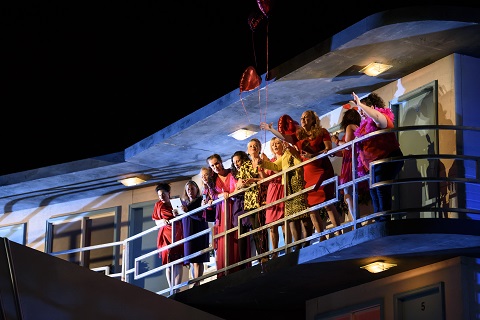 ROH Chorus, Act 1. Photo credit: Bill Cooper
ROH Chorus, Act 1. Photo credit: Bill Cooper
Kent and Brown are more mundane, the brutality of their realism quashing any lingering romance. The square and inn of Amiens, the setting for Act 1, are jettisoned for a flashy apartment block and a gambling casino. Thus, a light-hearted evening gathering in the village - denim-clad teenagers whizz around atop wheelie bins and adolescents bounce about exuberantly led by Luis Gomes’ ebullient, open-hearted and warm-voiced Edmondo - is set against an iniquitous den of baize gaming tables and one-armed bandits, intermittently lit with a lavish glare by lighting designer Mark Henderson.
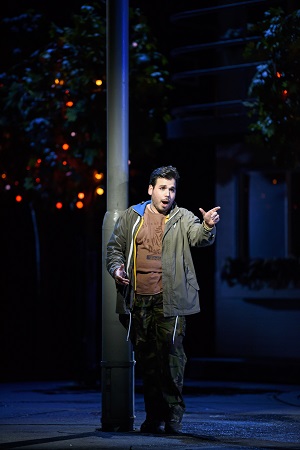 Luis Gomez as Edmondo. Photo credit: Bill Cooper.
Luis Gomez as Edmondo. Photo credit: Bill Cooper.
Manon arrives in a silver SUV, a picture of innocence in her floral frock. But, it’s but a short step from urban ingénue to Geronte’s peacock in a ‘golden cage’. And, in Act 2 Manon finds herself in an opulent but lurid boudoir of cerise and purple, in which time stands still and Manon herself is frozen as one of Geronte’s riches.
There is nothing intimate about this ‘private’ space which is the setting for Act 2; it’s a peep-show booth in which Manon preens her hair, applies her elaborate make-up, is pleasured by the lesbian Singer - a role ably sung by Emily Edmonds - and gyrates and squirms for the delectation of a posse of geriatric, masked voyeurs, who, with their backs to us, enjoy a soft-porn display during the Act 2 pastorale which a cameraman records on a hand-held camera - presumably for YouTube dissemination.
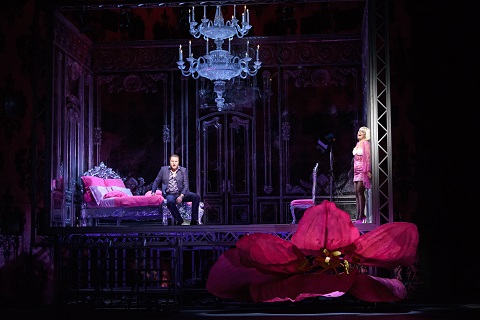 Levente Molnar as Lescaut, Sondra Radavanokvsy as Manon Lescaut. Photo credit: Bill Cooper.
Levente Molnar as Lescaut, Sondra Radavanokvsy as Manon Lescaut. Photo credit: Bill Cooper.
Kent’s trope, though, is not irrelevant. From her first entrance in Act 1, Manon is presented through the gaze of others, principally Des Grieux. When Lescaut’s cries to the Innkeeper catch his attention, he raises his eyes and sees Manon: the libretto tells us that ‘facendo un gesto di meraviglia, la osserva estatico’ (making a gesture of amazement, he looks at her ecstatically), and with a cry, ‘Dio! Quanto è bella’ (God! How beautiful she is), he hides from view in order to espy her. His gaze guides us; we first see Manon through the filter of Des Grieux’s rapture and wonder. Our gaze is bound with his and that of the other characters on stage, including the assembled line of dirty old men. In Kent’s reading, our ‘heroine’ is aware that all eyes are on her, and is complicit in the performance of her personae.
Yet, whether the director manages to turn Manon from a passive object of desire into an active subject who can manipulate her own identity within a prescribed system is another matter. Urging her to escape, Des Grieux cries ‘Bring only your heart’ as Manon stuffs Geronte’s jewels into a pillow case; her tardiness is her downfall - seemingly captivated by the room’s treasures she succumbs to its claustrophobic clutch and is arrested.
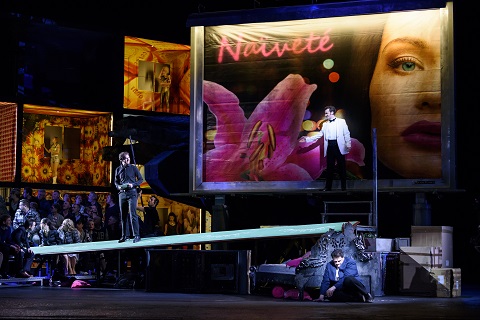 David Shipley as Sergeant, Nicholas Crawley as Naval Captain, Aleksandrs Antonenko as Des Grieux. Photo credit: Bill Cooper.
David Shipley as Sergeant, Nicholas Crawley as Naval Captain, Aleksandrs Antonenko as Des Grieux. Photo credit: Bill Cooper.
In Act 3 the dock-side square at Le Havre, through which the humiliated prisoners process on their way to deportation to the US, becomes in Kent’s hands the studio of a TV reality-show, compered not by a police sergeant but by a tuxedoed MC. The girls are taken to an Amsterdam-style red-light district where sex slaves are trafficked abroad by pimps.
And, though there are, during the proceedings, some front curtain projections of text from the 1731 novella by Abbé Prévost on which the opera is based, Puccini’s Act 4 crucially rejects the context provided by Prévost's narrative, and excludes the months of contentment spent by Manon and Des Grieux in New Orleans. So, Kent plunges us into misery - and pushes Des Grieux and Manon through a gaudy advertising hoarding onto a highway of broken dreams.
In the title role, Sondra Radvanovsky does not always appear a natural fit for Kent’s soft-porn star protagonist but her warm soprano wins our sympathy, and she crafts many a winning lyrical line, counter to the staging’s coldness. Radvanovsky acts and moves well. Her vibrato was quite wide and in the first two Acts she exhibited a tendency to slide onto notes - and struggled to hold onto the note when she’d got there - but she succeeded in conveying both the warmth and vulnerability of Puccini’s creation. Manon’s Act 4 peroration, ‘Sola, perduta, abbandonata’ - in which Puccini thrusts Manon into our prying gaze (in contrast to Prévost’s discretion) - was a touching rebellion against death and against the society which seeks to punish her. In Manon's last vocal moments, Radvanovsky found incredible, if waning, sweetness, ensuring that we understood the dreadful regrets of the dying woman. Radvanovsky crafted the arching cries, the fragmented contours, and the truncated repetitions, with acute theatrical insight and technical skill - she moved, indeed leapt, effortlessly, from the top to the bottom of her range.
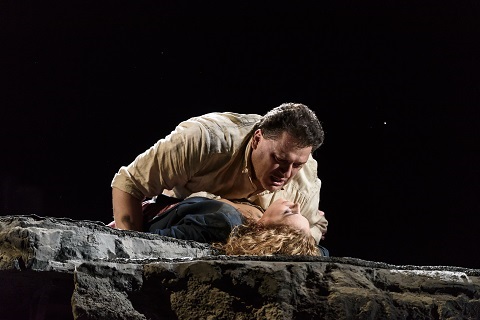 Aleksandrs Antonenko as Des Grieux and Sondra Radanovsky as Manon Lescaut. Photo credit: Bill Cooper.
Aleksandrs Antonenko as Des Grieux and Sondra Radanovsky as Manon Lescaut. Photo credit: Bill Cooper.
Latvian tenor Aleksandrs Antonenko was vocally assured as Des Grieux; he fired his big guns with lyric aplomb - ‘Donna non vidi mai’ was impressively expansive - and if some of the risks he took at the top end did not come off, then at least he was impassioned in his essays, and his Act 4 emoting was superb. Antonenko is not equally assured across his range, but this helped to convey an impression that his Des Grieux combined vocal strength with vulnerability.
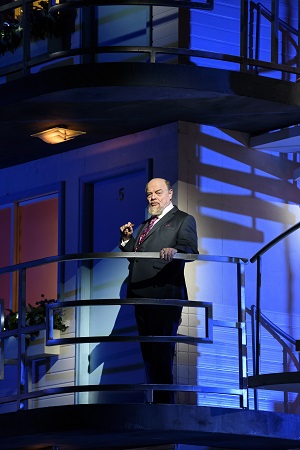 Eric Halfvarson as Geronte de Revoir. Photo credit: Bill Cooper.
Eric Halfvarson as Geronte de Revoir. Photo credit: Bill Cooper.
Eric Halvarson was a cunning Geronte de Revoir, not afraid to make an ugly sound if it served the drama. His elderly roué had strong dramatic presence, and the text was cleanly delivered. Levente Molnár was persuasive as Manon’s charming but unprincipled brother, Lescaut.
I left the theatre feeling that if Tosca was Puccini’s ‘shabby little shocker’, then Manon Lescaut was his depiction of shockingly cruel injustice.
Claire Seymour
Giacomo Puccini: Manon Lescaut
Manon Lescaut - Sondra Radvanovsky, Chevalier des Grieux - Aleksandrs Antonenko, Lescaut - Levente Molnár, Geronte de Revoir - Eric Halfvarson, Edmondo - Luis Gomes, Musician - Emily Edmonds, Dancing Master - Aled Hall, Singer - Emily Edmonds, Lamplighter - David Junghoon Kim, Sergeant - David Shipley, Naval Captain - Nicholas Crawley, Innkeeper - Thomas Barnard; Director - Jonathan Kent, Conductor - Antonio Pappano, Designer - Paul Brown, Lighting designer - Mark Henderson, Movement director - Denni Sayers, Orchestra of the Royal Opera House, Royal Opera Chorus.
Royal Opera House, Covent Garden, London; Tuesday 22nd November 2016.
image= http://www.operatoday.com/cBC20161118_%20MANON_LESCAUT_0057_%20SONDRA%20RADVANOVSKY%20AS%20MANON%20LESCAUT%20c%20ROH.%20PHOTO%20BY%20BILL%20COOPER.jpg image_description=Manon Lescaut at Covent Garden product=yes product_title=Manon Lescaut at Covent Garden product_by=A review by Claire Seymour product_id=Above: Sondra Radvanovksy (Manon)Photo credit: Bill Cooper
November 21, 2016
Fierce in War, dazzling in Peace: Joyce DiDonato at the Concertgebouw
Amsterdam was the second stop on DiDonato’s currently ongoing concert tour, which is coupled with her latest album and titled In War & Peace — Harmony through Music. Extensive preparation attested to how much this undertaking means for the singer. Each patron was handed a card with a heartfelt message from her, and an invitation to answer the question, posed in sixteen languages: “In the midst of chaos, how do you find peace?”. When the public trickled into the half-lit hall, DiDonato was already on the stage, where she remained the whole time, acting and interacting with her fellow performers. She has eloquently explained her goals for this project in the media: to find peace in a time of unfettered hate speech and violence, to rediscover hope smothered by despair. Whether her choice of music, atmospherically enhanced by lighting, video and dance, achieved this for her audience would depend on the individual, but no one could deny her impressive display of prowess and involvement. She is an artist at the zenith of her powers, wielding her technical tools with surgical skill and maximum expressive impact.
On the program were familiar Baroque gems, orchestral interludes performed by Il Pomo d’Oro, and two rediscovered arias by Neapolitan composers Leonardo Leo and Niccolò Jommelli. The concert was thematically split into two, War before and Peace after the break. In an asymmetrical gunmetal-colored gown, her face and neck livid with stylized wounds, DiDonato kicked off War with Handel’s aria “Scenes of Horror, Scenes of Woe” from Jephtha. She put such intensity into the dark premonitions that one wondered how she could sustain the pressure during successive numbers. She did. Surrounded by video projections and light effects suggesting explosions and aerial bombings, she was an ever-deepening vortex of emotion. During an orchestral arrangement of Gesualdo’s Tristis est anima mea, originally a vocal setting of Christ’s fearful prayer in the Garden of Gethsemane, DiDonato lay consumed by silent suffering. In Leo’s “Prendi quel ferro, o barbaro!” Andromache’s music swings back and forth from rapid rage to maternal tenderness. In the torridness of this aria and Handel’s “Pensieri, voi mi tormentate” from Agrippina, DiDonato drove her voice to its expressive limits. Her high notes were at times so piercing it seemed as if she were about to lose control. This was, however, just an illusion. In her fierceness she retained technical command, effortlessly stretching and embellishing Agrippina’s tortured lines. For the two mournful arias by Purcell and Handel, deeply saturated with feeling, Maxim Emelyanychev, leading from the harpsichord, scaled down the ensemble to a delicate whisper. It was the perfect accompaniment to the ghostly diminuendos on the repeated “remember me” of “When I Am Laid in Earth”. Never has Dido sounded so desperately close to death. Handel’s “Lascia ch’io pianga” was taken very slowly, closing the first half with a trace of hope symbolized by projected falling petals.
The theme of hope in captivity was picked up in the second part, Peace, with “They Tell Us that You Mighty Powers” from Purcell’s unfinished The Indian Queen. Singer and orchestra struck an ideally soothing tone in this charming, unadorned melody. DiDonato offered her antidote to violence and darkness dressed in liquid silver by Vivienne Westwood, having replaced her painted wounds with sprays of flowers. More than through the content, she administered the medicine through her musical brilliance, fully on display in the Handel arias. Ravishing tone in “Crystal Streams in Murmurs Flowing” from Susanna, dazzling coloratura in Cleopatra’s triumphant “Da tempeste il legno infranto”, and fabulous chirping and warbling in “Augelletti, che cantate” from Rinaldo, twinned with Anna Fusek’s baffling virtuosity on the recorder. Besides hope and joy, there was also remembrance. Manuel Palazzo danced a dignified solo to the hypnotically rippling chords of Arvo Pärt’s Da pacem Domine, composed after the 2004 Madrid train bombings in memory of the victims. Although Emelyanychev could have ratcheted up the exuberance in “Da tempeste”, as well as in the closing aria, Jommelli’s “Par che di Giubilo”, the musicians were otherwise exemplary — rhythmically even, shapely in phrasing and excellent in the obbligato solos. DiDonato acknowledged the richly earned ovation with an even more ebullient and vocally free reprise of the intricate Jommelli. After a short, grateful speech she then performed a deeply intimate, quietly hopeful “Morgen!” by Richard Strauss. On this extraordinary emotional journey, DiDonato spared neither herself nor her audience, and the rewards were great, truly great.
Jenny Camilleri
Performers and program:
Joyce DiDonato, mezzo-soprano; Ralf Pleger, director; Henning Blum, lighting, Manuel Palazzo, choreography and dance; Yousef Iskander, video; Il Pomo d’Oro, Maxim Emelyanychev, conductor and harpsichord.
Handel: “Scenes of Horror, Scenes of Woe” (from Jephtha, HWV 70); Leo: “Prendi quel ferro, o barbaro!” (from L'Andromaca); De Cavalieri: Sinfonia (from La rappresentatione di anima e di corpo); Purcell: Chacony in G minor, Z 730; Purcell: “When I Am Laid in Earth” (from Dido and Aeneas, Z 626); Handel: “Pensieri, voi mi tormentate” (from Agrippina, HWV 6); Gesualdo: Tristis est anima mea; Handel: “Lascia ch'io pianga mia cruda sorte” (from Rinaldo, HWV 7a); Purcell: “They Tell Us that You Mighty Powers” (from The Indian Queen, Z 630); Handel: Crystal Streams in Murmurs Flowing (from Susanna, HWV 66); Handel: “Da tempeste il legno infranto” (from Giulio Cesare in Egitto, HWV 17);
Pärt: Da pacem Domine; Handel: “Augelletti, che cantate” (from Rinaldo, HWV 7a); Jommelli: “Par che di Giubilo” (from Attilio Regolo); Strauss: “Morgen!”, Op. 27, no. 4.
Royal Concertgebouw, Amsterdam. Saturday, 19th November, 2016
image=http://www.operatoday.com/In_War_Peace_7.png image_description=Joyce DiDonato [Photo courtesy of http://inwarandpeace.com] product=yes product_title=Fierce in War, dazzling in Peace: Joyce DiDonato at the Concertgebouw product_by=A review by Jenny Camilleri product_id=Above: Joyce DiDonato [Photo courtesy of inwarandpeace.com]Walter Braunfels Orchestral Songs Vol 2
Walter Braunfels Orchestral Songs, Vol. 2, with Hansjörg Albrecht, this time conducting the Konzerthausorchester Berlin, with soloists Camilla Nylund, Genia Kühmeier and Ricarda Merbeth, an excellent companion to the outstanding Braunfels Orchestral Songs vol 1 (reviewed here).
Braunfels' Drei chinesiche Gesänge op 19 (1914) sets texts by Hans Bethge whose loose translations of Chinese poetry, Die chinesische Flöte (1907) had a huge influence, building on the mid-European fascination with the East, which dates back at least to Goethe. The East represented an alien aesthetic, something possibly purer and more mysterious. Hence the appeal to Jugendstil tastes and the new century's quest for new ideas and forms of expression. Braunfels's songs are not specifically"oriental", but evoke an attractive ambiguity, as if the forms of 19th century tonality were being gradually evoked from within. "Ein Jungling denkt an die Geliebte", in particular, seems to float in timeless space, evoking the moonlit night beside a pool where "ein feiner Windhauch küsst den blanken Speigel des Teiches" : a mood which Braunfels captures with great poise. The image will be familiar to anyone who knows Mahler's Das Lied von der Erde - the last line even refers to "der dunkeln Erde" - but Braunfels's treatment is very individual. The high tessitura of Camilla Nylund's voice complements the long, searching lines for the strings. Extremely refined.
In "Die Geliebte des Kreigers", dying diminuendos suggest the despair of the maiden as she thinks of her soldier, far away. The horns evoke the sound of a (European) battle and the rhythms the sound of galloping horses. It is somewhat reminiscent of Mahler, though the rest of the song is more turbulent, culminating in several climaxes, the final "dem mein Herz gehört!" a shout of anguish.
Braunfels' Romantisches Gesänge op 58 were completed by 1942, but some date back to 1918. The first, "Abendständchen", to a text by Clemens Brentano bears resemblance to the Bethge songs, but "Der Kranke", to a text by Joseph Freiherr von Eichendorff, is altogether more individual. In "Ist der lebens Band mit scherz gelöset" (Brentano) the searching woodwinds and sliding vocal ellipses are echt Braunfels. "Der Pilot" (Eichendorff), with its rousing trumpet calls and choppy rhythms, is heroic, the second strophe swelling magnificently. "Liebe schwellet sanft die Segel" - the wind in the sails, propelling the boat forward. Nylund emphasizes the word "Morgen!", which Braunfels marks with a short pause.
With Die Gott minnende Seele op 53 (1935-6), we are firmly in Braunfels's characteristic territory, medievalism employed as disguise for dangerous modern thoughts, beating the Nazis at their own game. The poems are by Mechthilde von Magdeburg, a 13th century mystic. As so often in Braunfels, background matters. Mechthilde's writings, collected together as Das fließende Licht der Gottheit, were controversial because she criticized the Church hierarchy practices that didn't tally with the purity of faith. Had she lived 300 years later, she might have been a protestant, in every sense of the word. For Braunfels, living under the Third Reich, Mechthilde would have had more than mystical appeal. She could have been a prototype for Jeanne d’Arc - Szenen aus dem Leben der Heiligen Johanna op. 57. Please read my piece on Braunfels Jeanne d' Arc HERE
The magnificent introduction to Die Gott minnende Seele, with its haunting horn melody, prepares us for the dark richness of the vocal line to come. It feels like slipping through a time tunnel, for the text isn't poetry so much as prayer. In the first song, the same phrase repeats with pointed variation "O du giessender Gott in deiner Gabe, O du fliessendern Gott in deiner Minne!", the pattern recreated in the orchestration. Utter simplicity, yet great depth and sincerity. Gradually the pace quickens: sudden flashes in strings suggesting rapture, then a quiet humble ending "ohne dich mag ich nicht sein". An even lovelier melody sets the tone for the second song, where Genia Kühmeier sings the sprightly lines so they suggest excited palpitation. The song ends with the melody, this time on low winds and brass. There's something vernal and innocent in the "medievalism" in this cycle, where voice and orchestra interact, as if Mechthilde is singing to invisible voices: not a bad thing in a hostile world, and very Joan of Arc. When Kühmeier sings "Herre, Herre, wo soll ich hinlegen?" her voice flutters and the flute answers. A duet between birds, another Braunfels signature. This delicate fluttering is even more prominent in the last song "Eia, fröliche Anshauung" which begins with quasi-medieval pipes and develops into a merry dance. Mecthilde may be isolated, but she's happy. This wonderful, tightly constructed song cycle is a miniature masterpiece.
From a nun to an Egyptian queen: Braunfels's Der Tod der Kleopatra op 59 (1944). The harp suggests a lyre, and there are suggestions of bells but Braunfels know what's more important to Cleopatra: the man without whom she'd rather be dead. Braunfels marks this moment with an orchestral interlude, suggesting that Kleopatra is thinking about what really matters in life, not the trappings of wealth. This song runs nearly 10 minutes but proceeds in carefully marked stages, the point at which Kleopatra takes hold of the snake also highlighted by the orchestra.
Back to Bethge with Braunfels' Vier Japanische Gesänge op. 62 (1944-45) based on Bethge's Von der Liebe süß’ und bittrer Frucht In these songs, Braunfels doesn't even bother with fake japonisme, but treats each song on its own merits. Whatever the culture, human emotions remain the same. All four songs are dramatic art pieces, the third, "Trennung und Klage", particularly interesting, with the lovely dialogue between instruments in the orchestra, the strings suggesting night breezes "the Dämmerung den Mond". The singer here is Ricarda Merbeth. It's worth noting that Bethge, despite his interest in exotic cultures died only in 1946 and was a contemporary of Braunfels.
On this second recording of Braunfels's Orchestral Songs, Hansjörg Albrecht conducts the Konzerthausorchester Berlin, which doesn't have an ancient pedigree like the Staatskappelle Weimar on the first recording, but does have Braunfels connections. The orchestra, set up by the DDR to counterbalance the Berliner Philharmoniker, was conducted for many years by Kurt Sanderling, like Braunfels no friend of the Nazis, and by Lothar Zagrosek whose recording of Braunfels Die Vögel is outstanding. Quite frankly, unless you know Zagrosek you don't know Braunfels. DDR musical traditions weren't as dominated by commercial pressure as in the west, so they represent much deeper traditions.
In recent years there seems to have been an attempt to pigeonhole Braunfels as a "romantic" . When his Berlioz Variations were done at the Proms. the most interesting variations were cut so the piece came over like Hollywood pap. That might please some audiences but it's unfaithful to what Braunfels really stands for. In any case what passes for"romantic" bears no resemblance to Romanticism as the cultural revolution which reshaped European history and aesthetics. Although Sensucht was a typical Romantic meme, Romanticism as a movement was progressive, radical and very political. Although the notes for this recording are more focused than in the previous volume, they are too concerned with fitting Braunfels into a category, which is not the author's fault since she clearly knows Braunfels and his music, but may be marketing imperative. But what is so wrong with evaluating a composer on his own grounds, without having to force him into the straitjacket of categories? Why not listen to his music, as music, without preconditions? Braunfels is a good composer because he was himself, whatever the Reich around him might have wanted. The Nazis liked "romantic", backward-looking music, so re-branding Braunfels would be ironic. All the more we can thank Oehms Classics and Hansjörg Albrecht for bringing us Braunfels as Braunfels, revealing his true originality.
Anne Ozorio
image=https://upload.wikimedia.org/wikipedia/commons/c/c6/Braunfels-Walter-03(1920).jpg
image_description=Walter Braunfels
product=yes
product_title= Walter Braunfels : Orchestral Songs Vol 2,, Camilla Nylund, Genia Kühmeier and Ricarda Merbeth, Konzerthausorchester Berlin, Hansjörg Albrecht (conductor) Oehms Classics
product_by=A review by Anne Ozorio
product_id=
November 19, 2016
Simplicius Simplicissimus
Of those contemporary Bavarian composers who did not go into exile, Hartmann - in contrast to Richard Strauss, Hans Pfitzner and Carl Orff, among others - refused to cooperate with the National Socialist regime and retreated in a so-called ‘inner emigration’, composing works whose anti-militaristic stance and utopian socialism condemned them to silent obscurity until after the fall of the Third Reich.
I wonder, too, if Hartmann sensed how prophetic his epic (in both senses) tale of indiscriminate brutality would prove to be. Simplicius predicts that the peasants will rise up and slay the Governor and his court, and so the rebellion comes to pass. Hartmann, likewise, is often seen as a truth-teller who could foresee that the Nazi regime would be destroyed by external agents. A general protest against war and also a specific swipe at the social and political repressions of the Nazi era, Simplicius invites us to imagine that the composer saw the writing on the wall; and this oracular quality probably accounts for at least some of the interest in a work which, although undoubtedly gripping, is musically uneven.
By the mid-1930s, Hartmann (1905-63) had witnessed his own thirty years of war and social crisis: the sight of injured soldiers returning from the trenches of the First World War was followed by Hitler’s rise to power, with the unstoppable march towards a new world conflict that the latter seemed destined to bring about. Simplicius was dedicated to Hartmann’s brother, Richard, who had fled Germany in 1933. It was first heard on Bavarian Radio in April 1948 and staged the following year in Cologne. Hartmann later revised the work - eliminating the extended sections of spoken dialogue, expanding the orchestra forces and adding three symphonic interludes - and the second version was performed at Mannheim’s Nationaltheater in July 1957.
The libretto was written by Hermann Scherchen, Wolfgang Petzet and Hartmann himself, after Johann Jakob Christoffel von Grimmelshausen’s novel Der abenteuerliche Simplicissimus which written in the aftermath of the Thirty Years War (1618-48) in what we know today as Germany, where the action takes place.
At the start a Narrator explains the social and political context, and draws attention to the figure of Simplicius Simplicissimus, an unworldly peasant boy who lazes away his days tending his parents’ sheep. The meaning of Simplicius’s dream about a tree whose branches are so overladen with people that its roots experience pain gradually becomes apparent to the young boy, and to us, as he experiences suffering at the hands of a Mercenary who evicts and kills his parents. Seeking refuge in a forest, Simplicius encounters a Hermit who tries to educate the naïve lad in the ways of the world. The Hermit’s death leaves Simplicius alone once more, and he is captured by soldiers who transport him to the Governor’s banqueting hall. The Governor, amused by the boy’s truth-telling, gives him the role of court jester. Asked to make a speech, Simplicius tells of his dream: the painful roots symbolise the oppressed who will rise up against their persecutors. In timely fashion, the peasants force their way into the hall and kill everyone apart from Simplicius. The Narrator reappears and closes the frame with a recapitulation of the opening.
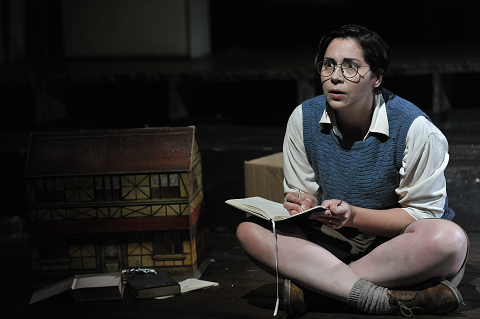 Stephanie Corely. Photo credit: Robbie Jack.
Stephanie Corely. Photo credit: Robbie Jack.
Polly Graham’s production for Independent Opera pulls no punches. It is intense, utterly engaging and all the more impressive for the economical means with which it achieves its ends. The sparse black cube of the Lilian Bayless Studio at Sadler’s Wells is a fitting venue. Designer Nate Gibson’s split-level set recreates the particular while inferring the universal. Crates, cardboard boxes and household debris - including a child’s doll’s house that later is viciously, and symbolically, trampled by a marauding jack-boot - are scattered about a family attic of a war-torn house. Doors to the rear, and a large picture canvas upon which are projected barren vistas and a burning church, evoke a land beyond the attic walls, ravaged by pillage and war. Subsequently, a raised circle strewn with suitcases suggests the extent of the ensuing exile. The painting is up-ended at the start of the third and final scene: this is a world in moral anarchy. Ceri James’ lighting frequently leaves much of the stage in shadow, making the sudden splashes of brightness unsettling interlopers amid the general gloom. James projects menacing lupine silhouettes to press home that Simplicius, in his ignorance, equates his fear of the ‘Wolf’ that preys on the family sheep, with the pillaging soldiers.
At this performance, the third of four, Hartmann’s score was incisively articulated by players from the Britten Sinfonia, who are nestled on the right of the auditorium, clearly visible but snaking their way under the raised curving platform. With the percussion placed towards the rear of the under-stage area, the arsenal of bangs, thumps and clashes bounced with alarming resonance against the platform, creating a disconcerting nerviness.
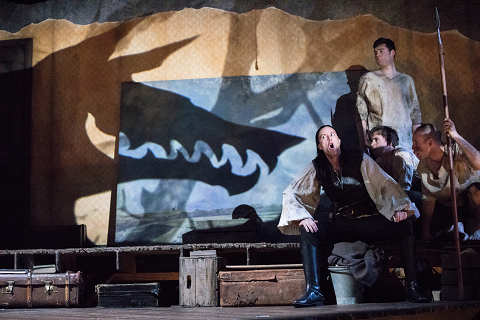 William Dazeley. Photo credit: Max Lacome.
William Dazeley. Photo credit: Max Lacome.
In the long instrumental passages, the music often felt quite balletic, as it shaped the movement and mime. Hartmann’s scenes are essentially tableaux: there is spoken dialogue, declamatory singing and some songs, but these musical numbers illustrate rather than develop the dramatic action.
During the extensive orchestral prelude, Simplicius enters, innocently playing with simple toys, leafing through a book, chewing a sweet treat; a yearning Jewish melody, projected superbly by solo viola then solo cello, signalled the context. The string ensemble was fairly small, and at times a greater richness would have been desirable, but the lean textures and strongly shaped phrases were potent and immediate.
Hartmann’s score is highly allusive; if the overture seems almost an homage to Prokofiev, then Stravinsky, Borodin, Bach, even The Lord’s Prayer, get a look-in subsequently. This production made use of the 1957 revised score, with a few passages of the first version restored and some debt to Karl Peinkofer’s 1976 reduced percussion version. Conductor Timothy Redmond did not let one detail escape.
The palette ranged from Weill-like decadence to honest poignancy, by way of many an acerbic march. Perhaps the populist touches do not quite have Weill’s directness of communication but they make for animated eclecticism. There were moments of pastoralism, as when a flock of sheep rolld in the grass, chewing the cud, to the bucolic hues of a trio for bassoon, clarinet and oboe. The probing string counterpoint which accompanies the Hermit’s oration becomes a mis-harmonised Bach chorale, which Redmond crafted - as the pitch rose, repetitive fluttering motifs were introduced and a powerful accelerando took hold - into a stirring declaration.
Graham makes use of the whole auditorium. The characters - who are to some extent caricatures in the mould of Wozzeck’s parade of grotesques - traverse the two tiers of the set, wander around instrumentalists, enter from rear of arena; it’s disconcerting to find oneself almost face to face with spear-clutching marauders.
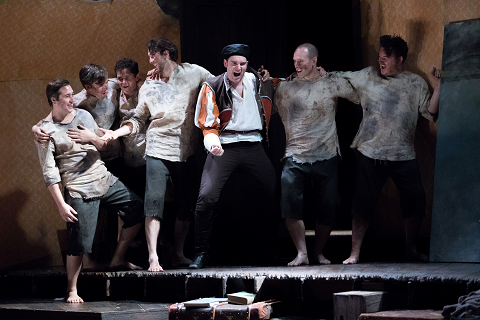 Matthew Durkan and Ensemble. Photo credit: Max Lacome.
Matthew Durkan and Ensemble. Photo credit: Max Lacome.
An ensemble of eight men form a flexible collective. Choreographed deftly by Michael Spencely, they are a flock of sheep, a band of mercenaries, gang rapists, a brigade of Hitler Youth. The Narrator’s opening dialogue is shared between them, and there is a Brechtian quality as they boom their pronouncements from different placements in the auditorium with chilling matter-of-factness: ‘In Anno Domini 1618, 12 million people lived in Germany … In Anno Domini 1848, only 4 million people lived in Germany.’
Stephanie Corley’s Simplicius was the embodiment of unaffected unselfconsciousness. In knee-length breeches and knitted tank-top she was every inch the 1930s school-boy. Corley veered convincingly from despair to ecstasy: her carefree songs, sensitive recitative and impassioned aria-moments were equally compelling. Singing with brightness and lustre, she evoked innocent optimism and candid feeling. Corley’s diction was superb too; indeed, the whole cast ensured that we heard every word of David Pountney’s piquant new translation, and for once the surtitles seemed unnecessary.
Emyr Wyn Jones’ Farmer states the opera’s core maxim, ‘The peasant plays a noble part/ He is the nation’s beating heart’, singing with a rich tone and full vibrato which imbue his words with passion. His pocket was picked by William Dazely’s hard-hearted Soldier, who swaggered arrogantly through Simplicius’s home shredding, if not burning, books, pillaging, razing, and dangling Simplicius by his feet in a painful hand-stand.
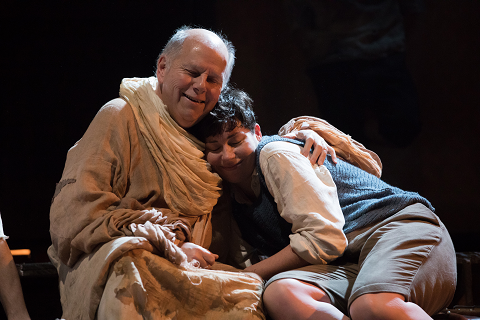 Adrian Thompson and Stephanie Corley. Photo credit: Max Lacome.
Adrian Thompson and Stephanie Corley. Photo credit: Max Lacome.
Adrian Thompson emerged from beneath the platform to give a show-stealing performance as the Hermit. His words of Christian compassion contrast with Simplicius’s unknowing purity of feeling. Singing with impressive steadiness of tone, Thompson grasped every opportunity to project intensity of feeling and the Hermit’s death scene swelled into a visionary oration of fervent spirituality.
So compelling was Thompson that it seemed a pity to insert an interval between the second and third scenes, thereby breaking the mood established by Thompson and Corley in the Hermit’s dying moments before the increasingly brutal final episode that sees Chiara Vinci as the Woman (a silent role) abused and raped. The words ‘Fornication … is a woman’s occupation’ mock her anguish unnervingly.
Marc le Brocq was garish and ghastly as the repugnant Governor, ridiculously conceited in salmon-pink doublet and white tights, terrifyingly deranged as he devoured the strips of meat lain across the Woman’s bare back and breasts with bestial relish: her flesh is meat, she is an animal - ‘This lady is a monkey’. Tristan Hambleton’s Sergeant and Matthew Durkan’s Captain ably completed the portraits of nastiness.
The closing moments raged as the unison ensemble, accompanied by violent percussion, bellowed a revolutionary song and the shocking facts which opened the opera were restated. By this point, we had witnessed a terrible history re-lived, and its images were hard to shake off as one left the theatre.
Claire Seymour
Simplicius - Stephanie Corley, Farmer - Emyr Wyn Jones, Soldier - William Dazely, Hermit - Adrian Thompson, Sergeant - Tristan Hambleton, Governor - Mark Le Brocq, Captain - Matthew Durkan, The Woman - Chiara Vinci, Ensemble (Tristan Hambleton, Emyr Wyn Jones, Nicholas Morris, Nicholas Morton, Bradley Smith, Adam Sullivan, Andrew Tipple, James Way); Director - Polly Graham, Conductor - Timothy Redmond, Designer - Nate Gibson, Light Designer - Ceri James, Projection Designer - Will Duke, Choreographer - Michael Spenceley, Britten Sinfonia.
Lilian Bayliss Studio, Sadler’s Wells, London; Thursday 17th November 2016.
image=http://www.operatoday.com/Mark%20Le%20Brocq%2C%20Stephanie%20Corley.%20c.%20Robbie%20Jack.png image_description=Simplicius Simplicissimus, Independent Opera at Sadler’s Wells product=yes product_title=Simplicius Simplicissimus, Independent Opera at Sadler’s Wells product_by=A review by Claire Seymour product_id=Above: Mark Le Brocq (Governor) and Stephanie Corley (Simplicius)
Photo credit: Robbie Jack
November 17, 2016
2017 Summer Festival at Lucerne
Who am I? The issue of identity illuminates the human condition in the present and through history in its relation to origin, homeland, faith, culture, and religion. How did we become the people we are? And how are we changed by our current environment? Paradigmatic answers to these questions can be found in the fates of such composers as Béla Bartók, Gustav Mahler, Sergei Prokofiev, and Dmitri Shostakovich. But they also come up in general for every musician involved in the international concert scene. Like nomads they travel around the world, performing today in New York and tomorrow in Tokyo. And the issue of identity is highly controversial, as we see in the case of refugees who are coming to Europe from war zones and who have to choose between the desire to integrate and the preservation of what is uniquely their own.
Click here for complete press release.
Lucia di Lammermoor at Lyric Opera of Chicago
The title role is performed by Albina Shagimuratova, who sang an excerpt from this opera at Millennium Park, Chicago several seasons ago. Lucia’s beloved Edgardo di Ravenswood is sung by Piotr Beczała and her brother, Lord Enrico Ashton, by Quinn Kelsey. A major company debut is scored by Adrian Sâmpetrean in the role of Raimondo, the chaplain and tutor to Lucia. The parts of Alisa, Normanno, and Lord Arturo Bucklaw are performed by Lindsay Metzger, Matthew DiBattista, and Jonathan Johnson. Enrique Mazzola makes his debut conducting these performances and the Chorus Master is Michael Black.
During the overture a plaid scrim, emphasizing Scottish family clans, covers the stage. The title of the opera appears in blood-red script at the base of the scrim. Slow tempi encouraged at first by Mr. Mazzola allow for an appreciation of orchestral detail and contrast which commences at the moment that characters begin to interact. Staged concepts are displayed in this production by means of a series of horizontal and vertical moving panels. In the first scene Normanno and his band of henchmen search fruitlessly through the stylized heather for evidence of an intruder on the Ashton lands. The entrance of Enrico and Raimondo identifies the suspected culprit as Edgardo di Ravenswood, enemy to Enrico and secret lover of the latter’s sister Lucia. The bright, excited projection of accusations by Mr. DiBattista’s Normanno gives fire to the troubled soul of Enrico. Mr. Kelsey embodies here the spirit of his self-descriptive line, “Io fremo” [“I seethe with rage”]. Throughout the balance of the scene Kelsey unleashes his lines with dramatic force, often giving preference to declamatory emphasis over a traditional bel canto line. His performance of “Cruda, funesta smania” [“Cruel, baneful torment”] exemplifies this approach to the character of Enrico. While incorporating some notable embellishments in the aria, he uses a dominant forte approach to various lines such as “amor sì perfido” [“such a perfidious love”]. Once the suspicion of Edgardo’s identity is indeed confirmed by the searching chorus, Raimondo makes the case for Lucia’s innocence. Already in this brief exchange Mr. Sâmpetrean demonstrates an admirably flexible, rich bass voice which he uses to good effect in character delineation. Enrico’s reaction to the news of Lucia’s suitor intensifies an earlier fury, shown here by Kelsey’s performance of the cabaletta “La pietade in suo favore” [“compassion for her”] with unrelenting determination.
The following scenes of the act introduce Lucia, her confidante Alisa, and Edgardo. The heroine’s initial aria, “Regnava nel silenzio” [“Ruled (the night) enveloped in silence”], is performed by Ms. Shagimuratova with careful shaping and a firm sense for legato; her narration of Lucia’s vision at the fountain matches the apprehension of the heroine with a tentative, dramatic approach. In the second piece, “Quando rapito in estasi” [“When enraptured, ecstatic”], as Lucia’s misgivings yield to the joy of her lover’s projected arrival, Shagimuratova incorporates florid decoration, an effective diminuendo, and at least the suggestion of a trill. Her interaction with Ms. Metzger’s supportive Alisa prepares for the emotional reception of Edgardo. When Mr. Beczała appears, sporting a contrasting red tartan, he states with forthright conviction his plan to leave the “patrie” by morning. Beczała’s emotional reaction to Lucia’s fear is here believably expressed by his forte pitches “il sangue mio” [“my blood”] and the chill with which he invests “m’odi e trema” [“listen to me and tremble”]. Although Edgardo must narrate here the conflict engendered by his father’s murder with his present love, Beczała does not depart from a lyrical flow. His continued urging leads to the mutual spousal vows and the exchange of rings. The duet “Verranno a te” [“(my sighs) will come to you”] is in these performances a vocal highpoint of the act with both singers moving from piano tenderness to heartfelt avowal of their affection before parting.
In Act II Enrico, Lucia, and Raimondo interact in several key scenes leading to the heroine’s subsequent transformation. In the first of these the production emphasizes the familial split by means of panels: Enrico is seated at his desk in the company of Normanno, while Lucia appears simultaneously in the garden outdoors next to the moonlit gnarled tree where she had earlier met her lover. Enrico’s troubled spirit is given an appropriately brooding release by Kelsey, who summarizes in a breathless flow the family’s precarious standing. Once he dispatches Normanno to carry out the plans for a wedding, Lucia is escorted into his writing chamber. The line “Appressati, Lucia” [“Come nearer, Lucia”] is uttered by Kelsey with a snake’s duplicity as he tries to reason with the young girl who already shows the librettist Cammarano’s “sintomi d’una alienazione mentale” [“signs of madness”]. Lucia sits stiffly in a period chair and refuses to consider her brother’s coaxing to save the family by marrying Lord Arturo Bucklaw. Once she is shown a forged letter written allegedly by her Edgardo, the girl is weakened further by the presumption of her lover’s inconstancy. As Kelsey comforts Lucia with an embrace, here both kneeling together, he rationalizes her “folle … perfido amore” [“foolish perfidious love”] with a strong sense of melodic line. In their duet, “Se tradirmi tu potrai” [“If you can betray me”] Shagimuratova displays excited vocalism yet begins to yield symbolically to Enrico by allowing him here to dominate their concluding lines. This shift is reinforced in Lucia’s subsequent duet with Raimondo. In this scene Mr. Sâmpetrean truly shines in his aria, “Ah, cedi, cedi!” [“Ah, relent!”], in which he uses carefully wrought embellishments in a progressively rising line as a means of convincing Lucia to yield to Enrico’s plan. Equally impressive are Sâmpetrean’s secure, lower register and his varied technique in the piece “Oh! qual gioia!” [“Oh, what joy!”] while he celebrates Lucia’s agreement.
At the start of the following scene the chorus welcomes Arturo Bucklaw as the savior of the troubled Ashton household. In his brief aria “Per poco fra le tenebre” [“For a short time in the darkness”] Mr. Johnson’s Arturo addresses Enrico with assurances for the future. Johnson’s attractive technique incorporates elegant legato phrasing and high pitches securely fixed to the significant line “amico, fratello e difensor” [“friend, brother, and protector”], all of which he swears to become. As soon as the document is signed, with still notable resistance by Lucia, her lover Edgardo bursts into the room. The renowned sextet as highlight toward the close of the act is here well blocked, such that individual performers are distinctly heard yet all blend sonorously in passages where vocal lines converge. Afterward, Mr. Beczała’s effective cry of “Maledetto sia l’istante” [“Cursed be the moment”], his judgement against Lucia’s presumed treachery, returns the act to a level of tension even higher than earlier.
The four vocal scenes of the final act are a direct result of this inflamed spirit of enmity and continued misunderstanding. At first Edgardo and Enrico face each other at Wolf’s Crag, estate of the unhappy lover. Although Enrico has sealed the marriage of his sister, his heart yet thirsts for revenge, “La vendetta mi parlava!” While each defends his family’s position, the two men agree to a duel at dawn. In their duet Kelsey returns to a dramatically rough edge to underscore vocally his character’s intent for the present, whereas Beczała’s flights into lyrical ardor latch more emotionally onto his father’s memory.
The following scene begins as celebration and ends with tragic consequences. At first the chorus dances and sings in jubilation at Lucia’s wedding; they are interrupted by Raimondo announcing tragedy from the bridal chamber, that Lucia has murdered her husband. In his aria “Dalle stanze ove Lucia” [“From the rooms where Lucia”] Sâmpetrean enunciates “quelle mura” [“into the chamber”] with quiet dignity as though in sympathy with a higher power. His imitation of Lucia’s query for her husband shifts to a confused intonation with a deeply rolled -rr- as he describes her demented smile [“un sorriso balenò”]. When joined by the chorus in praying for forgiveness from “heaven’s” wrath, Sâmpetrean holds an extended pitch on “ciel” long after the choral expression of shock subsides.
The following mad scene shows Shagimuratova at her best of this performance. With a face tinted white to emphasize her “pallor,” she incorporates multiple embellishments to illustrate the current deranged state of her character’s persona. Glides drifting upward, scales and roulades performed flawlessly, and individual pitches taken flat or sustained are a credible appeal to the “ciel clemente” [“merciful heaven”] where her delusion seeks happiness. The pendant to this magnificent vocal display is sung by Beczała in the final scene. He gives an equally virtuosic account of “Fra poco a me ricovero” [“Soon refuge for me”], where he modulates his voice to accommodate accusation with an ultimate tone of forgiveness. When Raimondo announces Lucia’s death, “È in cielo” [“She is in heaven”] with a flawless melisma on the final word, Edgardo can wait no longer. Perhaps the reaction to Lucia’s death before his own suicide is best expressed here by his coloring of the phrase “sì crude guerra” [“such cruel agony”] to describe the ultimate effect of selfish human strife on the most innocent of loves.
Lyric Opera is to be congratulated for assembling such a premiere cast to give a fresh interpretation to a repertoire staple.
Salvatore Calomino
image=http://www.operatoday.com/lucia-article-card.png
image_description=Albina Shagimuratova as Lucia [Photo courtesy of Lyric Opera of Chicago]
product=yes
product_title=Lucia di Lammermoor at Lyric Opera of Chicago
product_by=A review by Salvatore Calomino
product_id=Above: Albina Shagimuratova as Lucia [Photo courtesy of Lyric Opera of Chicago]
Akhnaten Offers L A Operagoers Both Ear and Eye Candy
Akhnaten or Akhenaten as his name is sometimes written, ruled Egypt for seventeen years, from a date near 1351 to a date near 1334 BCE. He and his queen, Nefertiti, were part of the eighteenth dynasty. Because composer Philip Glass and his librettists were researching so far back into history to tell his story, they could not answer many of the questions about events in his life. Thus, the opera is not historical. It is inspirational. Akhnaten tried to change his country’s religion from polytheism to a quasi-monotheism in which the Sun God ranked above all others.
On Saturday November 5, 2016, Los Angeles Opera presented the American premiere of Phelim McDermott’s spectacular production of Akhnaten, which had already been seen at English National Opera. Countertenor Anthony Roth Costanzo was a perfect fit for the role of the religiously inclined pharaoh. Head shaven and body waxed, he looked the part of a magnificent ruler, and his clear, soaring tones were as smooth as freshly ironed silk. He seemed to produce his strong voice easily and he was not tired at the end of this very long role. Akhnaten was onstage almost all the time.
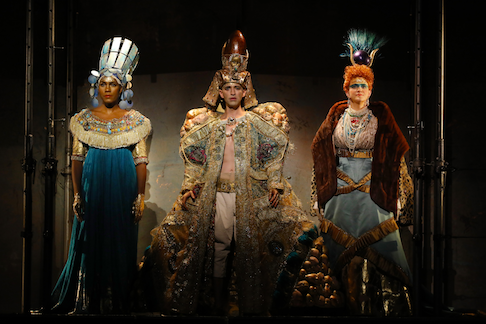 J'Nai Bridges as Nefertiti, Anthony Roth Costanzo as Akhnaten and Stacey Tappan as Queen Tye
J'Nai Bridges as Nefertiti, Anthony Roth Costanzo as Akhnaten and Stacey Tappan as Queen Tye
McDermott’s staging was close to choreography because it demanded a great many slow, meditative, ritualistic movements from the principals. In contrast, there were quick motions from the excellent jugglers in the background who never dropped an object until the last act when they did it for effect. Juggling is thought to have been a part of palace life in ancient Egypt since it is seen in a tomb painting from four thousand years ago. Designer Tom Pye's solid three-story stage construction allowed both the actions showing the pharaoh’s slow story and the visual counterpoint of the juggling to be seen at once. His costumes portrayed the riches of Egypt’s royalty in jewel tones, exquisitely woven transparencies, and enormous trains.
The name Nefertiti means “a beautiful woman has come.” Contralto J’nai Bridges was a gorgeous Nefertiti as she sang the part of the consort who gave meaning to Akhnaten’s life. She added lower harmony to his singing as she completed his image. Bass Zachary James was the Scribe who narrated the story in English. Glass made a point of having that character sing in the language of the audience since there are no titles for this opera. I would have liked titles for the material sung in Ancient Egyptian, Hebrew, and Akkadian, but the composer preferred to give listeners the feeling of the ancient world rather than an actual text. Not only were there no English titles, I could not find any material in Spanish in the program.
The soprano with the opera's top vocal line line was Stacey Tappan as Akhnaten’ mother, Queen Tye. Probably the most loving stage mother-in-law, she sang with clear legato tones and never caused friction between the lovers. On with the other hand, Nefertiti’s father, Aye, sung by Patrick Blackwell, fanned the flames of the old religion. A stalwart bass-baritone, Blackwell’s sound was easily heard above the chorus that often surrounded him.
Korean baritone Kihun Yoon sang with a robust sound as the self-important heir-to-the-throne, Horemhab, who would eventually bring back the old polytheism and allow Akhnaten to be designated a heretic. Frederick Ballentine was the evil High Priest who plotted Akhnaten’s downfall. Akhnaten’s six beautiful daughters provided gorgeous harmonies in the final act. Coloratura soprano So Young Park, lyric sopranos Summer Hassan and Elizabeth Zharoff, mezzos Michelle Siemens and Michelle Hemmings, together with contralto Sharmay Musacchio formed a notable sextet of graceful voices that lightened the mood of the otherwise somber final act.
Chorus Director Grant Gershon’s group sang with spirit and considerable exuberance. Conductor Matthew Aucoin, LA Opera’s new artist-in-residence, led a dark sounding accompaniment to a vital and exciting performance. In his orchestration of the piece, Glass chose to leave out the usual top line of a score, violins, and that omission gave the accompaniment an unusual sound. Aucoin’s rendition of the score was vital, translucent and beautifully detailed. Akhnaten is a show-stopping modern opera and the Los Angeles audience loved it.
Maria Nockin
Cast and production information:
Conductor, Matthew Aucoin; Director, Phelim McDermott; Set Designer, Tom Pye; Costume Designer, Kevin Pollard; Lighting Deigner, Bruno Poet; Chorus Director, Grant Gershon; Juggling Choreographer, Sean Gandini; Assistant Director, Trevor Ross;
Akhnaten, pharaoh of Egypt, Anthony Roth Costanzo; Nefertiti, his wife, J’nai Bridges; Queen Tye, his mother, Stacy Tappan; Horemhab, general and future pharaoh, Kihun Yoon; Aye, Nefertiti’s father and advisor to the pharaoh, Patrick Blackwell; High Priest of Amon, Frederick Ballentine; Scribe, Zachary James; Daughters of Akhnetan, So Young Park, Summer Hassan, Elizabeth Zharoff, Michelle Siemens, Michelle Hemmings, and Sharmay Musacchio.
image=http://www.operatoday.com/16203-156.png
image_description=Anthony Roth Costanzo in the title role of "Akhnaten." (Photo: Craig T. Mathew / LA Opera)
product=yes
product_title=Akhnaten Offers L A Operagoers Both Ear and Eye Candy
product_by=A review by Maria Nockin
product_id=Above: Anthony Roth Costanzo in the title role of Akhnaten
Photos by Craig T. Mathew / LA Opera
Shakespeare in the Late Baroque - Bampton Classical Opera
Fairies, nature spirits and the supernatural inspired the transition between the orderliness of the Enlightenment and the wild, revolutionary spirit of the Romantic Age. This delightful yet thoughtful concert from Bampton Classical Opera contrasted two pieces, both from 1776: Thomas Linley's Ode on the Spirits of Shakespeare and Georg Anton Benda's Romeo and Juliet, showing how two very different composers responded to Shakespeare in their own, original ways.
Georg Anton Benda (1722-1795) was a member of a family well-connected to the German musical establishment. His Romeo und Julie was a three-act "ernsthafte Oper" a Singspiele with prose text by Friedrich Wilhelm Gotter, who also adapted The Tempest. Benda and Gotter subscribed to the principles of classical antiquity as perceived in their time, dramatic values that predicated on the unity of time, action and place. Thus Shakespeare's Romeo and Juliet was pared down, Benda's Romeo und Juliet focusing on the key characters. Bampton Classical Opera presented a half-hour version of Benda's original, revolving around Juliet (Clare Lloyd-Griffiths) and Romeo (Thomas Herford). Laura (Caroline Kennedy) duets with Juliet, and a single Capulet (Richard Latham) stands in for the feuding families. The choruses (as in Greek drama), sung by Cantandum, thus provide backdrop and commentary. Lloyd-Griffiths, substituting at short notice for Rosalind Coad, was very well cast. She has an attractive, bright timbre that captures Juliet's youth and purity. In the recit and aria, Juliet is already contemplating death "I am trembling with such joy and with such fear....See, the moon turns pale...."
Thomas Linley (1756-1778) was part of the English theatrical and artistic establishment. His father was a famous actor; his sister, also an actress, was a muse of Thomas Gainsborough and married Richard Brinsley Sheridan. Unfortunately Linley died so young that part of his mystique rests on what he might have been had he matured. Linley's A Lyric Ode on the Fairies, Aerial Beings and Witches of Shakespeare adapts a text by his teenage schoolmate, who also died young. Its hyberbolic exaggeration thus represent the enthusiasm of youth. The Spirit of Avon (Clare Lloyd-Griffiths) and Fancy (Caroline Kennedy) are memes in an allegory, not fleshed out-personalities as in Shakespeare or, indeed, most opera.
Linley's Ode began with an overture, very much in a formal style, but more salon piece than Handelian public opera. Gilly French conducted the Bampton Classical Players, on period instruments including harpsichord, with antique horns and trumpets, positioned at each side of the stage. The Englishness of the aesthetic came over well. "O guardian of that sacred land, where Avon's wood-crowned waters stray" sang the chorus. Though the Avon in question would be Stratford-on-Avon, as there are references too to Arden, it may or may not be significant that the Linleys had connections with the Avon of Bath and Bristol. Thus the Spirit of Avon (Lloyd-Griffiths) addresses Greek deities advising them that "Shakespeare now demands your lays" As the Spirit of Avon, Lloyd-Griffiths had more with which to demonstrate her range. Lloyd-Griffiths is also interesting because she's very English, (though she may be Welsh) and The Spirit of Avon is a kind of Britannia. English sopranos are a distinct Fach, an aesthetic that's much under-appreciated. Lloyd-Griffiths reminds me of Lucy Crowe. Caroline Kennedy, as Fancy, also has a bigger part, and used it well. Although the mood in the First Part of Linley's Ode glorifies Shakespeare's birth like a divine act (witnessed by Jove himself), darker mysteries creep in. What to make of the "sordid wishes of the grov'ling crowd that chain the free-born mind"?
In Part II of Linley's Ode, the Fearful Observer (Richard Latham) sings of the id-like world of the night where "with feeble cries the gliding spectres throng". Linley responds to these sinister images with vividly dramatic figures, even spookier because they're conjured up with small ensemble and the timbre of period instrumentation. French and her orchestra rose to the occasion, playing with animated vigour. But dawn breaks, and spells are broken. The Spirit of Avon announces peace, since these horrors were created by Shakespeare's art. "For who can wield like Shakespeare's skilful hand, that magic wand, whose potent sway the elves of earth,of air, of sea obey?" Yet Linley's not just looking back. He sets the final lines with mischevious glee: "Oh, give another Shakespeare to our Isle".
Anne Ozorio
image=https://upload.wikimedia.org/wikipedia/commons/thumb/6/6d/Linleyyounger.jpg/280px-Linleyyounger.jpg
image_description=Thomas Linley the Younger
product=yes
product_title= Georg Anton Benda Romeo and Juliet, Thomas Linley A Lyric Ode on the Fairies, Aerial Beings and Witches of Shakespeare Bampton Classical Opera, conductor Gilly French, John's Smith Square, 11 November 2016
product_by=A review by Anne Ozorio
product_id=
November 16, 2016
Soldier Songs in San Diego
Upon entering the theater, the audience was greeted by low rumbling sounds that erupted into soft-edged explosions every few minutes. It was somewhat unnerving as it continued unabated until the presentation began, but the idea was to give the incoming audience a tiny taste of what it is like to be in a war zone. The mood didn’t get any lighter when Director Tomer Zvulun and design group GLMMR began to show a verismo version of the three stages of a soldier’s life.
In Stage One, the child, acted by Ryan Singer, plays with guns and video games. He enjoys chasing other children with guns. Children chant slogans about killing people with strange clothes and funny names. Video games simulate war and the child onstage thinks going to war is very much like playing a video game. The finality of death has completely escaped the youngster.
In Stage two, the child has grown up and enlisted in the military. Played by David Adam Moore, the Soldier sang with strong virile tones and excellent diction. In this presentation all the music was amplified in Garth MacAleavey’s sound design. There were titles in case anyone missed a word, but they were not altogether necessary.
After enlisting, the Soldier learned some hard truths: Getting shot hurts and soldiers actually die in combat. Casualties of war don’t get up and go home in the way that those shot down in video games or children’s stories do. Only when the soldier saw a mutilated body lying on the ground before him, did he begin to understand what war could do to the warrior. Then, he began to realize that he might be maimed and return home disabled or that he might lose his life and return in a coffin.
In Stage Three, actor Dan Denison showed the audience some of the thoughts of veterans who were lucky enough to have returned home. Contemplating what soldiering had done to them, they found they had trouble talking about their overseas experiences with people who had not been to war. Later, members of the "Talk Back" Panel noted that some veterans have had more trouble reintegrating into American society than others. Unfortunately, returnees who need psychological services may be embarrassed to ask for them. It’s sad to see that some veterans do not learn to cope with life in the United States and end up homeless.
The woman veteran on the "Talk Back" Panel said rejoining normal life in the States was harder for women because military trainers negated much of what girls had been taught growing up. As a child, she had been taught to nurture but as an adult she had learned to join in doing harm. Coming home she was again expected to be nurturing rather than aggressive, and it did not come easily. In business, for example, we expect men to be much more aggressive than women.
In Soldier Songs David Little combined the sounds of far off artillery and percussion with flute, violin, cello, clarinet, and piano. Conductor Steven Schick, a renowned percussionist, is well known for his performances of contemporary music. He paid a great deal of attention to detail and gave an impressive rendition of this unusual score.
Soldier Songs is not for the faint of heart. It takes the audience into war-like situations and shows the average American who has never seen a war zone what some soldiers have to endure. It also points out the lack of understanding many parents and children have regarding the difference between playing violent games and actual violence. High school youngsters, in particular, need to know what the dangers of war are for those who join the military. I think performances of Soldier Songs in San Diego did a great deal to bridge the gaps between soldier, veteran, and civilian.
Maria Nockin
Cast and production information:
Cast and Production Information:
Soldier, David Adam Moore; Child, Ryan Singer; Elder Man, Dan Denison; Conductor, Steven Schick; Director Tomer Zvulun; Production Design, GLMMR: David Adam Moore, Victoria “Vita” Tzykun; Lighting Designer, Maxwell Bowman; Sound Designer, Garth MacAleavey; Supertitles Coordinator, Charles Arthur; San Diego Symphony: Violin, Wesley Precourt; Cello, Chia-Ling Chien; Flute, Erica Peel; Clarinet, Frank Renk; Percussion, Erin Douglas Dowrey and Andrew Watkins; Piano M. Barranger.
image=http://www.operatoday.com/Soldier_Nockin.png
product=yes
product_title=San Diego Opera's Shiley dētour Series presents Soldier Songs
product_by=A review by Maria Nockin
product_id=Above: Baritone David Adam Moore is the Soldier [Photo courtesy of San Diego Opera, copyright Karli Cadel]
Baritone David Adam Moore is the Soldier in San Diego Opera's SOLDIER SONGS. November, 2016. Photo copyright Karli Cadel.
Barber of Seville [Hollywood Style] in Los Angeles
The Ebell Club in the Highland Park area of Los Angeles has a modest sized hall in which Pacific Opera Project (POP) often presents opera. The atmosphere is casual and the audience is usually seated at tables eating hors d’oeuvres and drinking wine. Music Director Stephen Karr sees to it that the music is taken seriously and Artistic Director Josh Shaw makes sure the action and the English supertitles keep their 2016 audience entertained.
Stage Director Josh Shaw designed the sets, which showed Rosina’s balcony, Bartolo’s living room, and Figaro’s shop. He had some short scenes played in front of a curtain. Above the stage were not only English titles but also videos and notes regaling the characters’ Hollywood exploits.
Figaro, Bernardo Bermudez, was the hairdresser who could always find his clients clean samples of hair or anything else needed to pass a drug test. His Figaro was so amusing that he almost distracted the audience from his robust singing. As his servant, Fiorello, Kevin Blickfeldt was a rollocking misfit.
Rosina, mezzo-soprano Meagan Martin, was a lovely young starlet who was anything but innocent, as she proved by the stripper-pole choreography she danced while singing “Una voce poco fa.” She sang with a small but sweet sound that was even all the way up and down her wide range.
The main character in this production, however, was Lindoro, sung by coloratura tenor Sergio Gonzalez. His well-focused sound made his virile voice sound larger than it actually was. New on the scene, he has an attractive tonal quality and a good sense of comic timing. Thus, he made an amusing drunk and a hilarious, bewigged “lady” music teacher. Don Bartolo, portrayed by bass-baritone E. Scott Levin, was Rosina’s leering manager who wanted her--and the money she could earn--for himself. The fall guy in this opera, Levin is an old friend to POP. We remember his riotous interpretation of Maestro Biscoma Strappaviscere in Donizetti’s Viva la Mamma.
Basilio, sung by bass Phil Meyer, was once the skin-tight leopard-print-pants-wearing lead singer of the famous group, Aluminum Blymp. At this point, however, he is a caustic-tongued music teacher who loves getting high on cocaine. He sang with a dark sound while spewing calumnies with comic touches. Although singing the comprimario role of Berta in this presentation, Melinda Ehrlich is a fine soprano who has sung leading roles with local companies and will be Juliet in the Center stage production of Romeo and Juliet. She added a strong top line to the ensembles. Wearing the shortest possible pants, Keystone cop wannabe Christopher Anderson-West’s Sergeant fainted when confronted with true nobility and he made the end of the opera turn out right.
For the better part of three hours the Ebell Club audience smiled, tittered, and guffawed at the antics of this talented cast. At the beginning of this review I mentioned that the music was always rendered with the utmost serious attention to detail. POP usually has a small orchestra, but this time Music Director Stephen Karr and Assistant Conductor Zach Neufeld played a knuckle-busting piano four hands version of Rossini’s intricate score that captured almost all of the original sonorities. The titles said the arrangement was by Arnold Schoenberg, but Karr and Neufeld hit the right keys and their music sounded just like unadulterated Rossini! This was a fun production that profited from the intimacy and casual ambience of the setting.
Maria Nockin
Cast and production information:
Cast and Production Information:
Music Director, Stephen Karr; Director and Designer, Josh Shaw; Costume Designer, Maggie Green; Assistant Conductor, Zach Neufeld; Figaro, Bernardo Bermudez; Count Almaviva, Sergio Gonzalez; Don Basilio, Phil Meyer; Fiorello, Kevin Blickfeldt; Rosina, Meagan Martin; Don Bartolo, E. Scott Levin; Berta, Melinda Ehrlich; Sergeant, Chris Anderson-West; Chorus: William Grundler, John David Wiese, and Matthew Ian Welch.
image=http://www.operatoday.com/Barber_Nocklin.png
product=yes
product_title=Pacific Opera Project: The Barber of Seville, Hollywood style
product_by=A review by Michael Milenski
product_id=Above: Bartolo checks out the Music Teacher. [Photo courtesy of Pacific Opera Project, copyright Martha Benedict]
November 15, 2016
Madama Butterfly in San Francisco
The Madama Butterfly of Armenian soprano Lianna Haroutounian may well become recognized as the Butterfly of our time, indeed one of the great Butterflies of all times. It is a role she is just now assuming, thus it is fresh in her voice, mind and body. This freshness makes these performances here in San Francisco unique, an experience not to be missed by operatic lepidopterists — and aren’t we all?
Mlle. Haroutounian arrived at Paris Opera’s young artist program through Moscow, and achieved immediate successes as many of the major Verdi heroines. In 2014 she was miscast as Tosca in San Francisco, a fine singer but simply not the diva Tosca is and must be — in voice and persona.
Mlle. Haroutounian still does not exude the complexities of a diva and this brings the sheen of innocence to her Butterfly that makes it operatically true. The purity of voice that casts her as the unstained Verdi heroine, and the security of her vocal technique sustain the youth and stamina of the 18-year-old Butterfly. The strength and beauty of tone throughout the role’s range underscore the moral certitude of this simple and courageous geisha.
The excited Saturday night audience understood and felt the gravity of Butterfly’s strength and innocence, and awarded Mlle. Haroutounian an ovation the size of which I have never before witnessed in the War Memorial Opera House.
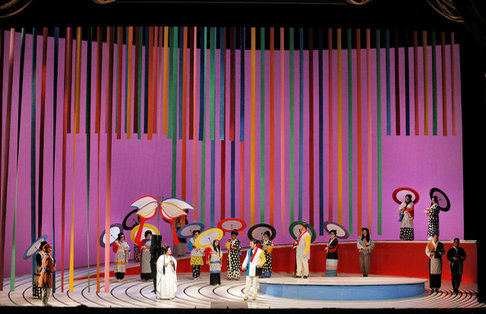 Act I meeting of Butterfly and Pinkerton
Act I meeting of Butterfly and Pinkerton
The production was a remount of the 2006 Jun Kaneko Opera Omaha production first seen here in 2014. The production is simply a masterpiece. It is/can be pure gesamtkunstwerk — the effective if unlikely synthesis of op art with Puccini’s verismo score. The contradiction of these polar opposite styles relies on a sympathetic rhythm of parallel emotional flows to unite the abstractions of sound with the abstractions of shape. It was perfection in 2014 when the Nicola Luisotti fleetness of musical soul melded with the force of shape and delicacy of movement of the Jun Kaneko colors and images.
Canadian conductor Yves Abel conducts nine of these ten performances. Evidently smitten by the emotional force of Mlle. Haroutounian’s Butterfly he editorialized on the tragedy with volume and bombast. While Mlle. Haroutounian could sail above this much of the rest of the cast could not. Conductor Abel added dramatic pauses (silences) that were annoying, annoying long and confusing — even to the diva.
The actual staging of the singers was once again entrusted to the production’s original director, Leslie Swackhamer, a Seattle based advocate for women playwrights. The production having traveled throughout the U.S. over the past ten years has given Mme. Swackhamer much experience. In this edition Trouble remained on the stage for too much of the second act wrenching focus from Butterfly and Suzuki. Otherwise her staging was without reproach.
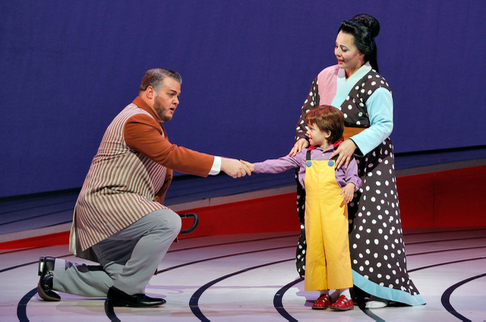 Anthony Clark Evans as Sharpless, Trouble, Lianna Haroutounian as Butterfly
Anthony Clark Evans as Sharpless, Trouble, Lianna Haroutounian as Butterfly
Sharpless was sung by Lyric Opera of Chicago’s Anthony Clark Evans who despite obvious youth succeeded in bringing a deeply felt gravitas to this sympathetic bureaucrat. Mr. Evans possesses a voice of very great beauty he used with intelligence. He moved with a dramatic purpose that did not require the cane he was given, evidently to simulate age.
Pinkerton was sung by young Italian tenor Vincenzo Costanzo who has few if any of the traits of the Italian tenor. The punctuation of such stylistic mannerisms were sorely needed to balance the sheer size of the diva’s performance — the character of a Pinkerton was not vocally etched with sufficient strength to motivate the depths of their joint tragedies.
Yamadori, Butterfly’s ridiculous, old suitor was impersonated by Adler Fellow Edward Nelson who read as about nineteen years old. A lithe, handsome presence he delivered his few lines with elegance, confusing us by presenting a quite presentable, maybe preferable alternative to Pinkerton. Suzuki was sung by Adler Fellow Zanda Švēde. This fine, young singer brought an inappropriate, strongly athletic presence to Butterfly’s passive, compassionate companion, further compromised by a weird, unattractive wig. Goro was sung by Korean born Julius Ahn who contributed a light weight verisimilitude to the role, gratuitous under the circumstance. The Bonze was professionally delivered by Raymond Aceto.
Over the years this splendid production has been seen in many, many cities throughout the U.S., a monument to the high art that can be achieved in American opera. However, in addition to the questionable casting and conducting, the curved background scrim was not carefully stretched, further compromising the integrity of the Jun Kaneko production here in San Francisco.
Michael Milenski
Cast and production information:
Cio-Cio-San: Lianna Haroutounian; Lt. B. F. Pinkerton: Vincenzo Costanzo; Suzuki: Zanda Švēde; Goro: Julius Ahn; Sharpless: Anthony Clark Evans; Prince Yamadori: Edward Nelson; The Bonze: Raymond Aceto; Imperial Commisioner: Matthew Stump;
Kate Pinkerton: Julie Adams; Official Registrat: Jere Torkelsen. San Francisco Opera Chorus and Orchestra. Conductor: Yves Abel; Director: Leslie Swackhamer; Production Designer: Jun Kaneko; Lighting Designer: Gary Marder. War Memorial Opera House, San Francisco, November 12, 2016.
image=http://www.operatoday.com/Butterfly1_SF3.png
product=yes
product_title=Madama Butterfly in San Francisco
product_by=A review by Michael Milenski
product_id=Above: Lianna Haroutounian as Butterfly [All photos copyright Cory Weaver, courtesy of San Francisco Opera]
November 13, 2016
Kiss Me, Kate: Welsh National Opera at the Birmingham Hippodrome
Moving forward fifty-two years, we find ourselves in the 400th year since Shakespeare’s death, a landmark which has been celebrated by such a multitude of cultural events and creations that one might be forgiven for feeling weary resignation when the company of the fictional Barre Players cry “Another op’nin’, another show!” at the start of Porter’s 1948 musical. But, as Porter’s imagined thespians, led by Landi Orshinowo’s irrepressible Hattie, rehearse for a new production of The Taming of the Shrew at the Ford Theatre, Baltimore, the toe-tapping magic of Welsh National Opera’s production is infectious and any sense of Shakespeare-surfeit slips speedily away.
Jo Davies’ production first saw the light of day at Opera North last year, and some of the cast reprise their roles; but the show is a perfect complement to Verdi’s Macbeth and André Tchaikowsky’s new opera The Merchant of Venice with which it forms a Shakespeare-triptych for this autumn’s touring programme.
Porter gives us a classic ‘play within a play’. As the Barre Players are presenting an adaptation of Shakespeare’s The Taming of the Shrew, life and theatre, love and drama become entangled. The device provides a commentary on life in the theatre: taming the shrew is as difficult as curing a budding star of limelight lust. The form also provides a context for the central pair of divorced-but-not-detached artistes, Fred Baker and Lilli Vanessi, who engage in sexual warfare to rival that of Shakespeare’s shrewish Katharine and fortune-seeker Petruchio.
From the opening number, choreographer Will Tuckett’s mastery of the busy, crowded stage is evident. Soloists come to the fore, small choral groups form and disperse, dancers whirl, stage-props are manoeuvred. The business is slick, as Tuckett inventively martials the diverse forces. Throughout, the elaborate stage routines are polished, the complicated manoeuvres deceptively effortless. The chorus blocking is superb, the resourceful choreography giving the contrasting tableaux great presence and power.
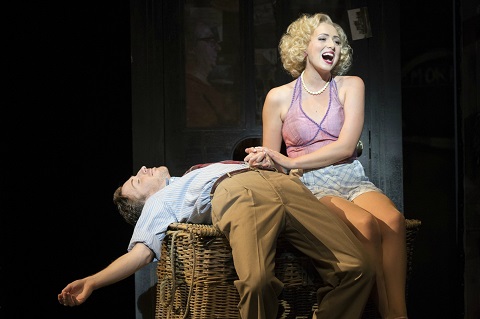 Alan Burkitt (Bill Calhoun/Lucentio) and Amelia Adams-Pearce (Lois Lane/Bianca). Photo credit: Richard Hubert Smith.
Alan Burkitt (Bill Calhoun/Lucentio) and Amelia Adams-Pearce (Lois Lane/Bianca). Photo credit: Richard Hubert Smith.
The design is just as suave and beguiling. Colin Richmond captivates us with a striking contrast of dark back-stage - all black flats, staircases, cluttered dressing rooms, urinals, phone booths and stage doors- and a lustrous performance arena (lighting Ben Cracknell), profuse with rich-hued Elizabethan green-sleeves gowns, extravagant doublet and hose, a rose-strewn balcony atop Baptista Minola’s colonnaded golden portico, and a sumptuous parade of lavish nuptial finery. Renaissance-themed tapestries confirm the dramatic dynamic: the elusive legend of The Lady and the Unicorn, which its motto ‘À mon seul désir’, hints at love or understanding, seeming to anticipate the resolution while maintaining the potential for unpredictability.
The conflict and gamesmanship between the central pair of love-denying, heart-defying protagonists is dynamic. With Jeni Bern indisposed on this occasion, soprano Claire Wild assumed the role of Katharine - by turns, infuriatingly haughty and winningly capricious. The songs sung by Lilli Vanessi and Shakespeare’s Katharine showed Wild’s range. ‘So in love’ was sung with fine feeling and sensitive phrasing while the deliciously puffed-up ‘I hate men’ was a feast of feisty fury. Wild’s elaborate vow, ‘Never, never’, was a virtuosic put-down to Petruchio’s demand for a kiss; when Kate’s loftiness earned her a dressing-down - a bottom-slapping and a humiliating exit atop a cart - Wild was the epitome of injured pride.
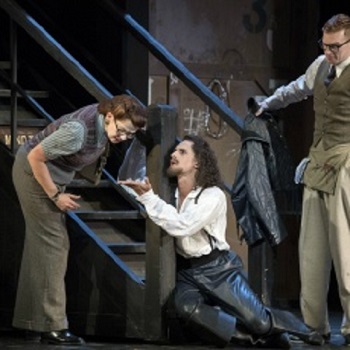 Rosie Hay (Ralph), Quirijn de Lang (Fred Graham/Petruchio) and Max Parker (Paul). Photo credit: Richard Hubert Smith.
Rosie Hay (Ralph), Quirijn de Lang (Fred Graham/Petruchio) and Max Parker (Paul). Photo credit: Richard Hubert Smith.
Quirijn de Lang - reprising his Opera North performance (given alongside Bern) - has a versatile and appealing baritone. With his dark, curly locks, and louche get-up, this Petruchio was a cross between an Elizabethan fop and Alan Rickman’s Captain Hook. New to Padua, Petruchio is looking for a wife and sees Katharine as a challenge which his masculinity will subdue: he is commanding, rough and bawdy. De Lang struck a fine balance, though, between rakish confidence and a quieter vulnerability. Petruchio’s ‘Were thine that special face’ and ‘Where is the life that once I led’ were beautifully sung, although de Lang didn’t consistently sustain the pitch through the held notes. And occasionally, when positioned at the rear of the stage, or when his singing was directed away from audience voice, de Lang’s baritone was lost within the jazzy orchestration - the role seemed to lie quite low in his voice. But, as the raffish Fred Graham, he joined with Wild for a sweetly vocalised ‘Wunderbar’, the gentle waltz softly consoling after the dressing-room bitching.
Amelia Adams-Pearce was forthright and jaunty as Lois Lane/Bianca, belting out ‘Always True to You in my Fashion’ with charm and charisma, and sustaining the sassiness through several reprises. Alan Burkitt was terrific as the all-singing, all-dancing Bill Calhoun/Lucentio. His duet with Adams-Pearce, ‘Why can’t you behave?’, was playful and sprightly, and in Act 2 he served up a toe-twitching tap routine worthy of Fred Astaire.
The lead quartet were superbly supported by the company of dancers and singers. Max Parker’s nerdy Paul whipped off his waistcoat at the start of Act 2 for an explosively energetic ‘Too darn hot’ - if he was hot to start with, he and the troupe must have been almost self-combusting after this physical inferno. Rosie Hay was a portrait of sober pragmatism as the no-nonsense stage manager Ralph whose patience is sorely tried by the over-exuberant thesps. Morgan Deare was endearing as Kate’s good-tempered, long-suffering father, Baptista, forgiving and indulgent but retaining paternal control over his wilful daughter. David Pearl’s Harrison Howell was every inch the self-satisfied, stuffy gent from Georgia.
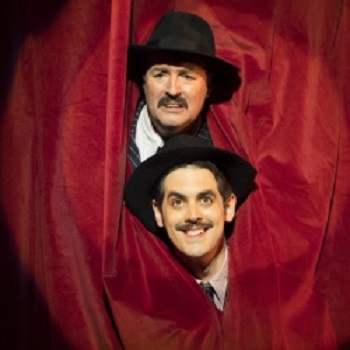 Joseph Shovelton (1st Gunman) and John Savournin (2nd Gunman). Photo credit: Richard Hubert Smith.
Joseph Shovelton (1st Gunman) and John Savournin (2nd Gunman). Photo credit: Richard Hubert Smith.
Finding themselves unexpectedly marooned in front of the curtain, Joseph Shovelton and John Savournin ‘improvised’ a fairly restrained rendition of ‘Brush up your Shakespeare’ - a gentle soft shoe routine with just a dash of camp and a jot of farce - but they relished Porter’s lyrics which explain that knowing Shakespeare is the key to romance.
Conductor Gareth Jones - who seemed to know every word of the show - led the WNO band in a rousing performance. The overture had plenty of razzle dazzle and captivating sway, and alongside the glitzy brass, the strings yearned silkily. Jones management of the complex Act 1 finale was masterful.
Amplification was used, but inconsistently, or so it seemed. Some of the numbers sung by the operatically trained singers seemed to be only lightly amplified, or not at all, and there were some abrupt switches which were disruptive to the vocal colour.
“Another op’nin’!” is the closing cry - all too true given that the cast and musicians were to perform an evening performance just two hours later. And, so infectious was this terrific Welsh National Opera performance that I’d have liked to have stayed seated in the stalls to enjoy it all over again. Truly Wunderbar!
Claire Seymour
Cole Porter (lyrics and score):
Kiss Me, Kate
Sam Spewack and Bella Spewack (book)
Fred Graham/Petruchio - Quirjin de Lang, Lilli Vanessi/Katharine - Claire Wild, Lois Lane/Bianca - Amelia Adams-Pearce, Bill Calhoun/Lucentio - Alan Burkitt, Hattie - Landi Oshinowo, Paul - Max Parker, Hortensio - Matthew Barrow, Gremio - Jon Tsouras, First Gunman - Joseph Shovelton, Second Gunman - John Savournin, Harry Trevor/Baptista - Morgan Deare, Harrison Howell - David Pearl, Nathaniel - Adam Tench, Gregory - Joseph Poulton, Phillip - Louis Quaye, Ralph (stage manager) - Rosie Hay, Stage doorman - Martin Lloyd, Cab driver - Julian Boyce, Dancers (Alex Christian, Flora Dawson, Matthew John Gregory, Andrew Gordon-Watkins, Ella Martine, Jamie Emma McDonald.
Director - Jo Davies, Conductor - Gareth Jones, Set & Costume Designer - Colin Richmond, Lighting Designer - Ben Cracknell, Choreographer - Will Tuckett, Sound Designer - Sebastian Frost.
Birmingham Hippodrome; Saturday 12th November (matinee).
image=http://www.operatoday.com/WNOKissMeKatecastandQuirijndeLang%28FredGrahamandPetruchio%29-WNOsKissMeKate-photocreditRichardHubertSmith.jpg image_description=Kiss Me, Kate: Welsh National Opera at the Birmingham Hippodrome product=yes product_title=Kiss Me, Kate: Welsh National Opera at the Birmingham Hippodrome product_by=A review by Claire Seymour product_id=Above: WNO cast and Quirijn de Lang (Fred Graham/Petruchio)Photo credit: Richard Hubert Smith
Beat Furrer FAMA - Hörtheater reaches London
FAMA is music as theatre in the widest sense, operating on multiple levels. In the last ten years, it's been performed many times, and there's a recording on Kairos. Experiencing it live, however, is essential since it was created as an experience to be enacted live, for maximum impact. It's a multi-sensory immersion: participation is not passive.
Ostensibly, Furrer's text comes from Arthur Schnitzler's novel Fräulein Else, about a girl who likes a fancy life and makes money from entertaining men, but it would be a mistake if this were taken too literally. The narrative isn't straightforward. The opera begins in Latin. then flows into a stream of consciousness, where ideas constantly mutate. What "is" Else's story? We aren't told in straightforward narrative. We learn through induction, empathizing with the clues in the seemingly disjointed text, and in the oblique imagery in the music. As we learn in real life. Significantly, FAMA begins with a discourse from Ovid, Metamorphoses Book XII, in which Fama the goddess of Rumour intuits meaning by processing what she hears around herself. What we knows, or think we know, grows through interpreting impressions from a non-stop flow of data.
Sparkling bell-like sounds, voices intoning fragments, beautifully pitched but elusive, long elliptical phrases in the orchestra shooting forth, patterns that move and draw back. The first two scenes in FAMA suggest teeming, vibrant happenings, just beyond our grasp. "Ich höre das Feuer.....ich höre den Regen..... ich höre in meiner Erinnerung.....ich höre das Schweigen." Then Else emerges, or rather Isabelle Menke intoning Else's words rapid-fire. The syntax isn't conversation, it doesn't communicate. It's an internal monologue, free associating, random thoughts from which we might, or might not, deduce who Else is. Perhaps Else herself is still figuring things out, asking questions, deducing, unsure. The ensemble reveals little: barely audible clicks and brushing sounds, as if the players themselves were listening and watching. As Else's voice rises, tensely, the orchestra bursts into manic life: cacophony, cut through by long, clear metallic lines, replicated by the voice. It's as if the voice and ensemble were reaching out, feeling out to invisible walls, gauging distance by sound waves. High, clear notes, flutes and clarinets feeling the way, hesitating, interrupted by sudden flashes of percussion. Sounds come from all directions, often out of sight, often distorted. Else's voice sometimes seems to materialize in the air. Piano sounds, accordion sounds, are heard as if from great distances across time. Ticking sounds, sometimes percussion, sometimes bows sawn against strings in bizarrely mechanical fashion. Every noise matters, no matter how subtle.
"Wie hübsch!" said Menke, with a demented smile. "How cute it is to walk around naked" Figuratively, she's watching herself in a mirror wondering what others think, and what she should be thinking of herself. The strings bow violent, mechanical angles, the brass blow mocking raspberries. The text describes how Else puts on a coat and walks naked through a hotel lobby. No-one knows. Then, at first quietly, the sound of a contrabass flute takes over where Else's words end. Contrabass flute: an instrument which looks so bizarre that just looking at it is an act of theatre. It's huge, silvery and metallic but, full blast, it's like a siren, blaring menace and mystery. This contrabass flute interlude is a magnificent coup de théâtre. The whole orchestra screams in response, then falls quiet as the contrabass flute, played by Eva Furrer, continued unchallenged, like a strange dancer, moving and singing with grave but bizarre beauty.
The words "Else, Else, Else" are projected onto the walls. A point is being made, visually, though the words are barely heard, the voices of Exaudi singing pure sound, materializing as if in dream. The effect was both magical and sinister. We don't know what happens to Else, but we could hear the swirling tumult in the orchestra. Walls of sound crashed around us, giving way to uncanny chords resonating in near silence. The contrabass flute led a section that seemed almost fugue-like in its grave but quirky dignity. Else returned briefly. Her last words were "Adresse bleibt Fiala". Whatever that's supposed to mean, I do not know, but the effect was powerful, and lingers tantalisingly in the mind. FAMA is more focused than Furrer's earlier Hörtheater Begrehen, first released on DVD in 2008, which also deals with multi-level concepts of time, space and sound. Thus FAMA lends itself well to semi-concert performance, as we enjoyed at St John's, Smith Square. Although we didn't see the cool, blue walls of the original, the plot. such as there is, predicates on a kind of mental imprisonment. The gold and burgundy of St John's, with its elegant chandelier, suggested the outward luxury of Else's profession, which could take place anywhere, not just in the Dolomites. The drama, and the genius, of Furrer's FAMA is that, through art, we may have come closer to understanding what goes on in Else's soul.
Thank goodness for the London Sinfonietta, returning to their roots in cutting-edge repertoire. For a while, they seemed caught up in sponsor-pleasing "education", but good work is, in itself, educational. Any orchestra can do education, but what the London Sinfonietta does is new music better than anyone else. This FAMA will be broadcast on BBC Radio 3 at an undisclosed date, but make sure you book for the next London Sinfonietta concert at St John's, Smith Square on December 6th when they'll be doing Hans Abrahamsen's Schnee, with Fool is Hurt, a new work by Simon Holt.
Anne Ozorio
image=
image_description=
product=yes
product_title= Beat Furrer : FAMA, London Sinfonietta, Isabelle Menke, Eva Furrer, EXAUDI, St John's Smith Square, 11 November 2016
product_by=A review by Anne Ozorio
product_id=
Franz Schreker : Die Gezeichneten (Les Stigmatizés). Lyon
This production gets close to the full horror of the drama, so it's uncomfortable listening. In 1911, when the opera was written, and in April 1918 when it premiered in the last months of the First World War and impending collapse of the German and Austrian empires, it must have been more harrowing than we can imagine today. It's not opera which has changed, but the expectations of modern audiences who'd prefer Watch With Mother to art.
The Vorspeil opens on long shots of the sea, a surging, inconstant surface, an image that highlights the music itself, and the hidden depths in the drama. Over these waters, young women of Genoa were transported, kidnapped from their homes, to an island not far from the city but cut off from the world around it. In classical mythology "Elysium" refers to a perfect paradise. In Die Gezeichneten it's a playground for the Id where moral values do not apply. On Elysium, the rich corrupt and destroy. The image of the sea gives way to images of young girls, ravaged and brutalized, imprisoned in Elysium's dungeons. These look like clips from snuff porn, though there's no actual nudity. We're supposed to feel traumatized, for these girls are being degraded for entertainment. We see posters of the missing, so many innocent faces, torn from their homes to suffer and die, so many that you wonder why no-one seems to question the power of the corrupt. Since these girls are daughters of aristocratic families, that raises questions of complicity. How culpable is Alviano Salvago? He's a hunchbacked dwarf, apparently so repulsive that even the most degraded prostitutes won't have him. So why did he build Elysium and let it be a sanctuary for abuse He's an aristocrat himself, so what is his real relationship with Count Vitelozzo Tamare (Simon Neal) and the others who use and abuse Salvago's hospitality?
The opera itself offers no answers, but the production evokes Salvago's inner desolation. The noblemen are macho, dressed in black leather, Salvago in white, against a backdrop that suggests hardness and desolation. Charles Workman is a tall, surprisingly elegant Salvago, his only deformity a red birth mark on his face, not nearly enough to make him as repellent as he assumes he is: perhaps Salvago's self-hate stems from much deeper psychic wounds. Perhaps it's not PC to show a dwarf as a dwarf but that says more about society's refusal to accept difference than about disfigurement itself, which is not a crime. Does Salvago's distress lie in his culpability? We don't know, but we do know that he's trying to sell Elysium and shut down the depravity it shelters. Gradually, the black, white and grey of the set warms with shades of burgundy: the colour of wine, blood and Salvago's birth mark.
Carlotta appears, in fetching burgundy leathers. Like Workman, Magdalena Anna Hofmann is tall, a veritable Diana among a troop of moral trolls. She's an artist, and artists can see beyond surface appearances. She sees the beauty in Salvago's soul and wants to paint his portrait. Salvago created Elysium as a temple of beauty, but let it become polluted. Although he wants, now, to gift it to the city of Genoa, he can't erase what it became. Duke Adorno blocks the gift for what its secrets might reveal should they come out. Markus Marquardt's Adorno is shown as a grubby bureaucrat: the kind of nonentity that lets abusers go unpunished, all over the world. Tamare describes the wonders of Elysium, its blue lights, hypnotic perfumes and music. The orchestra plays the lovely interlude, illustrated by projections of delicate flowers, blowing gently, but ghost-like, evoking the young women whose lives were sacrificed in the falsehood of Elysium's beauty. In the frenzy of orgy, the lines between beauty and ugliness blur. When Carlotta declares her love for Salvago, his bitterness poisons him. He makes her feel bad, like a witch. In this production Carlotta is clearly portrayed as a working artist, pushing Salvago to reveal his innermost self in the name of art. She wears a paint-splattered coat: not a passive love interest but the pivot on which the whole drama turns. Off comes Salvago's jacket, off comes Carlotta's coat, and lights shine in the studio. The painting is finished, Salvago's soul captured.
In the introduction to the last Act, the music is illustrated by magical lights against darkness. Salvago is dancing, as happy as a child. But low woodwinds and distant, offstage vocalise remind us that this idyll is haunted. In the scene between Carlotta and Duke Adorno, director David Bösch minimizes background action, focusing instead on the singing and on fine details in the acting. This is critically important, since it is here that Carlotta tries to explain herself. The audience should pay attention. A woman hides her allure in modesty, yet reveals herself naked: complex, contradictory feelings, good intentions and primal urges. On "this burning summer night", she wants to lie with "the goblins in the bushes". The connection between summer nights and devilry will be pretty clear to those who know the mythology behind Johannesnacht, but Bösch wisely avoids emphasizing that more clearly than is in the score. Instead, the focus is on enchantment: magical, twinkling lights, illusion, not all that different from the delusion that Elysium stands for. Thus Salvago sings of Carlotta disappearing like a will o' the wisp. The wedding party cheer him, but he knows he has lost Carlotta even before he knows where she has gone. At last he confronts the cruelty of his situation "Ich bin kein König, bin ich ein Narr!". The crowd keep cheering : they don't care about his suffering as long as they 're having a party.
Thundering chords. Duke Adorno reappears, now in stately black, accusing Salvago. The witness is a young girl kidnapped and raped while celebrations were going on. She's so young, she's clutching a doll. Although it wasn't Salvago who attacked her, it happened in his house. He's culpable. Yet again, the music expresses things the libretto cannot explain. Salvago hears distant music, harps, flutes, cymbals and singing voices. Echoes of Der ferne Klang and the magic music of the underground cave. We see the image of the sea, again, this time tinged with burgundy, reminding us of the many young women whose lives were destroyed. Suddenly, we're back in the dead zone, where young girls' bodies lie broken. Tamare mocks Salvago, who retorts that he's seen depths Tamare can't even imagine. Being an artist means being able to see what philistines like Tamare cannot comprehend. This perhaps explains why the young women are all daughters of wealthy noblemen. Salvago tried to create beauty. Tamare and his friends are incapable of understanding the concept of art, and are compelled to destroy anything purer, better and more elevated than themselves. It's not lust that drive them so much as hate, the negation of creativity and art.
The young girls rise as if from the dead, clawing Tamare, as if dragging him to hell, but not before he has a vision. He's seen the hate in Salvago's eyes before. Once, at another wedding, Tamare had killed a fiddle-player, driven mad with grief. Schreker's referring to the ancient meme of Der Speilemann. The fiddle player pops up again and again in Lieder and Romantic mythology, often as someone who loses a woman he loves though she chooses a man who can give her what he can't. Fiddlers are also the Devil agents of mindless destructiveness. Carlotta comes to life but cannot hear Salvago call. The sparkles we see on the ground look now like shards of glass, yet she crawls over them to reach Tamare, who reaches out to her as he dies. Throughout this staging, Bösch picks up on ostensibly small details in the score and libretto, like the little red light, which Salvago stares at. Whatever it means, it disappears abruptly. Perhaps the light has gone out for Salvago. "Bring me my fiddle, my cloak with silver bells", he cries. Alviano Salvago, the nobleman of Genoa, who aspired to build Elysium now the village fiddler gone mad because his art has failed.
Although dark, this production represents Schreker's Die Gezeichneten more faithfully than the Nicolas Lehnhoff production for Salzburg, conducted by Kent Nagano, though the performances then were stronger, though the Lyons cast aren't at all bad. You'll need them both. The subject matter is dark, and needs to be treated seriously. Grown-up audiences ought to cope, unless they, like the nobles of Genoa, are complicit in covering up crimes which are all too present in our own time. In contrast, Bösch's Mozart The Marriage of Figaro, which is also available on Opera Platform, captures the elegant brightness of that opera, and the element of social satire, with airy pastel tones and warm-hearted humour. Schreker's Die Gezeichneten will be done in July 2017 at the Bayerisches Staatsoper, with Ingo Metzmacher conducting - ideal ! - with John Daszak, Catherine Naglestad and Christopher Maltman. The director will be Krzysztof Warlikowski. I can hardly wait !
Anne Ozorio
Franz Schreker : Die Gezeichneten
Opéra de Lyon, 2015, broadcast Opera Platform 2016
Charles Workman - Alviano
Magdalena Anna Hofmann - Carlotta
Simon Neal - Tamare
Markus Marquardt - Herzog Adorno
Michael Eder - Podesta Nardi
Aline Kostrewa - Martuccia
Jan Petryka - Pietro
Jeff Martin - Guidobald
Robert Wörle - Menaldo
James Martin - Gonsalvo
Piotr Micinski - Julian
Stephen Owen - Paolo
Caroline Macphie - Jungfer
Falko Hönisch - Michelotto
Wolfgang Schöne - Podesta Nardi
Dirigent: Alejo Pérez
Chorleitung: Philip White
Kostüme: Falko Herold
Chor: Opéra de Lyon Chorus and Studio
Komponist: Franz Schreker
Bühnenbild / Ausstattung / Bauten: Falko Herold
Libretto: Franz Schreker
Licht: Michael Bauer
Inszenierung: David Bösch
Orchester: Opéra de Lyon Orchestra
Regieassistenz: Barbora Horáková Joly
image=
image_description=
product=yes
product_title= Franz Schreker Die Gezeichneten, Opéra de Lyon
product_by=A review by Anne Ozorio
product_id=
November 12, 2016
The Anatomy of Melancholy
An Elizabethan poet-composer, he expressed his melancholy in poems that speak of anxiety, regret and sorrow, and he set his troubled words to music of great imaginative power and originality.
At the Wigmore Hall, countertenor Iestyn Davies and lutenist Thomas Dunford presented a sequence of Dowland’s songs and instrumental pieces, interspersed with readings delivered with eloquent and wit by Colin Hurley. In Davies’ words, they sought to embrace ‘the songs and solo lute airs as the expressions of a man seeking to find words to say how words fail’, by engaging in ‘a dialogue that enriches both us and the artistic subject of Dowland itself’.
This was a performance of quiet concentration, exquisite poise and deeply poignant sentiment. So perfect was the sequence and union of music and word, that I struggle in my search for the words which can convey how affectingly Davies, Dunford and Hurley communicated Dowland’s spirit as embodied in the composer’s creative voice placed within the context of other voices of the period.
Davies and Dunford are no strangers to this repertory. The Art of Melancholy, recorded for Hyperion in 2014, was followed by a recital, with viol player Jonathan Manson, of music by Dowland and his contemporaries which was released by the Wigmore Live label in 2015 (Flow My Tears). With Hurley positioned stage right, and the musicians seated centre in relaxed fashion, an absorbing intimacy was immediately established. Davies’ delivery was pristine and unassuming: musically stylised but without undue fussiness, the text always clearly defined. His countertenor was finely coloured and firm of weight; the melodic lines had beguiling lyrical grace and directness. Dunford’s accompaniments were intricate and mercurial, and created a real sense of spontaneity.
Words from the huge, encyclopaedic Anatomy of Melancholy, produced by the English clergyman Robert Burton in 1621, got things underway. Burton explores a dizzying assortment of mental afflictions, including what might now be called depression, seeking to explain and account for all human emotion and thought. The nature, symptoms and causes of melancholy are described in rich, sometimes rambling, prose which shifts in tone from the serious to satirical. Hurley expertly captured Burton’s rollicking rhythm and phrasing, and the energy created by the words was passed to Dunford, whose Praleludium seemed to interrupt the text with extemporary vigour.
Such urgency carried into ‘All ye whom Love or Fortune hath betrayed’ where the lute’s alert explorations were balanced by the gentle wistfulness of
Davies’ portrait of the poet-singer as a man ‘That sings my sorrows like the dying swan’. The performers demonstrated a persuasive appreciation of these
songs’ frequent trajectory towards a powerful closing image. Here, the repeat of the final two lines - ‘Tears, sighs and ceaseless cries alone I spend:/ My
woe wants comfort, and my sorrow end’ - grew in power, the lute’s increasing melodic engagement with the vocal line adding earnestness and resolution. Such
sentiments turned to anger in Michael Drayford’s Sonnet of 1594 (the year in which Dowland’s Firste Booke of Songes or Ayres was published):
‘Cupid, dumb Idol, peevish Saint of love,/
No more shalt thou nor Saint nor Idol be.’
Davies began ‘Behold a wonder here’ began with striking power and focus: his rhetorical announcement of surprise and admiration that ‘Love hat receiv’d his sight,/ Which many hundred years/ Hath not beheld the light’ grew in animation as the song progression. But, the song ends with a warning that the beauty that love can now behold might prove to be ‘of double kind’; as Samuel Daniel confirms in his Sonnet 47: ‘Read in my face a volume of despairs,/ The wailing Iliads of my tragic woe,/ Drawn with my blood and printed with my cares/ Wrought by her hand, that I have honor’d so.’
‘Come again, sweet love doth now invite’ was the epitome of courtly grace. Davies’ tone was sweet and pure, the phrasing beautifully controlled. The contrast between silky vocal line and vivacious lute was wonderfully expressive. Dowland’s volta ‘Mrs. Winter’s Jump’ followed, segue; in Dunford’s hand the leaps were light and the lively dance retained an air of fancy.
Ben Johnson’s ‘The Hourglass’ - with its bitter image of draining dust re-imagined as the body of a love, who ‘in his mistress’ flame playing like a fly, Was turned to cinders by her eye’ - was the perfect prelude to ‘Time Stands Still’ which Davies and Dunford performed with unaffected loveliness. The full spread chords of the opening conveyed the text’s image of motionless Time, ‘with gazing on her face’, while Davies’ subtly emphasised the abstract nouns, ‘Fortune, Love and Time’ to convey the text’s central idea: ‘My settled vows and spotless faith no fortune can remove/ Courage shall show my inward faith, and faith shall try my love.’
Extracts from Dowland’s letter of 10 November 1597 to Sir Robert Sidney - a patron of music who was godfather to Dowland’s son, Robert - enveloped the following sequence of songs. ‘My thoughts are wing’d with hopes’ had a buoyant rhythmic spirit while the searching harmonies of ‘Say, Love, if ever thou didst find’ created momentum towards the concluding declaration: ‘To her then yield thy shafts and bow,/ That can command affection so: Love is free.’ Davies’ skilfully used the text in ‘I saw my lady weep’ to evoke the paradoxical image of Sorrow ‘made fair’ in the beloved’s fair eyes and woeful visage, as Dunford’s lute alertly moved from the shadows to the foreground, and then retreated, sealing the close with a chilling air of loftiness.
The harmonic twists and the lute’s cadential arguments in ‘Flow my tears’, from Dowland’s Second Booke of 1600 wondrously transfigured profound despair into the consoling belief that those in hell are happy because they ‘Feel not the world’s despite’. Davies’ countertenor projected the opening request of ‘Sorrow, stay’ - ‘Sorrow, stay lend true repentant tears,/ To a woeful wretched wight’ - with commanding weight until the threat of endless pain led to gentler entreaties to Pity, ‘help now or never’. While the singer’s repetitions, ‘down, down, down I fall,/ Down and arise I never shall’, created a compelling impetus, the rising gestures of the lute seemed to offer hope.
In 1613 the poet Sir William Leighton published a book of devotional verse entitled The teares or lamentacions of a sorrowfull soule; the following year, he reissued the collection with musical settings of his poems by English composers of the day. Leighton’s ‘prefatory poem in praise of John Dowland’ preceded Dunford’s elaborate articulation of Dowland’s ‘The King of Denmark’s Galliard’ the contrapuntal and rhythmic intricacies of which carried the music far from the physical movements of the dance and into speculative, quasi-spiritual realms. Dunford’s intent gaze seemed to draw Davies into ‘Can she excuse my wrongs’, in which the rhythmic engagement of voice and lute was enriching as the performers built to the insistent plea, ‘Dear, make me happy still be granting this,/ Or cut off delays if that die I must’.
Rose Tremain’s 2000 novel, Music and Silence, conjures the claustrophobic intensity of the Danish court of King Christian IV, where Dowland himself would find employment. The novel tells of the fictional Engish lutenist Peter Claire, who, summoned to join the king’s royal orchestra, finds himself designated the king’s ‘Angel’ because of the purity of his physical beauty, and falls deeply in love with the beautiful companion to Queen Kirsten, the king’s adulterous wife. The unrest that Tremain evokes was a pertinent prelude to one of Dowland’s greatest songs, ‘In darkness let me dwell’. At the start, the lute seemed to evoke the dry coldness of the Danish court, while the daring dissonances and rhythmic freedom of the vocal line expressed desolation. At the close, the repetition of the opening line trailed away into a disquieting silence which could only be answered by ‘Semper Dowland, semper dolens’ in which Dunford’s rapt, quasi-improvisatory presentation of Dowland’s haunting harmonic shades and solemn but exquisite melodic lines was mesmerising. One was reminded of the words of the composer’s contemporary, Richard Barnfield, which praised Dowland’s ‘heavenly touch upon the lute doth ravish human sense’.
The Third and Last Booke of Songes or Aires was published in 1603, while Dowland was still in the employ of Christian IV, and its Introduction preceded ‘Go, crystal tears’, in which Davies animated the beautifully even vocal line with subtle inflection. An excerpt from Henry Peacham’s Minerva Britanna (1612) - which playfully questioned the paradigms upon which Renaissance culture was founded - introduced ‘Come again, sweet love doth now invite’, which Davies imbued with fluidity and a spirit of freedom. In Leo Tolstoy’s ‘The Kreutzer Sonata’ the protagonist Pozdnyshev confesses how he murdered his wife after becoming jealous of her relationship with a musician, and an excerpt from the novella formed the final spoken item, leading eloquently into ‘Now, O now I needs must part’. The rhythmic irregularities of the vocal line in this final song were skilfully shaped into elegant contours by Davies, each stanza concluding with a refrain, which blames the singer’s discourtesy on the lady who has refused him, and which inspired reflective elaborations from Dunford.
Davies has described Dunford as the ‘teenage rock star of the lute’; so it was fitting that the duo offered an unusual encore, Eric Clapton’s ‘Tears in Heaven’, which Clapton wrote after the death of his four-year-old son. The delicate rendering of Clapton’s gentle musings was spellbinding, concluding a wonderful recital characterised by an unpretentious intensity that was truly magical.
Claire Seymour
Iestyn Davies (countertenor), Thomas Dunford (lute), Colin Hurley (speaker)
John Dowland: Preludium, ‘All ye whom love or fortune hath betrayed’, ‘Mrs Winter’s Jump’, ‘Behold a wonder here’, Come away, come sweet love’, A fancy, ‘Time stands still’, ‘My thoughts are winged with hopes’, ‘Say, love if ever thou didst find’, ‘I saw my Lady weep’, ‘Flow my tears’, Sorrow, stay, lend true repentant tears’, ‘Shall I strive with words to move’, ‘The King of Denmark, his Galliard’, ‘Can she excuse my wrongs’, ‘In darkness let me dwell’, ‘Semper Dowland, semper dolens’, ‘Go, crystal tears’, ‘Come again! Sweet love doth now invite’, ‘Now, O now I needs must part’.
image=http://www.operatoday.com/Iestyn%20Davies%20Marco%20Borggreve.png image_description=Iestyn Davies and Thomas Dunford, Wigmore Hall product=yes product_title=Iestyn Davies and Thomas Dunford, Wigmore Hall product_by=A review by Claire Seymour product_id=Above: Iestyn DaviesPhoto credit: Marco Borggreve
November 11, 2016
Aida in San Francisco
No echoes of spectacles like the al fresco productions beneath Egypt’s pyramids or Rome’s Baths of Caracalla. Nor of San Francisco’s famed jockstrap-less gay pride Aida, or an imagined specter of a new Zefferelli production recently dismissed by the Met. No echoes at all of the big singers that have always been called upon to evoke the monumental atmospheres commemorating global transformation.
Certainly not the 1981 San Francisco production starring Luciano Pavarotti, never-mind-the-name-of-the-opera [Aida]. If there is a star for this current production it is SFO protégé Leah Crocetto who offered a very sweetly sung Aida, and succeeded in projecting the beauties of the Italian language in an intimate “Ritorna vincitor” — though marred by a premature (surely unintended) drop of the hieroglyphically encrypted show scrim.
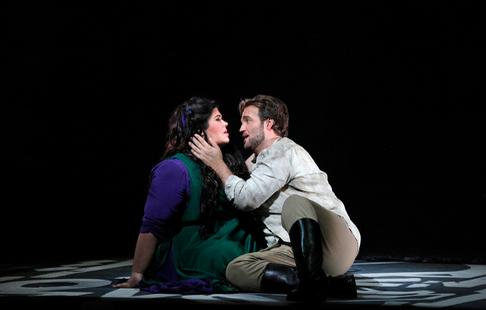 Leah Crocetto as Aida, Brian Jagde as Radames
Leah Crocetto as Aida, Brian Jagde as Radames
Aida’s lover Radames was SFO protégé Brian Jagde. Once we arrived at the entombment of Aida and Radames Mr. Jagde’s knife-edged voice softened and we heard, finally and with welcome relief, a voice of a sweetness and warmth that matched that of Mlle. Crocetto’s Aida. Conductor Nicola Luisotti carefully sculpted this protracted scene into one of profound operatic intimacy. It was memorable.
Luisotti made this Verdi score all about atmospheres, pulling forth every possible musical nuance to be evoked by the flow of the Nile and the glow of the Egyptian night sky. There was innocent playfulness in the Moorish dance, and even in the eruption of violence when Radames surrendered and Aida and her father fled Luisotti sustained measured strokes. More often for Luisotti these days it was a reflective reading of the score rather than a flow of dramatic points. The maestro made exquisite music of this warhorse.
If high art emanated from the pit, low taste poured forth from the stage, and it was not unintended. Stage director Francesca Zambello has been turning out provocative productions of Aida over the decades. This edition adds the hieroglyphic inspired alphabet created by L.A. artist Retna (alias of Marquis Duriel Lewis) to her provocations. These symbols (said to actually say something — but only to Retna) covered the show curtain and the huge panels of the triumphal scene, and elsewhere. You may recall his cover art for Justin Bieber's 2015 album "Purpose."
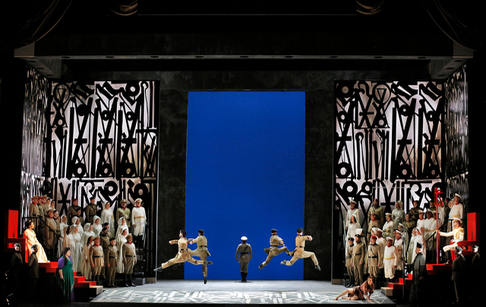 A moment in the Triumphal Scene
A moment in the Triumphal Scene
Zambello added as well eight dancing boys, and eight more boys who danced but were not trained dancers, two of whom were accomplished acrobats. When not dancing these groups of males sometimes marched across the back of the stage. Evidently the ritualized motions of these males were intended to illustrate religious statehood. Mme. Zambello used a related movement technique as well in her La vestale at ENO some years ago.
The choreography was created by Jessica Lang, a well-known name in institutional dance. She imagined complex, highly geometrical routines whenever possible but especially in the triumphal scene where there was no procession, instead a ballet in which the eight dancing boys chased and threw around a ballerina. Mmes. Lang and Zambello enforced a crescendo of visual razzle dazzle through which we barely felt the measured pace of the maestro’s triumphal march. It was tongue-in-cheek, camp and kitsch all at once. And sort of lovable.
Zambello updated the costumes to generic uniforms and religious robes of recent periods, and the program notes declared that the supertitles would say foreigners rather than Ethiopians or slaves. Mme. Zambello’s intended message that women were looked upon as possessions of men was perhaps apparent only to her, though the hijab-less ballerina was indeed tossed about quite a bit.
Things get serious in the third act and it was here that the singers seemed undirected, left to wander in a stage space absent of context. It was here that we felt to need of heroic singers to construct the political and dynastic catastrophe that Verdi creates musically, i.e. operatically. Aida does not play as a chamber opera of familial proportions cum triumphal scene, though this premise may have precipitated the role debuts of Mlle. Crocetto and Mr. Jagde.
With the exception of the Amonastro sung by baritone George Gagnidze and the Ramfis of Raymond Aceto, both seasoned, solid professionals additional casting was inexplicable. Precocious Adler Fellow bass Anthony Reed sang the King of Egypt who invites his daughter Amneris to award Radames the triumphal crown. The supertitles were not modified to indicate the obvious — that this Amneris was twice the age of the young king and was thus his mother! Amneris, sung by Russian mezzo Ekaterina Semenchuk, found appropriate colors in her upper voice but otherwise melted into the scenery.
Michael Milenski
Cast and production information:
Aida: Leah Crocetto; Amneris: Ekaterina Semenchuk; Radames: Brian Jagde; Amonasro: George Gagnidze; Ramfis: Raymond Aceto; King of Egypt: Anthony Reed;
A Priestess: Toni Marie Palmertree; A Messenger: Pene Pati. San Francisco Opera Chorus and Orchstra. Conductor: Nicola Luisotti; Director: Francesca Zambello;
Associate Director: E. Loren Meeker; Choreographer: Jessica Lan; Artistic Designer: RETNA; Set Designer: Michael Yeargan; Costume Designer: Anita Yayich; Lighting Designer: Mark McCullough. War Memorial Opera House, San Francisco, November 8, 2016.
image=http://www.operatoday.com/Aida_SF1.png
product=yes
product_title=Aida in San Francisco
product_by=A review by Michael Milenski
product_id=Above: Leah Crocetto as Aida, Ekaterina Semenchuk as Amneria [All photos copyright Cory Weaver, courtesy of San Francisco Opera]
November 10, 2016
Oreste at Wilton's Music Hall
Or as Jones puts it, ‘the place where “not funny” meets “funny”’. But, Tarantino is always on the side of the underclass, whereas Jones does not encourage us to care about or understand any of Handel’s characters. We are desensitised to the blood-letting within minutes. Moreover, there is a complete disjunction between the elegance of Handel’s musical rhetoric and the crude carnage that unfolds, often disruptively and incongruously, on stage.
The first night audience at Wilton’s loved it. To declare that musico-dramatic values have not been upheld - that one doesn’t like Handelian eloquence being smashed into smithereens by stomping boots, bludgeoning hammer blows and psychiatric frenzies - probably puts one in the ‘reactionary’ camp.
But, what is a shame about Jones’ production is that it does not serve its purpose; or, to put it another way, those whom it is designed to ‘serve’, have to work hard to overcome its limitations. For this production is intended to showcase the talents of Jones’ fellow Jette Parker Young Artists and it’s to the credit of the young cast that their Handelian credentials out-shine the shock factor shenanigans.
Oreste was one of five works produced by Handel in 1734 for his first season at the recently opened Royal Opera House. He had a busy season: one that resulted in newly composed works such as Ariodante and Alcina. So, perhaps it wasn’t surprising that when Oreste opened on 18 December 1734 there was a considerable amount of operatic re-cycling on parade.
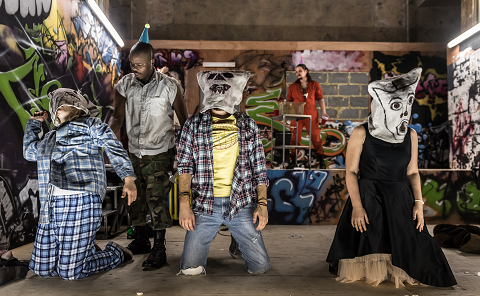 Photo credit: ROH, Clive Barda.
Photo credit: ROH, Clive Barda.
Oreste was the first of the three pasticcio operas that Handel himself created from his own works. He borrowed the overture and the forty other numbers from various of his operas, adding only a few new secco and accompagnato recitatives and two ballet movements (the dance sequences were included for Marie Sallé and her company, who appeared in all Handel’s productions in his first Covent Garden season of 1734-5); and, he altered the orchestration and key of particular numbers as dramatically and musically required.
Handel aficionados might find it disconcerting to hear a character in one drama sing an aria recognised from a different musico-dramatic context, but while musicologists might quibble over such identifications (one scholar suggests that extracts from some thirteen operas written between 1713 and 1733 were recycled), the audience in the theatre is concerned only with dramatic effectiveness. And, if Handel did not have time to compose new music, that doesn’t mean that he recklessly didn’t give due thought to the sequence and shape of the musical drama. Oreste is skilfully wrought, allowing that there is cliché and humdrum-ness alongside musical gems.
Adapted, with additional characters interpolated, from an earlier libretto by Gualberto Barlocci, the story is based on the Iphigenia myth, as treated by Euripides, combined with elements borrowed from Sophocles and Aeschylus. We’re in familiar dysfunctional family territory. Oreste, consumed by madness after he has murdered his mother Clytemnestra, lands in Tauria having been guided by an oracle. Ifigenia, though not recognising her sibling, is prompted to save him from sacrifice, and is aided by an admirer, Toante’s captain Filotete. Oreste’s wife Ermione and his friend Pilade come in search of him, and are arrested and condemned to death. After much threat of sacrifice and self-sacrifice, Ifigenia reveals herself as Oreste’s sister and with Filotete’s help inspires the Taurians to overthrow Toante and restore peace.
In Jones’ hands Ifigenia - miraculously saved from sacrifice at Aulis - has a new role: less high priestess of Diana, and more henchman of King Toante, she has to murder all strangers to the land of the Taurians. Wilton’s is in the East End, so Jones, predictably and uninspiringly, opts for grunge and graffiti and adds a bucket-load of gratuitous gruesomeness. The action is contained within a tag-strewn cube: designer Matt Carter signals that what we are about to see will be ‘Raw!’ Jones believes that ‘scenery is the enemy of directors’: one couldn’t help thinking that the exposed brickwork of Wilton’s itself might have been more effective. There are few props: just a radiator, a box of flex wire and other torture tools, a filthy yellow wheelie bin, a glowing electric fly-zapper, a shabby standard lamp.
With a plastic apron and gloves to safe-guard her knee-length ti-shirt, a panda-eyed Ifigenia strays in clutching a hammer and, wearily passing through a door at the rear of the cube, enters an execution chamber and proceeds to get on with the business in hand. To the accompaniment of Handel’s eloquent overture, an anonymous victim is bludgeoned and blood splatters the glass window. And so it goes on. Stomping about in combat fatigues and dark glasses, Toante is a Mugabe-like megalomaniac whose raving becomes ever more demented as the body count rises. Dressed in an orange body suit and Doc Martens, Filotete is a willing accomplice in butchery, slavering rabidly as he stuffs another limb in a bin-bag. The two strangers from Argos wash up in this nightmarish slaughter chamber like a pair of ragged refugees and are sucked into the amorality; at the close, the hammer-wielding Ermione leads the way in the mutual massacring of Toante.
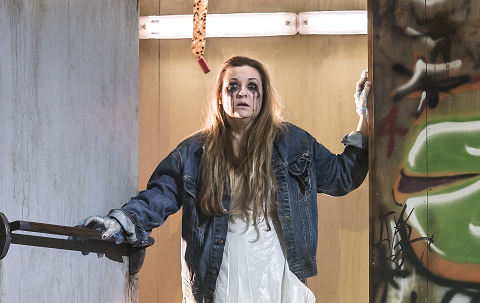 Jennifer Davis as Ifigenia. Photo credit: ROH, Clive Barda.
Jennifer Davis as Ifigenia. Photo credit: ROH, Clive Barda.
Reading Jones’ explication in the programme booklet, one is disheartened by the absence of words such as ‘Handel’, ‘music’, and by the summative rationale: ‘I think the behaviour of all the characters is pretty bad … I think the behaviour is awful. All these people are awful. That is the starting point.’ He sees his job as ensuring ‘the behaviour you see on stage sustains the story … and is as real as possible against the unreality of the music’. But, fortunately, as Jones notes, ‘musically the piece will sustain itself’ - the problem is, can he sustain our interest during three long acts of ultra-violence which is divorced from the musical narrative?
The young cast showed that they know how to shape a Handel aria, how to negotiate ornament, and how to use vocal colour to characterise and communicate. They worked hard, and with some terrific musical results.
Angela Simkin’s pyjama-clad Oreste is a wide-eyed, twitching self-harmer, but she sang with impressive, quiet concentration and revealed a glowing vocal polish. As Ifigenia, Jennifer Davis showed that at the top she can manipulate colour, dynamic and weight of her lyric soprano with ease, and that she can embellish stylishly. Vlada Borovko was in powerful voice as Ermione; the duet of farewell (taken from Floridante) for Oreste and Ermione which closes Act 2 was a rare heart-warming moment amid the cold callousness.
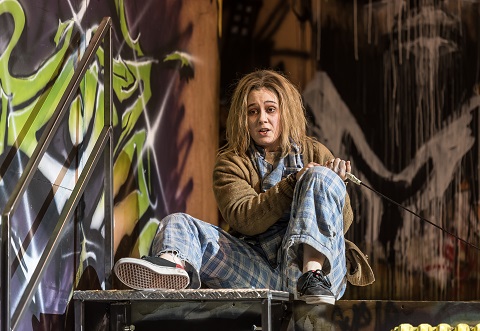 Angela Simkin as Oreste. Photo credit: ROH, Clive Barda.
Angela Simkin as Oreste. Photo credit: ROH, Clive Barda.
As Pilade, tenor Thomas Atkin helped, momentarily, to alleviate the relentless ferociousness of the proceedings, singing with quiet beauty in his Act Two aria of adoration for his beloved Oreste; he managed Handel’s high-lying lines well and shaped the phrases gracefully.
Simon Shibambo has a resonant bass baritone that, in another production, could command great authority: here, he used his voice well, just about overcoming the distraction of Toante’s ridiculous crazed rampaging. The latter may have been the cause, too, of Shibambo’s tendency to lose touch with the band. As his over-zealous aide, Filotete, Gyula Nagy revealed a strong baritone but needed a bit more variety of volume and shade.
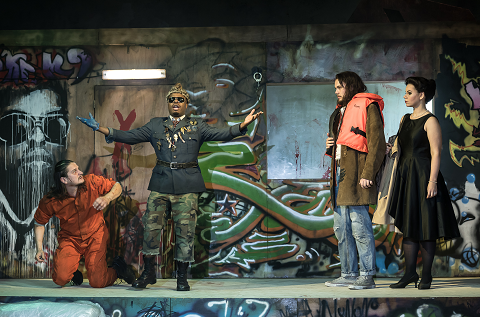 Gyula Nagy as Filotete, Simon Shibambu as Toante, Thomas Atkins as Pilade, Vlada Borovko as Ermione. Photo credit: ROH, Clive Barda.
Gyula Nagy as Filotete, Simon Shibambu as Toante, Thomas Atkins as Pilade, Vlada Borovko as Ermione. Photo credit: ROH, Clive Barda.
One might have wondered why members of the Southbank Sinfonia, not known for adventures in ‘authenticity’, had been chosen as accompanists, but in the event they played superbly, led by conductor James Hendry who seemed to have every detail of the score at his command. The violin lines had real character and were thoughtfully shaped and ornamented; the bass was strongly driven. Harpsichordist Nick Fletcher, seated on the opposite side of the theatre to the rest of the band, offered some imaginative continuo flourishes.
Jones ends not with redemption and reconciliation but with existential dissolution. It’s all too much for Atkin’s Pilade: his lovely final aria having been overshadowed by the orgiastic clubbing of Toante, Pilade dons an orange life-jacket and, presumably, swims off in search of fairer lands. At the end of this merciless blood-feast, I knew how he felt.
Claire Seymour
Handel: Oreste
Oreste - Angela Simkin, Ifigenia - Jennifer Davis, Filotete - Gyula Nagy, Ermione - Vlada Borovko, Pilade - Thomas Atkins, Toante - Simon Shibambu; Director - Gerard Jones, Conductor - James Hendry, Designers - Gerard Jones and Matt Carter, Costume Designer - Donna Raphael, Lighting Designer - Mimi Jordan Sherin, Movement Director - Anjali Mehra, Southbank Sinfonia.
Wilton’s Music Hall, London; Tuesday 8th November 2016.
image=http://www.operatoday.com/Set%20for%20Oreste%20Clive%20Barda.png image_description=ROH, Oreste at Wilton’s Music Hall product=yes product_title=ROH, Oreste at Wilton’s Music Hall product_by=A review by Claire Seymour product_id=Photo credit: Clive Barda
November 8, 2016
BEMF Chamber Opera Series Presents Splendors of Versailles
Enjoy a musical feast from the height of the Sun King’s reign with two chamber operas—Charpentier’s Les Plaisirs de Versailles and Lalande’s Les Fontaines de Versailles—exalting the splendor and majesty of the palace and its gardens, alongside divertissements from Lully’s Atys—called the “King’s Opera” for the favor it enjoyed with Louis XIV. The refined elegance and expressive drama is brought to life by the all-star BEMF Vocal and Chamber Ensembles in a magnificent production featuring gorgeous costumes, Baroque dance, and sumptuous staging.
Click here for the complete press release regarding this production.
image=http://www.operatoday.com/versailles-008.png image_description=Palace of Versailles product=yes product_title=BEMF Chamber Opera Series Presents Splendors of Versailles product_by=BEMF Press Release product_id=Above: Palace of VersaillesHeresy, Electronic Opera in Dublin About Giordano Bruno
It was the tragic story of this martyr to science, which inspired the Irish composer Roger Doyle and the producer Eric Fraad to create the electronic opera Heresy performed in Dublin’s Project Arts Centre.
Bruno ran into trouble at an early stage of his celebrated career by challenging not only key catholic doctrines, but the whole cosmic system, proposing a revolutionary concept of infinity. Travelling through France and England, meeting all the major thinkers of the time, and while in London possibly spying on Catholic conspirators, under the pseudonym “Henry Fagot” for Sir Francis Walsingham, secretary of state for Queen Elizabeth, Bruno had a spectacular life. His fascination with memory and language have influenced and inspired artists such as James Joyce who enjoyed punning on the name of the Dublin publisher “Browne and Nolan”—incorporating the name of Bruno’s home town Nola. Joyce’s novel Finnegan’s Wake contains over four hundred references to Bruno. It was therefore particularly appropriate that this particular heresy captured the imagination of Doyle.
The opera is an ensemble piece with singers taking on a variety of roles with dramatic dexterity. The intimacy of the studio theatre, allowed the audience to appreciate Fraad’s detailed work with the soloists. The opera in two acts of around an hour each was formed by various snippets of scenes from Bruno’s life, including scenes from his farce Il candelaio (The Candlebearer) leading to the redemptive moment of his death by fire. Doyle used a fascinating variety of voices including male soprano, Robert Crowe, particularly effective as an extravagantly evil Cardinal Bellarmine, as as well as an actor, Jack Walsh, using spoken dialogue. The tone of his electronic score was often meditative with words generally set slowly, creating an atmosphere of sustained reverence. The musical language was hybrid, with moments bringing to mind the minimalist approach of Philip Glass, and others where exciting rhythmic percussion suggested an altogether more popular idiom. Occasionally the vocal lines lacked architectural force, but the second half leading to the execution lent credibility to the approach as the music of the stratosphere took on a sustained universality to echo Bruno’s limitless philosophical horizons. The final moments also found Fraad’s production raising the emotional temperature of the evening with some impressive video projections of flames against the simple scaffolded set.
Lovely performances from fourteen-year old soprano Aimee Banks, who sang the role of Giordano Bruno as a boy — a crystal clear voice which was an evening long pleasure. Morgan Crowley made an intense and moving Bruno with great support from rising young Irish soprano Daire Halpin as amongst others an authoritative Elizabeth 1st, and Caitríona O’Leary, who came into her own as Circe in the final meditative moments of the opera.
Stephen J Mudge
image=http://www.operatoday.com/MET1016HS15.png image_description=Front left to right: Queen Elizabeth I (Daire Halpin), Giordano Bruno (Morgan Crowley), Sir Francis Walsingham (Robert Crowe). Back left to right: Paparazzi, Jack Walsh, Caitríona O'Leary product=yes product_title=Heresy, Electronic Opera in Dublin About Giordano Bruno product_by=A review by Stephen J Mudge product_id=Above: Front left to right: Queen Elizabeth I (Daire Halpin), Giordano Bruno (Morgan Crowley), Sir Francis Walsingham (Robert Crowe). Back left to right: Paparazzi, Jack Walsh, Caitríona O’LearyA New Das Rheingold at Lyric Opera of Chicago
The roles of Wotan and Fricka are sung by Eric Owens and Tanja Ariane Baumgartner. The giants Fasolt and Fafner are portrayed by Wilhelm Schwinghammer and Tobias Kehrer, Alberich and Mime by Samuel Youn and Rodell Rosel. The remaining figures associated with nature and the gods-Loge, Donner, and Froh-are sung by Štefan Margita, Zachary Nelson, and Jesse Donner. The roles of Freia and Erda are performed by Laura Wilde and Okka von der Damerau, while the three Rhinemaidens are Diana Newman, Annie Rosen, and Lindsay Ammann. Messrs. Schwinghammer, Kehrer, and Nelson are performing in their Lyric Opera debuts; Mr. Youn and Ms. Baumgartner are making their American debuts, and Ms. von der Damerau her American operatic debut. Sir Andrew Davis conducts the Lyric Opera Orchestra. This new production is directed by David Pountney, with set designs by the late Johan Engels and Robert Innes Hopkins. Costumes and lighting are designed by Marie-Jeanne Lecca and Fabrice Kebour respectively, while Denni Sayers has created the choreography.
On a quiet, shadow-filled stage three figures dressed in black cloaks deposit a parcel; almost simultaneously are visible three scarlet ropes, held by the Norns and representing fate, those figures who will appear later in the prologue to Götterdämmerung, the final opera of the Ring Cycle. Once the parcel containing the treasure is elevated and the orchestra begins to play the start of the prologue’s sustained chord, the Rhine is depicted by the undulations of a suspended blue cloth swathing a glowing ball of gold. The entrance of the Rhine Maidens and their subsequent playful taunting of the dwarf Alberich exemplifies this production’s innovative approach to Wagner’s text. The Rhine Maidens are perched on cranes that are wheeled about the stage by supernumeraries dressed in costumes reminiscent of those worn by office personnel in the 1920s. At the same time, the Maidens in the imagined river are well dressed, wielding tennis rackets, which they wave sportily as their positions are raised and lowered by those helpers manipulating the cranes. The elusive motion of the Maidens is facilitated by the mechanics and corresponds in Wagner’s text to the banter with which the Maidens taunt “den lüsternen Alp” [“the lascivious gnome”]. Yet they do not heed Flosshilde’s warning to guard the treasure and boast instead of the gold’s innate powers. Once Alberich renounces love to embrace instead power and wealth, a transition unexpected by the Maidens, he is able to wrest the gold from their control and flee. Mr. Youn’s depiction of Alberich’s transformation is sung with arresting dramatic commitment. After snatching the treasure Youn hurls a chilling curse at the love with which the Maidens have taunted him [“entreisse dem Riff das Gold … hör’ es die Flut: so verfluch ich die Liebe!” (“I shall wrench the gold from the rock … let the waves hear it: in this way I curse love!”)].
Many of the remaining characters in the company of the gods and their opponents are introduced in the second scene of Das Rheingold, the transformation again being accomplished with the help of supernumeraries. The open space in a mountain pass is punctuated by several mobile cranes on which are perched the royal leaders of the gods. Wotan and Fricka wore regal cloaks of dull red and complementary broad-brimmed hats signifying their station. Freia is positioned within a wire enclosure close to a stylized tree bearing the golden apples associated with her powers. In keeping with his lingering, sluggish dream, Mr. Owens responds with understated distraction to Fricka’s importunate pleas on behalf of her sister. Ms. Baumgartner’s disciplined insistence as Fricka yields a lush vocal line with effective pathos expressed on the deep pitches ending “Mir bangt es um Freia” [I fear for Freia”]. She reminds Wotan that surrendering Freia to the giants is the price for their completion of the new palatial structure. While lamenting that she was excluded from the preparatory negotiations [“allein mit den Riesen zu tagen” (“you dealt alone with the giants”)], Baumgartner’s insistent dramatic line on “Freia, die gute, geb’ ich nicht auf!” [“I refuse to surrender the good Freia!”] dominates the royal interaction. Ms. Wilde’s emotionally charged depiction of Freia [“Hilf mir, Schwester!” (“Help me, o sister!”)] meets the vocal and dramatic demands of the role ideally, just as Owens declares limpidly that Loge will arrive to solve their current dilemma.
The depiction of the giants intensifies this production’s narrative flow. Messrs. Schwinghammer and Kehrer appear perched atop separate cranes, each structure sporting - above - an oversized face and - below - giant hands able to grasp and pummel. When Schwinghammer’s Fasolt hears of Wotan’s potential reconsideration, his voice quakes with deep offense on “Sinnst du Verrat, Verrat am Vertrag?” [“Are you planning to betray our agreement?”] His continued haggling with Wotan culminates in an impatient snarl on “Ein dummer Riese rät dir das” [“A simple giant counsels you”]. The compatriot Fafner elaborates on the value of Freia’s capture: Mr. Kehrer enunciates with ringing clarity how the golden apples, which she tends, guarantee the gods’ perpetual youth. While Wotan frets over Loge’s delayed arrival, Froh and Donner, brothers to Freia, declare their continued, filial support. Here the verbal assurances are effectively sung by Messrs. Donner and Nelson, such that further time is bought from the giants. Mr. Donner’s Froh urges with lyrically aching top notes, “Zu mir, Freia!” [“To me, Freia!”], while Mr. Nelson’s Donner warns with deep resonance of the effect of “meines Hammers harten Schlag” [“the heavy blow of my hammer!”]. Both characters extend the dramatic tension until the appearance of Loge. Once he arrives with characteristic, dramatic flair Mr. Margita’s Loge dominates this scene if not the remainder of the production. The effect of Margita’s Loge is not only a vocal and dramatic success, but his character also initiates, through both gesture and facial demeanor, the actions and statements of others. This Wagnerian catalyst propels the giants’ interest in the gold in lieu of Freia as well as Wotan’s decision to descend to Nibelheim to confront Alberich. Margita’s rising, melismatic delivery of the line “die goldnen Äpfel in ihrem Garten” [“the golden apples in her garden”] focuses attention on the necessity of action, while reminding the gods of their current insecurity.
The third scene of Das Rheingold is staged to emphasize Alberich’s power and defeat. On either side of the center stage cages house the workers whom the dwarf has enslaved. After the physical confrontation between Alberich and his brother Mime, the visitors arrive in Nibelheim. Once Loge and Wotan learn from Mime the basis of Alberich’s powers, a plan for his capture is conceived. Mr. Rosel delivers the wounded monologue of Mime with declamatory fervor; Margita reacts to the information with a cautious and realistic nod to Wotan, as he pronounces the line, “Nicht leicht gelingt der Fang” [“The capture will not be easy”]. By being tricked into assuming various animal guises with the use of the magic Tarnhelm, the dwarf presumes he is demonstrating his power. Margita’s feigned terror in the face of the serpent, Alberich’s first transformation, is believably expressed with the words, “Mein Zittern mag dir’s bezeugen” [“My trembling can prove to you my fear”]. When the second request for an animal shape is made, the capture is settled. Alberich as a toad is easily snatched and held, the Tarnhelm also now in the power of the gods.
The three figures continue their possessive struggle at the start of the opera’s final scene. Alberich has been brought as a captive to the mountain-top in the godly heights. He learns from Wotan that he must surrender the gold to purchase his freedom. The Tarnhelm must remain with Loge, while the final object, the ring, is still in Alberich’s possession. When Wotan demands the golden ring from the dwarf’s finger, Youn unleashes his fury with masterful control. He sings an extended forte pitch on “Knecht” in the line “Der Traurigen traurigster Knecht!” [“of wretches the wretchedest slave!”]. The subsequent curse on the ring is delivered by Youn with ominous, chilling intensity [“Wer ihn besitzt, den sehre die Sorge” (“Whoever possesses it, may that one be fraught with care”)].
In the concluding segments the giants return Freia from her captivity but refuse to yield until they have received the desired measure of gold. In this production the height of Freia is gauged by piling the gold around her in the familiar wire cage. The final claim placed by the giants on Wotan’s ring, wrested earlier from Alberich, brings Erda into the midst of the gods. Ms. von der Damerau commands attention in her delivery of “Weiche, Wotan weiche” [“Yield, Wotan”]. Her brief appearance is cleverly staged, so that von der Damerau’s lush, emotive appeals to Wotan are heard suddenly from amidst the larger group of characters. The ring is ceded, to be sure, in keeping with Erda’s appeal; with the killing of Fasolt by Fafner the first example of predicted misfortune is complete. For now, the gods have received Freia into their fold, and they admire the fortress which they will now approach. The orchestral accompaniment, regally declarative, is here played with seamless beauty under Davis’s direction. Margita sings Loge’s prediction, “Ihrem Ende eilen sie zu,” [“They hasten toward their demise”] as an assured aside, yet one that captures his amusement as well. This glance to the future functions as an invitation to the succeeding works in the Ring, now eagerly awaited after this successful beginning.
Salvatore Calomino
image=http://www.operatoday.com/Josef_Hoffmann_-_Closing_scene_of_Das_Rheingold_final.png
image_description=Outside the Hall of the Gibichungs (1876) by Josef Hoffmann
product=yes
product_title=A New Das Rheingold at Lyric Opera of Chicago
product_by=A review by Salvatore Calomino
product_id=Above: Outside the Hall of the Gibichungs (1876) by Josef Hoffmann
Bare Opera Proves Opera is as Relevant as Ever in a Fresh-Faced La Cambiale di Matrimonio
After requesting permission from Maestro Sesto Quatrini to adopt a more modern plotline, the cast frantically flipped through newspapers scattered on the stage floor, seeking a plot less antiquated than that of Rossini’s La Cambiale di Matrimonio.
Opera suffers from a lot of “old-fashioned” traditions. Many of the more traditional classical or Romantic storylines center on some pretty disturbing themes, even when the outcome is comedic. Somehow as opera audience members, we give a cursory glance to these premises in order to enjoy the music; we favor the comedy in a situation that’s otherwise disturbing, even if it’s a story about a girl being sold into marriage with a man twice her age or a farce about a servant being relentlessly sexually harassed by her older employer. In La Cambiale, the plot centers around Tobias Mill, father to Fanny, who wants to sell his daughter in marriage to a rich Canadian, Slook.
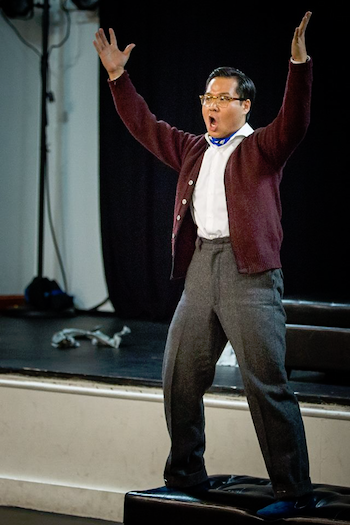 Suchan Kim
Suchan Kim
Should we ignore these premises, though? Bare Opera takes a moment of reflection to question our complacency, reading real headlines from New York Times articles from the past two weeks. The cast managed to read three headlines, all of which highlighted different instances in which women and girls were trafficked or killed for resisting forcible marriage.
A brief search into the New York Times coverage of girls in forced marriages leads to dozens of hits. One article from July of this year told the story of Zahra, a young girl who liked performing in her school drama and got chosen to do a juggling act as part of an educational circus that came to her school. When her father decided to remarry, Zahra became part of the dowry, and as a sixth grader, was married off, and then about two years later, died when her husband’s family set her on fire. She was four months pregnant when she died, and the soles of her feet were the only part of her body that was unburned.
So how funny is it to watch an opera about a young girl being sold (or mortgaged, a word that comes up a lot in the libretto) into marriage to a man she has never met?
The cast gave up on their quest for a more modern storyline, since it was clear a story about a girl being sold was not an old-fashioned story at all, and got on with the music. After the moment of sobriety during the pre-show announcement, the music swept away any moral misgivings, especially since Bare Opera kept the production thoughtful and reflective, while still serving the comedic outlandishness inherent in Rossini’s work.
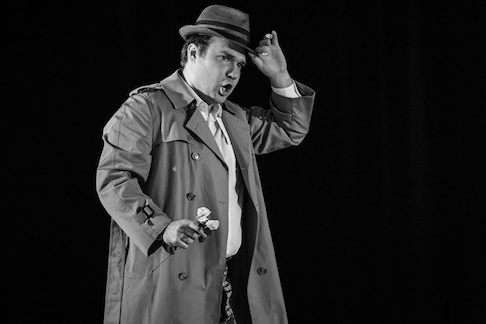 John Allen Nelson
John Allen Nelson
Sesto Quatrini is an energetic and communicative conductor, eliciting a gorgeous palette of sounds from a truly exceptional group of musicians. The ensemble was incredibly tight and harmonious, especially for a group that is unlikely to play together regularly.
The cast also shines in a very creative and exciting staging of Rossini’s first opera, composed in a few days when he was only 18 years old. La Cambiale has all the hallmarks of a Rossini opera, and a lot of the characters tend to be a little one-dimensional. However, this fine cast manages to eke out different shades of characterization from their roles, helped along by the direction by Cecilia Ligorio, which provides many moments of authentic delight for the audience. There was no set to speak of, and the production plays between a traditional stage space and a more intimate in-the-round style of staging. However, no one seemed to notice the paucity of the production elements. Indeed, it has been a long time since I’ve sat among such a rapt audience, especially for a very traditional work. The energy of the crowd was palpable, and several moments elicited genuine gasps and giggles.
Kirsten Scott slips easily into her role of Clarina after donning her Executive Producer cap. She brings Clarina to life in a very sexy but down-to-earth portrayal with a well-sung and sparkling aria in the latter half of the opera. John Allen Nelson portrays the buffoonish Slook with a more casual, less caricatured air, with a demeanor which is much more sinister than the usual blustering buffoonery adopted by many singers in this role. He plays Slook as a man surprised to hear that he’s being refused, and surprised that a woman would even have an opinion at all. Nelson has a full, easy sound, and is a pleasure to hear and watch.
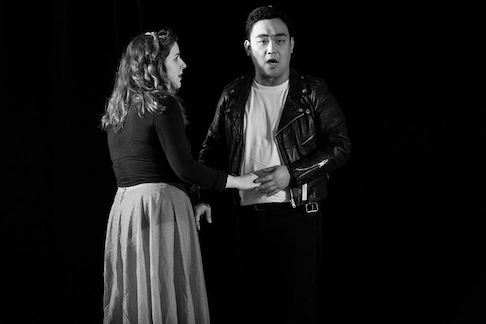 Liana Guberman and Sungwook Kim
Liana Guberman and Sungwook Kim
Liana Guberman (Fanny) has the perfect bel canto voice, supple and lush with all the brilliance needed for Rossini. She plays Fanny not as a silly young girl, but as a woman genuinely wounded by her father’s betrayal. There’s nothing frenetic about Guberman’s portrayal; in fact, it even tends towards heartbreaking, particularly in some moments during her duet with Slook. Her huge aria at the end of the opera is a high point of the production, especially in conjunction with an incredible performance by dancer Daisy Ranson Phillips, who uses Rossini’s music to punctuate her bodily movements.
Suchan Kim (Tobias Mill) magnetizes the audience to him throughout the evening, with a sumptuous baritone voice and precisely communicative Italian. He is wonderfully funny without ever becoming cartoonish, and sustains a level of energy in both voice and deportment that left me exhausted just watching him.
The entire cast (including Sungwook Kim as Edward Milfort and Colin Whiteman as Norton) perform with such joy that it’s impossible not to go along with them. They don’t give into character stereotypes or devolve into farce, even where it would have been easy to do so. There’s something naturalistic and terribly believable about their performances, yet each singer retains the exuberance necessary to keep the audience engaged.
Opera is trying so very hard to be cool again, giving into hackneyed techniques like liquoring up its audience or offering up scantily clad soprani. Bare Opera doesn’t need to try to be cool, because they already know they are cool. The sheer joy they take in performing Rossini’s work is infectious. This cast, crew, and production leave the audience breathless and exhilarated. Opera may be old fashioned—maybe—but Bare Opera knows it’s as relevant today as it was 200 years ago.
Alexis Rodda
image=http://www.operatoday.com/bareopera2.png image_description=Kirsten Scott and Colin Whiteman [Photo by Gustavo Mirabile] product=yes product_title=Bare Opera Proves Opera is as Relevant as Ever in a Fresh-Faced La Cambiale di Matrimonio product_by=A review by Alexis Rodda product_id=Above: Kirsten Scott and Colin Whiteman [Photos by Gustavo Mirabile]November 6, 2016
Wexford Festival Opera 2016
Félicien David’s Herculanum (1859) builds a melodrama from pathetic fallacy. Set in AD 79, during the reign of Emperor Titus, one year after the conquest of Jerusalem, this tale of the Roman Queen Olympia’s attempt to seduce the Christian slave Helios takes place in the shadow of Vesuvius, and the mountain’s impending eruption both signals and seals the fate of the reprehensible monarch and her citizens and slaves. Director Stephen Medcalf and his designer Jamie Vartan (re-united following their acclaimed Wexford productions of Delius’s A Village Romeo and Juliet in 2012 and Foroni’s Cristina, regina di Svezia in 2013) mark this visually. The initial front-drop presents us with a brooding volcano, which by the start of Act 2 has begun to belch smoke; by the final act, the magma is boiling and bubbling.
But, other than a concluding video animation of an eruption which smothers all bar the central pair of protagonists in molten lava before a dramatic draining of colour entombs the citizens of Pompei in ash, Medcalf struggles to bring some fire to David’s only grand opera. This is not surprising for, despite the richness of the melodic writing and some interesting orchestral effects, the opera is not wholly successful in bringing the hefty conflicts between political and religious groups, and the excessive emotions which the audience of the Paris Opera demanded and expected, into a convincing and dynamic dramatic form.
The central conflict is between a chaste Christian couple, Lilia and Hélios, and a despicable brother-sister-brother despotic duo, Olympia and Nicanor, who hail from Euphrates but have been elevated by the Romans to be Queen and Proconsul respectively. Olympia - named for her devotion to Mount Olympus - must halt the advance of Christianity either by executing the Christians martyrs or by converting them to paganism through seduction. She desires the slave Hélios, and wins him by means of a potion, her alluring beauty and the magnificence of her court. Nicanor lusts after Lilia, but even though he shows her a vision of Hélios’s betrayal, she remains steadfast in her loyalty to Hélios and to her God. Infuriated by his failure, Nicanor declares that her God does not exist. A bolt of lightning immediately strikes him down, whereupon Satan appears and dons the corpse’s cloak. When confronted by his Christian beloved, Helios wavers but, believing that his act will save Lilia’s life in the face of the Queen’s jealous fury, he reasserts his devotion to Olympia. Meanwhile Satan invokes an uprising among the Christian slaves, but as Lilia and Hélios are reconciled, the Devil causes Vesuvius to erupt and the beloveds rise, in redemption, to heaven.
Medcalf and Vartan adopt a stylised approach. Before a backdrop of the foot of Vesuvius, on a steeply raked stage, the chorus of pagans gather to worship Olympia, striking poses in the manner of a Greek chorus. Lighting designer Christopher Akerlind illuminates them in intermittent squares of light, anticipating the transfiguring frame of light that will fall upon Hélios and Lilia in the opera’s closing frame.
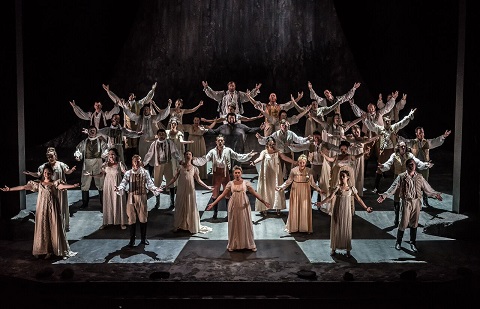 Chorus of Wexford Festival Opera. Photo credit: Clive Barda.
Chorus of Wexford Festival Opera. Photo credit: Clive Barda.
The stylish French-Empire costumes reference the period of the opera’s composition, and it is worth remembering that ‘Olympe’ was a noms-de-guerre frequently assumed by upper-class prostitutes in France at this time. The name was used by writers such as Alexandre Dumas (in his 1851 novel, Olympe de Clèves) and Émile Augier (in his 1855 play Le Mariage d’Olympe), while Édouard Manet’s ‘Olympia’ shocked viewers at the 1865 Paris exhibition as details identified the naked woman, who stares confrontationally at the viewer, as a prostitute.
Daniela Pini’s regal Olympia entered from a hollow at the base of the mountain and the Italian mezzo-soprano made the cruel Queen’s power and potency forcefully evident. Forced to kiss her sceptre, four ‘oriental’ captives are pushed to the floor by Nicanor’s sword, their backs forming a bridge for Olympia to walk across - just because she can. Pini’s voice is rich and full, though the middle range is lighter. She sang with agility and reasonable accuracy, after some initially wayward tuning. She has a striking and appealing stage presence - as was also evident during a lunchtime recital later in the week, when she showed her stylistic range in numbers by Tosti, Rossini, Canteloube, even throwing in Harold Arlen’s ‘Somewhere Over the Rainbow’. Olympia’s drinking song - a boisterous polonaise - was the centrepiece of the first act. She declares her intention to make herself Hélios’s god, and the swiftness of the Christian’s submission suggests either the toxicity of potion with which she tempts and drugs him, or the fragility of his own faith. A cross between Cleopatra and Salome, Pini’s Olympia was strong and defiant to the close; her wild, uncontrollable laughter, echoed by the chorus, rang out at the final curtain.
As Olympia’s servile adulators, the Wexford Festival Chorus were in fine voice. The set design did not allow room for much bacchanalian debauchery though, particularly when tables laden with wine and victuals descended from the flies taking up floor space. Medcalf had to rely on symbolic poses - a kiss between two female revellers, some fawning threesomes in Act 3, Olympia and Nicanor frozen in an embrace, hinting at incest - to evoke the dissipation of the pagan court. Given the space constraints, we could have done without the Act 3 divertissement, which struggled to create dramatic interest despite the colourful orchestral detail. In Act 2, scattered bare rocks and a backcloth depicting interlocked, tottering crosses conveyed the Christians’ suffering, and the chorus - now dressed in drab prisoners’ rags - delivered a touching hymn.
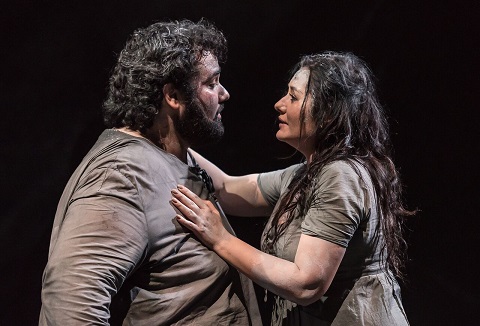 > Andrew Haji & Olga Busuioc. Photo credit: Clive Barda.
> Andrew Haji & Olga Busuioc. Photo credit: Clive Barda.
Canadian tenor Andrew Haji gave a strong performance as Hélios. Having drained the Queen’s proffered goblet, the weak-willed slave delivered an ecstatic declaration of love for Olympia which was impassioned, sweet-toned and gracefully phrased. Haji has a lovely lyric tenor which stays firm and sure even when expressing extremes of joy or repentance. His romance with Olga Busuioc’s Lilia in the opening act, heightened by the oboe’s gentle sighs, presented a moving portrait of their pure love, simple life and true faith.
Romanian Busuioc displayed considerable strength and colour as Lilia, but did not match Pini’s vocal control; the line was not always even and elegant. Her Act 3 Credo was committed and intense, however, as she persisted to profess her faith in the face of the pagans’ cries for her execution. And, Busuioc’s lengthy duet with Haji in Act 4 was a high-point, musically and vocally.
As Nicanor, English bass-baritone Simon Bailey lacked a little darkness at the bottom but sang fluently and acted well. His Act 2 duet with Lilia was secure and the tone appealing. When ‘resurrected’ as Satan, Bailey had an unfortunate ‘Ready Brek glow’ (for those who remember TV advertisements of the 1980s), inadvertently lessening his menace; but, Satan’s imploring cries to the Christians to rise up and rebel, at the start of the final act, were urgent, rousing and spine-chilling. It was a terrific moment of theatre … as if we had strayed into the barricades scene in Claude-Michel Schönberg’s Les Misérables. Irish baritone Rory Musgrave, as the divinely inspired prophet Magnus, matched Bailey’s intensity. Musgrave’s monotone declamation in the opening act was focused and captivating, and the image of the prophet stripped to a ragged loincloth, smeared with blood and wine, was as arresting as the tremor of Vesuvius that thundered at this point.
Conductor Jean-Luc Tingaud drew forth the details from David’s colourful score; the orchestral interlude portraying the effect of the love potion on Hélios was vibrant and evocative, and Tingaud appreciated the way in which David’s orchestration - much admired by Berlioz - enhances moments of tension and majesty.
In its day, Heraculanum was as popular at the Paris Opera as Gounod’s Faust and Verdi’s V êpres Siciliennes: in 1867 the Emperor Napoleon III awarded the opera a prize, as the ‘work most appropriate to honour the country’. But, though this was a worthy production, Medcalf struggled to overcome the frequent flatness of David’s score which is only sporadically animated by a stirring chorus or theatrical éclat.
David Agler’s first Festival programme, in 2005, included Carlisle Floyd’s Susannah (1955). Since then, the US-born, Canadian-domiciled Agler has introduced a series of American operas to Wexford audiences: Conrad Susa’s 1973 two-act chamber opera Transformations in 2006;The Ghosts of Versailles (1991) by John Corigliano in 2009; The Golden Ticket by Peter Ash, an opera based on Roald Dahl’s Charlie and the Chocolate Factory in the year of its premiere, 2010; and Kevin Puts’ Silent Night (2011) in 2014.
This year, Agler invited Rodula Gaitanou - whose 2012 WFO production of Delius’s A Village Romeo and Juliet was deservedly admired - to direct Samuel Barber’s Vanessa. When it was premiered at the Met in 1958, Barber’s first opera was hailed as ‘the best U.S. opera yet staged at the Metropolitan’ by the New York Herald Tribune, ‘the finest and most truly ‘operatic’ opera ever written by an American’ in the New Yorker, and won Barber the 1958 Pulitzer Prize. Yet, European stagings are not common. Gaitanou’s thoughtful, probing production showed why they should be. With designer Cordelia Chisholm, Gaitanou balanced the Chekhovian introspection and pathos of the opera with its great Romantic theatricality, and in so doing conjured a penetrating, modern, psychological intensity.
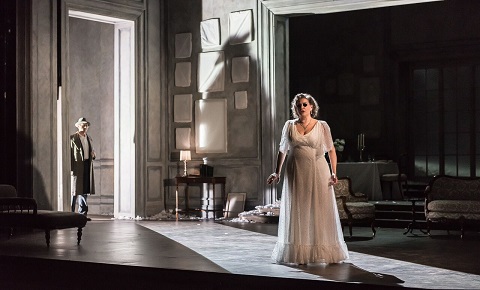 Michael Brandenburg and Claire Rutter. Photo credit: Clive Barda.
Michael Brandenburg and Claire Rutter. Photo credit: Clive Barda.
The libretto was written by Barber’s life-long partner, Gian Carlo Menotti. The action is set in 1905 - Gaitanou’s updating to the 1950s is inconspicuous and unobjectionable - in an unspecified ‘northern country’. Vanessa, a ‘lady of great beauty’ and Erika, Vanessa’s passionate but naive twenty-year-old niece, live in Vanessa’s country house with the latter’s mother, the Old Baroness, who refuses to speak to Vanessa. For twenty years, Vanessa has shut herself away, yearning for Anatol, her long-lost lover. At the start of the opera, she excitedly but anxiously anticipates his return, but the man who arrives is in fact Anatol’s son. He shares his late father’s name, and charisma: Vanessa accepts the younger man as a substitute for her former love; Erika too succumbs to his charms. Anatol toys with the affections of both women, though it Erika to whom he proposes, only to have his marriage offer rejected, for she senses that he does not love her. Vanessa and Anatol subsequently announce their engagement, at a ball. Erika, pregnant with Anatol’s child, rushes out into the cold night; she is later discovered, half-frozen. She has aborted her pregnancy, and the Baroness punishes her with silence. Vanessa and Anatol prepare to move to Paris leaving Erika to take her aunt’s place, entombed within the house, enduring the Baroness’s silence, and aching for lost love.
Menotti described the opera as a story of ‘two women ... caught in the central dilemma which faces every human being, whether to fight for one’s ideals to the point of shutting oneself off from reality, or to compromise with what life has to offer, even lying to oneself for the mere sake of living’.
Chisholm’s quiet, grey set, with French windows set at different depths through which we glimpse the gently falling snow, conjures a frozen world. Time has stopped for Vanessa; the mirrors and paintings are covered to negate the reality that the glass would assert. Vanessa hides in the past, but in so doing paradoxically smothers the vitality of her youth: we are reminded of Blanche DuBois’s fear of the light that would illuminate the truth, and of T.S. Eliot’s observation, ‘Human kind cannot bear very much reality.’ The Baroness stands at an easel, painting the truthful likenesses that Vanessa seeks to deny.
Claire Rutter immediately communicated Vanessa’s impetuousness and fragility. Excitedly instructing her old retainers to prepare food and wine for the anticipated visitor, Rutter’s gorgeously vivid soprano evoked the force of Vanessa’s wilfulness and self-centredness. She tackled the role’s coloratura demands with flamboyance and flair, and the ornamentation and chromaticism that convey Vanessa’s erraticism was totally secure. Snatching the copy of Oedipus from which Erika is reading to her, Vanessa criticises her niece's lack of passionate intensity - ‘You do not know how to read. You have never known what love is.’ Rutter then launched into Vanessa’s own melodramatic recitation with theatrical and musical abandon, relishing the elongations and plunges of Barber’s melodic oration, easily negotiating its floridity and wide range.
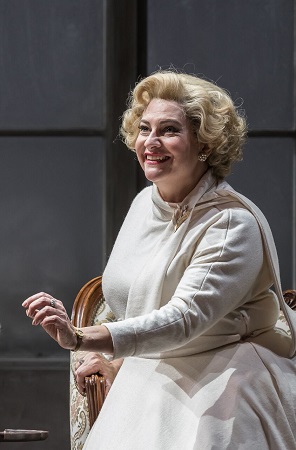 Claire Rutter as Vanessa. Photo credit: Clive Barda.
Claire Rutter as Vanessa. Photo credit: Clive Barda.
But, Rutter did not neglect to reveal the precariousness of Vanessa’s psychological state. Anatol’s arrival was signalled visually by a looming, menacing shadow, as Vanessa turned her back to her imagined former lover, instructing him, ‘Do not utter a word’; the long aria which followed was dramatic and tense, building mesmerizingly to Vanessa’s shriek of horror when the young man responds, ‘I think I could love you’, and reveals her delusion and error.
Carolyn Sproule’s Erika was, by contrast, pragmatic and more self-contained; though Erika’s delicate poetic sensibility and naivety were apparent from the first. Sproule’s lovely mezzo-soprano glided through Erika’s lyrical melodic phrases, but there was a dark gleam to the tone that hinted at inner spiritedness and soul, and that came gradually and painfully to the surface.
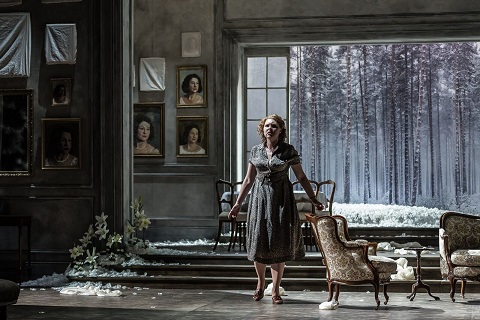 Carolyn Sproule as Erika. Photo credit: Clive Barda.
Carolyn Sproule as Erika. Photo credit: Clive Barda.
Michael Brandenburg’s Anatol was a magnetic and reckless imposter, ostentatiously teasing Erika by referring to Boris Godunov, describing himself as ‘the false Dmitri, the Pretender’ and inviting Erika to become his ‘Marina’. Brandenburg coped bravely with the high tessitura and had the vocal resilience to negotiate the stamina-demanding passages, such as his big Act 2 duet with Vanessa.
Rosalind Plowright was a disquieting presence as the Old Baroness: knowing, candid and unforgiving, she was a steely portrait of disapproving hauteur. As the Old Doctor, James Westman, singing with a warm, full baritone, brought some welcome lightness and wit: nimbly teaching Anatol to dance, drunkenly and insouciantly tossing champagne flutes to the footman. The Wexford Festival Orchestra played with fire and vigour under conductor Timothy Myers.
Gaitanou and Chisholm effectively conveyed the psychological reversal that we witness unfold. We watched the frivolities and fun of the ballroom scene through Erika’s eyes: standing alone on the staircase, she caught fleeting glimpses of whirling coloured dresses through the frosted glass, and felt the warmth of the celebration through an intermittently opened door. As the now blonde Vanessa sought to re-live the past, so Erika’s youthfulness drained away. The dissonant, homophonic lament in Act 4, as the principals stepped out of character to form a Greek-style chorus, evoked pity not just for the senselessness of Erika's wasted youth but also for the ephemerality of all beauty and life.
Last year, director Fabio Ceresa’s thrilling staging of Pietro Mascagni’s Guglielmo Ratcliff placed infatuation, passion and bloody violence centre-stage and conjured quintessential Gothic terror. This year, Ceresa reunited with costume designer Giuseppe Palella and Riccardo Olivier, who choreographed Guglielmo Ratcliff and now served as Ceresa’s assistant director, to dish up more supernatural vengeance, excessive bloodshed and stirring shudders of foreboding in the form of Donizetti’s overwrought tale of sexual obsession - his 1838 dramma tragico, Maria de Rudenz.
Maria de Rudenz stems from a troubled time in Donizetti's life. His wife, Virginia, had died in July 1837 during a cholera epidemic, at the age of only twenty-eight. The composer had also recently lost his parents, and three infant children. Grief-stricken, he had to fulfil his commitments to complete Roberto Devereux, negotiate with the Paris Opera with respect to censorship arrangements, and honour a contract with impresario Alessandro Larani to composer an opera for the re-opening, after a fire, of La Fenice.
Based on an 1835 play by Auguste Anicet-Bourgoeis and Julien de Mallian, La Nonne sanglante (which was itself sourced from an episode in Matthew Lewis’s 1796 novel, The Monk), Salvadore Cammarano’s libretto for Maria de Rudenz is one of the most gothic texts that Donizetti ever set. It practically haemorrhages uncanny, unsettling effects and symbols - bloody daggers and damaged psyches, sepulchres and spectral visitations, echoing crypts and secret chambers. When it was ruled too bloody, because no one was left standing at the final curtain, Cammarano omitted one of the corpses and the text slipped through the censors’ net.
Before the opera begins, Maria de Rudenz has been abandoned in the catacombs by her dastardly seducer Corrado, with whom she has eloped in defiance of her father. She escapes with the aid of a guide and returns to Rudenz to find that Corrado now plans to marry her cousin, Matilde - who, in the apparent absence of any other heir, will inherit the property. Torn between murderous rage and rampant passion, she tries to win him back - though it is perhaps not surprising that her extreme ploys fail: she threatens to cast Matilde into an abyss under the floor. Stabbed by Corrado, she does not die but creeps offstage into the bridal chamber to murder her rival. Corrado is confronted by what he assumes is Maria’s ghost. Maria, ‘resurrected’ from the grave, declares that she loves Corrado in spite of all that has happened - but then, in remorse, she rips bandages from her arms and dies in Corrado’s arms.
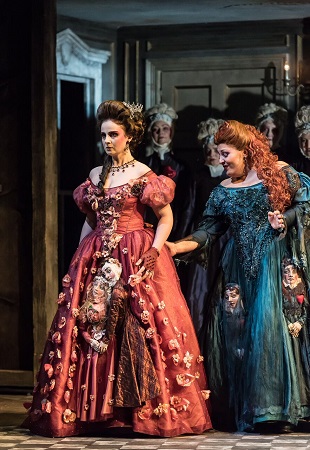 Sophie Gordeladze (Matilde) & Gilda Fiume (Maria de Rudenz). Photo credit: Clive Barda.
Sophie Gordeladze (Matilde) & Gilda Fiume (Maria de Rudenz). Photo credit: Clive Barda.
So, in good gothic fashion, the past invades and deranges the present. The original libretto is set in 15th-century Switzerland, but Ceresa and his set designer, Gary McCann, update the action to the period of the opera’s composition. They have constructed a monumental, multi-level set - an outsize, horror-film doll’s house - presenting us with a plethora of rooms lit in lurid greens, blues and crimsons by Christopher Akerlind. Much fussy activity ensues with the shadowy shoeboxes; and, pity the technical crew who have to manoeuvre this bulky construction with pinpoint precision, opening up fissures, exposing corners, and creating anxiety-inducing niches and angles.
Palella’s opulent, outré costumes for Guglielmo Ratcliff were a major contribution to that production’s disturbing, dislocating detachment, evoking a surreal inaccessible world which was nevertheless imaginatively gripping. Here, the outré verged on outlandish; the chorus, in particular, kitted out in purple and black cloaks adorned with scarlet, pierced pin-cushion hearts and sporting other-worldly head-dresses, looked as if they’d strayed in from the set of Kubrick’s Eyes Wide Shut.
As with Guglielmo Ratcliff, Ceresa successfully overcame the static nature of the expository accounts that are required to fill us in on the characters’ violent back-stories, and he whipped us skilfully through the recitative between the first two set pieces. However, after such swiftness, things become unnecessarily fussy. Puppets, manipulated with viciousness and vindictiveness by the protagonists, are perhaps intended to evoke the otherworldliness - the liminality - of Maria herself, hovering between life and death. But, there was so much tongue-in-cheek irony that the Gothic terror wilted: when Matilde slapped the Maria marionette the audience chortled; similarly, the beheading of the puppet which represented Corrado’s father generated much merriment. Gallows humour drifted into spoof.
Fortunately, the musical merits were considerable. In the title role - as the ‘woman who will not die’ - Gilda Fiume blazed her way through the technical demands, surmounting the stratosphere, nimbly whisking through the coloratura, and proved herself very much the soprano drammatico d’agilita. Her entrance aria won a sympathy that endured, despite her subsequent psychosis, as she wept in despair and announced her intention to retire to a convent and expiate the sin of defying her father’s wishes. Maria’s impassioned outpouring of love for Corrado, at the end of Act 2, burned with frenzied passion but was sweet of tone. The declamation at the end of this Act was powerfully focused. And, Fiume’s final aria displayed astonishing theatricality as she first revealed her vengeful anger in a slow movement of surprising melodic vigour, vocal control and stamina, with urgent leaps and tight rhythms; then, in the cabaletta, she won our sympathy - for it is love that drove her to such terrible crimes - with some astonishing pianissimo singing.
The Korean baritone Joo Won Kang gave an equally exciting performance as Corrado: he coped with the Verdian tessitura, his tone was silky, the phrasing elegant - he almost made a hero of the villain! Corrado’s sortita, ‘Ah! non avea piu lagrime’ is a renowned baritone warhorse but it was despatched with ease and aplomb; the embellishments were stylish.
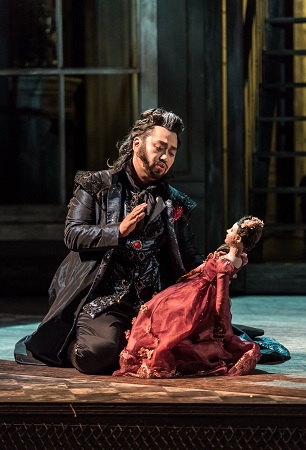 Joo Won Kang as Corrado. Photo credit: Clive Barda.
Joo Won Kang as Corrado. Photo credit: Clive Barda.
American tenor Jesus Garcia did his best to make something of the tangential role of Enrico. Similarly, Michele Patti made an effective contribution as Rambaldo, the old retainer, even though he had only a few recitative passages and interjections in choruses to make his mark. Georgian soprano Sophie Gordeladze displayed a piercing precision at the top as Matilde, though she was occasionally a bit shrill.
Chorus Master Errol Girdlestone had done sterling with the Wexford Festival Chorus, as was especially noticeable at the start of Act 3 when a spectre has been seen wandering the halls near the bridal chamber. Even though Donizetti’s music is surprisingly ‘jolly’ at this point - operatic convention demands an upbeat chorus - one could still admire the strength and vigour of the singing.
Conductor Andrew Greenwood made sure that we appreciated Donizetti’s vivid orchestration: the flutes sobbed painfully in Maria’s opening aria; eerie sound effects - string tremolos, keening woodwind, tolling timpani, powerful dark horn colourings - evoked a disturbed world.
The opening run of Maria de Rudenz at the Fenice consisted of just two performances; then, after a few performances in Italian cities, the opera fell into oblivion. Wexford made a good case for its musical merits though Cesera over-indulged his gothic imagination and presented us with Chinese boxes that the ghoulish tale does not require.
Other than Cesera’s dark witticisms, there weren’t many laughs in the main house this year. But, director Roberto Recchia can always be relied on to provide some rib-tickling comedy. Returning to the early-nineteenth century Italian repertoire (see my reviews of L’elisir d’amore (2013) and La Cenerentola (2014)), he offered us yet another delightful Short Work - Donizetti’s melodramma giocoso, II Campanello.
Il Campanello (The bell) - number fifty-three on William Ashbrook’s list of the seventy Donizetti operas - is a one-act, one-hour farce for which the composer himself wrote the libretto, basing it upon on a French vaudeville, La sonnette de nuit.
The elderly Neapolitan apothecary Don Annibale Pistacchio has just married the lovely Serafina, to the chagrin of her rejected suitor, Enrico. Out of spite, Enrico disrupts the wedding supper with delaying tactics - including a lengthy and ridiculous anecdote about Zasse, Zansze, and Zonzo, and a protracted drinking song. When the nuptial pair have departed for an evening of bliss, he creeps back to re-arrange the furniture, intending to trip up the lustful Don Annibale as he rushes eagerly to Serafina’s bedroom. During the night, Enrico interrupts the newly-weds by noisily ringing the bell, returning three times: first, in the guise of a pretentious French fop, then disguised as a hoarse opera singer, and finally as an old man who has every ailment that can be catalogued in a patter song par excellence. The law states that any apothecary who does not answer the night bell and provide his patients with the necessary prescription, whatever the hour, is liable to imprisonment, so the frustrated Don Annibale is obliged to tend to his visitors needs rather than his own erotic desires. As dawn approaches, the bell rings once again, and it is announced that the despairing, utterly confused pharmacist has been summoned to Rome on legal business, leaving the coast clear for Enrico to pursue Serafina.
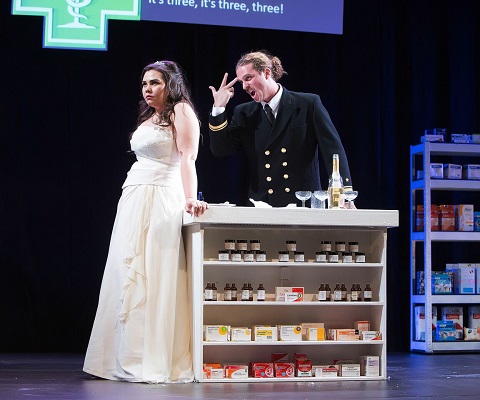 Rachel Croash (Serafina) & Michele Patti (Enrico). Photo credit: Malone Carty.
Rachel Croash (Serafina) & Michele Patti (Enrico). Photo credit: Malone Carty.
Donizetti links seven musical numbers with secco recitative, and provides copious opportunities for theatrical hyperbole and absurdity. Though it was a bit slow to get going, Recchia’s production was soon bubbling along at full throttle. The director knows how to make much from small means; economic constraints are no hindrance to a fertile imagination. So, though the raised platform in White’s Hotel - where the Short Works were again staged this year - was sparsely decorated, the clinical monochrome décor, illuminated Bowl of Hygieia insignia and medicinal cabinet succinctly set the scene, and told us all we needed to know about the likelihood of the frolicsome Serafina finding happiness with the unsentimental Don Annibale.
Donizetti enlivens the wedding feast by sprinkling the score with a Rossinian parody and some self-quotation. Taking the bait, after a prolonged and unruly brindisi, Recchia allowed the guests to indulge in a karaoke spectacle: the chorus shone in a barbershop quartet of Cole Porter’s ‘It’s De-Lovely’ accompanied by air-bass, while music director Tina Chang - fortified by a swig of wine from the bottle under her piano and a Gloria Gaynor-wig - launched into a fervent rendition of ‘I Will Survive’.
The two baritones in the cast have to do most of the work. In this performance, both proved excellent actor-singers and provided much enjoyment. Don Annibale’s opening aria, in which he anticipates his future offspring, was well sung by Pietro di Bianco, who settled into the role quickly and negotiated the high-lying line with ease.
Michele Patti relished Enrico’s bluster and audacity. In his mock-dramatic confrontation with Serafina, his threat to commit suicide prompted nothing more than a soaking with water from the indifferent bride, but his ingenuity was not dampened and he impersonated the ailing nighttime interlopers with aplomb. The opera singer’s number offered Patti the opportunity to show how good he is at singing both well and badly! Aided by a wincing Chang, he sought and failed to find his notes, but leapt up and down the octaves impressively, polishing off his performance (of ‘Nessun Dorma’) with a vocal flourish accompanied by a quaff of wine. As the indisposed pensioner, Patti whisked through his lexical extravaganza - an inventory of pharmaceutical requirements to outshine even Dulcamara’s virtuosic litany of cure-all remedies. His treatise listed every tonic imaginable, from the navel of Venus to asparagus, from grease to dry rot, an overload of tonics that caused the surtitles to fizz and malfunction.
Rachel Croash was bright of voice and vivacious of presence as Serafina, and she negotiated the coloratura confidently. As Serafina’s rapacious and shamelessly lascivious mother, Madame Rosa, Michaela Parry was a scream, swooning histrionically, flirting shamelessly, and gorging and imbibing unrestrainedly until she was sick in her wedding hat! Aidan Coburn was terrific as the resourceful Spiridione, Don Annibale’s lab assistant. A charming farewell trio rounded things off, but Serafina’s promises to stay faithful were wryly undermined by the final image of the entire cast pairing off for a lusty embrace.
Vaughan Williams’ poetic hymn to pain and resignation, Riders to the Sea, was an altogether more sombre and sobering affair. This time the bare stage was adorned with fishing nets, baskets, driftwood, a wooden table, a turf oven - the quiet but intense meagreness of life of the Aran Islands’ fisher-folk.
The composer’s almost verbatim setting of J.M. Synge’s play is a harrowing threnody in which a family living on the Isles, off the coast of Galway, come to terms with losing a grandfather, father, husband and five sons to the deep Irish waters. The opera is a compendium of resigned suffering worthy of a Greek tragedy, and this was effectively signalled by the slowing pouring of water from a jug and the monotonous kneading of dough that preceded the first bars of music. We were made to wait, as the family perpetually wait when the menfolk are at sea.
Director Caitriona McLaughlin and her set and lighting designers, Robbie Sinnott and Rory Beaton, allowed the tragedy to unfold with haunting simplicity. Philippa Boyle’s Cathleen was silvery and piercing, but not strident, pressing home the intensity of fear and loss, while Katie Lowe’s Nora was warmer and more richly coloured, revealing the depth and range of painful emotions. As Maurya’s last living son, Bartley, Lukasz Karauda’s robust baritone declaimed powerfully, suggesting masculine strength and optimism, and a doomed innocence.
The casting of Lara Rebekah Harvey as Maurya, however, was a mistake, not because of any technical deficiencies, but because Harvey simply looked too young and slight to have borne such suffering. More Dickensian urchin than bereaved daughter, wife and mother, Harvey was given a cartoonish white wig that only added to the incongruity. A walking stick might have helped, as it would have forced Harvey to adopt an altogether different physical demeanour. But, in the absence of any such enabling props, she sang reliably but introspectively - though there was a more ecstatic energy driving Maurya’s dream sequence.
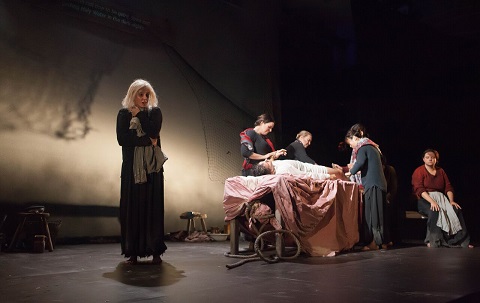 Lara Harvey & the cast of Riders to the Sea. Photo credit: Malone Carty.
Lara Harvey & the cast of Riders to the Sea. Photo credit: Malone Carty.
The choral keening, the glow of candlelight, the washing and shrouding of Bartley’s corpse all powerfully conveyed the family’s unremitting anguish. And, the piano accompaniment highlighted the organum-like harmonies and textures of the score, capturing the spiritual stillness of this disquieting opera.
Sadly, I was not able to see the third of Wexford’s Short Works, William Walton’s The Bear - another rarely performed opera, and thus typical Wexford fare. But, artistic director David Agler’s 12th festival offered much else to enjoy, and not just in the main house. Agler continues to innovate and develop: this year the lunchtime song recitals opened with a performance by the RTÉ Contempo Quartet, who offered the audience gathered in St. Iberius Church a diverse, challenging programme of quartets by Haydn and Bartók, framing a new work, 2016.3, by young Irish composer, Sebastian Adams.
Next year, the plan is to return to an 18-day Festival, which will extend over three weekends, and the programme is characteristically eclectic and adventurous. After the success of Cristina, regina di Svezia - for which Wexford won the Best Re-discovered Work Award at the International Opera Awards in 2014 - the Festival will return to Foroni, presenting the composer’s melodramma semiserio, Margherita, which was first heard in Milan in 1848, one year before Cristina was premiered in Stockholm. Risurrezione (1904) by Franco Alfano, best known for having completed the score of Puccini’s Turandot, and Cherubino’s Medea - which will star the 2015 Operalia winner Lise Davidsen - make up the trio of operas.
The 66th Wexford Opera Festival runs from Thursday 19th October to Sunday 5th November 2017.
Claire Seymour
Herculanum:
Lilia - Olga Busuioc, Olympia - Daniela Pini, Hélios - Andrew Haji, Nicanor/Satan - Simon Bailey, Magnus - Rory Musgrave; Director - Stephen Medcalf, Conductor - Jean-Luc Tingaud, Set & Costume Designer - Jamie Vartan, Lighting Designer - Christopher Akerlind, Chorus Master - Errol Girdlestone, Orchestra and Chorus of Wexford Festival Opera.
Vanessa :
Vanessa - Claire Rutter, Erika - Carolyn Sproule, The Old Baroness - Rosalind Plowright, Anatol - Michael Brandenburg, The Old Doctor - James Westman, Nicholas - Pietro di Bianco; Director - Rodula Gaitanou, Conductor - Timothy Myers, Set & Costume Designer - Cordelia Chisholm, Lighting Designer - Christopher Akerlind, Chorus Master - Errol Girdlestone
Maria De Rudenz:
Maria de Rudenz - Gilda Fiume, Matilde di Wolf - Sophie Gordeladze, Corrado Waldorf - Joo Wan Kang, Enrico - Jesus Garcia, Rambaldo - Michele Patti, Chancellor of Rudenz - Richard Shaffrey; Director - Fabio Ceresa, Conductor - Andrew Greenwood, Set Designer - Gary McCann, Costume Designer - Giuseppe Palella, Lighting Designer - Christopher Akerlind, Chorus Master - Errol Girdlestone, Orchestra and Chorus of Wexford Festival Opera.
Il Campanello:
Serafina - Rachel Croash, Don Annibale- Pietro di Bianco, Spiridione - Aidan Coburn, Madama Rosa -Michaela Parry, Enrico - Michele Patti, Coro (soprano) - Maria Hughes, Coro (mezzo-soprano) -Heather Ireson, Coro (tenor) - Andrew Gavin, Coro (bass) - Henry Grant Kerswell; Director - Roberto Recchia, Music Director - Tina Chang, Stage & Costume Designer - Robbie Sinnott, Lighting Designer - Rory Beaton.
Riders to the Sea:
Maurya - Lara Rebekah Harvey, Cathleen - Philippa Boyle, Nora - Katie Lowe, Bartley - Lukasz Karauda, The Woman/Coro (mezzo-soprano) - Lucilla Graham, Coro (soprano) - Eleanor Garside, Coro (soprano) - Jessie Tse, Coro (mezzo-soprano) - Sophie Goldrick; Director - Caitriona McLaughlin, Music Director - Benjamin Laurent, Stage & Costume Designer - Robbie Sinnott, Lighting Designer - Rory Beaton.
Wexford Festival Opera, Ireland; 26th-28th October 2016.
image=http://www.operatoday.com/Maria%20de%20Rudenz.png image_description=Wexford Festival Opera product=yes product_title= Wexford Festival Opera product_by=A review by Claire Seymour product_id=Above: the cast of Maria de Rudenz
Photo credit: Clive Barda
November 3, 2016
Opera Las Vegas Spook-tacular Halloween Concert
On Saturday evening October 29, 2016, Opera Las Vegas held a concert in a most elegant private home. After a glass of wine and some delicious hors d’oeuvres, members of the audience, most of whom were in costume, retreated to a salon that held some seventy chairs. With a grand piano in front and an “off stage” area to the side, the salon was as close to a concert hall as could be found in a private home. Artistic Director James Sohre, dressed as the Phantom of the Opera, introduced the artists and their selections, which began and ended with the Andrew Lloyd Weber musical theater work.
Artists from the Opera Las Vegas Young Artist Program were lyric soprano Emily Botts, dramatic soprano Karin Hochman, tenor Aldo Perelli, and baritone Michael Parham. Their collaborative pianist was Voltaire Verzosa. Since Verzosa also sings as a countertenor, he is a most sympathetic accompanist.
After the opening number from Broadway’s longest running musical, Botts emerged singing a radiant rendition of “Mesiku na nebi hlubokem” (“O moon, so high in the sky”) from Antonin Dvořák’s fairy tale opera Russalka. Aldo Berelli and Karin Hochman then sang two of the plaintive arias that Giacomo Puccini provided for the victims of Baron Vitellio Scarpia in his scorchingly dramatic opera Tosca. Berelli sang “E lucevan le stelle” (“the stars are shining”) and Hochman “Vissi d’arte” (“I have lived for art”). Perelli made his character's life seem ever so much more important because he knew he had so little time left, whereas Hochman added great drama to the contrast between her life in the arts and Scarpia’s devilish machinations.
Then it was time for a bit of comic relief and baritone Michael Parham provided it with his light-hearted and charming impersonation of Papageno, the happy-go-lucky bird catcher in Wolfgang Amadeus Mozart’s The Magic Flute. Although his intonation was not always perfect, his charisma made up for it. Botts returned with an evocative performance of Liu’s tragic aria from Puccini’s Turandot, “Tu che di gel sei cinta” (“You who are wrapped in ice”).
Hochman’s next selection was the rousing drinking song, “Si, colme il calice di vino eletto” (“Lift the cup with your favorite wine”) from Giuseppe Verdi’s first Shakespearean opera, Macbeth. Unlike this composer’s later works, Macbeth demands coloratura as well as dramatic stamina from the soprano. Perelli had an easier time with the lyric aria, “Ah, la paterna mano non vi fu scudo” (“Ah, the paternal hand did not defend you”).
Parham’s dramatic selection was a scene from Ambroise Thomas’s Hamlet. The title character calls out to the ghost of his father in “Spectre infernal” (“Spectre from the underworld”). In Gian Carlo Menotti’s The Medium, Monica sings of the sun, the moon, and a black swan. “The sun has fallen and it lies in blood”. She goes on to speak of the moon weaving bandage of gold. Botts sang this emotionally engaging but little known aria with a delightful tapestry of vocal color.
Hochman showed her dramatic vocal ability when she sang one of Amelia’s arias from Verdi’s Un ballo in maschera. Amelia has been told she must pick an herb from the ground under the gallows, and she sings, “Ma dall’arido stelo divulsa” (“But when that leaf has been torn from its dry stem”). This kind of drama is Hochman’s "meat" and she sang it with relish and great strength, both vocal and emotional. I have great hopes for the future of this young singer from Israel.
Parham returned with a number from Frank Wildhorn’s Dr. Jekyll and Mr. Hyde, the charming invocation of time, “This is the Moment.” It was the moment when, with the return to The music of The Phantom of the Opera, this memorable evening came to an end. Let’s hope Opera Las Vegas has another Halloween concert next year. I can think of a number of fitting selections for it that have not often been heard.
Maria Nockin
Cast and production information:
Cast and Selections:
Emily Botts: Hymn to the Moon, Russalka; Liu’s Aria, Turandot; “The Sun is Fallen”, The Medium. Aldo Perelli: “E lucevan le stelle”, Tosca; MacDuff’s Aria, Macbeth; “Music of the Night”, The Phantom of the Opera; Karin Hochman: “Vissi d’arte”, Tosca; Drinking Song, Macbeth; “Ma dall’arido stelo divulsa”, Un Ballo in Maschera; Michael Parham: “Der Vogelfänger bin ich, ja”, The Magic Flute; Spectre infernal, Hamlet; “This is the Moment”, Dr Jekyll and Mr. Hyde. All sang a finale from The Phantom of the Opera.
image=http://www.operatoday.com/LasVegas.png
product=yes
product_title=Opera Party in Las Vegas
product_by=A review by Maria Nockin
product_id=Above: Las Vegas
A magnetic performance by Christiane Karg
Soprano Christiane Karg proved utterly magnetic in two Mozart jewels that Fischer combined with the Symphony No. 38 in D major. In addition, he included Enescu and Bartók to form a highly engaging programme. The extreme contrast in styles before and after the intermission made me feel spoiled, as if I had attended two extraordinary concerts.
In the first part, Fischer led in Bartók’s unnerving masterpiece Music for Strings, Percussion, and Celesta, preceded by an Enescu gem from 1903: the haunting Prélude à l'unisson. This first part from the Romanian composer’s Orchestral Suite No. 1 C major consists of thinly layered strings with, towards the end, a gravid timpani roll charging at their transparent, high registers.
Fischer reached gorgeously rarified heights with the Berliner strings, preparing us for the eerie Bartók. Enescu’s music reminded me of the vastness of a Sibelius icescape, fluctuating between highly suspenseful pianissimos and thunderous, swirling fortissimos. Fischer’s slow burning build up silenced the audience. You could cut the tension with a knife!
In Bartók, he took us for an adrenaline ride full of crisp contrasts, rhythmic momentum, outbursts of brilliance, and highly dynamic volume. His eye for detail led to shrilling extremes including flashes of incandescent heat. Fischer conducted with chipper exuberance supported by his invigorating energy. With generous charm, he even appeared ever so briefly to tap-dance to the pizzicato pecks in the dance passages of the final Allegro molto.
Fischer put the brawny Berliners’ ferocious power on display in Bartók’s otherworldly universe. The strings sounded muscular but transparent. Percussion delivered exhilarating effects, while Marie-Pierre Langlamet on the harp punctuated her notes with a violent temperament. Nikolaus Resa’s celesta made for an alien ambience, while Hendrik Heilmann performed percussively on the piano. Nestled in the center of the antiphonal orchestral set up, the trio’s focused intensity in their interplay demonstrated their superb musicianship.
After the break, Christiane Karg elevated the evening to an even higher quality. Though initially put off by her exalted emergence, I was quickly put in my place as she then dazzled as Sifare, originally a castrato role in Mitridate, re di Ponto. Sifare has a secret love for Aspasia, pledged to marriage to his father the King. As she sang the Second Act’s “Lungi da te, mio bene”, her expressive vocal prowess took hold over me. The vulnerability in Ms. Karg’s eyes dramatically sustained my attention as she subsequently disarm me with her expressive phrasing. Refined, sturdy curves from the Royal Concertgebouw Orchestra’s Félix Dervaux elegant horn play enriched Ms. Karg’s razorsharp tendresse with a noble aura.
She continued her magic with “Misera, dove son! -- Ah! non son’io che parlo” from the Metastasio’s popular libretto for the opera seria Ezio, previously set to music by Handel and Gluck. With authenticity, Karg moved through the brooding to the fiery temperaments. She connects with the audience. At some moments, her sense of intimacy had me fooled she sang solely for me. Positively radiant, the BPO complemented her extraordinary performance. My eyes teared up several times.
Several people left after Karg’s performance. Perhaps they thought they had heard Mozart’s Prague Symphony too many times. Their loss, because with Fischer’s sensitive touch, this rendition sounded fresh and full of Classical lushness. It was the perfect ending to such an enthralling rollercoaster.
David Pinedo
Christiane Karg (soprano), Iván Fischer (conductor), Berliner Philharmoniker.
October 27th 2016; Berlin Philharmonie.
image=http://www.operatoday.com/Karg%20Christiane%2012%20%28Gisela%20Schenker%29.png image_description=Christiane Karg product=yes product_title=Christiane Karg with the Berliner Philharmoniker product_by=A review by David Pinedo product_id= Above: Christiane KargPhoto credit: Gisela Schenker
Christian Gerhaher sings Mahler’s Das Lied von der Erde in Berlin
The evening opened with Schubert’s Unfinished Symphony. Although I had hoped to be swept off my feet by the flight in Schubert’s melodies, Haitink’s determined and deliberate style instead brought all the layers in the work constructing an extraordinary, sonorous depth. He produced such captivating intensity, the concertmaster and his Berliner musicians were riffing like rock stars.
Haitink is still one of the best out there, but his fragility has given his recent performances more transparency exposing precious new details, rather than producing a sweeping, cohesive momentum. Part of me misses his former command and energy.
I marvelled at the synergy. Several times, the seated Haitink’s mere presence with his most subtle of directions clearly inspired the Berliners. His deliberate, succinct conducting created a rich tapestry of Schubert’s wonderful melodies as the BPO performed with utmost dedication to their Maestro. While at first I thought it seemed a bit slow, in the end the simmering build up paid off with a sublime climax.
With the same attention to detail and deliberate tempi, Haitink led the BPO that performed Mahler with a zealous commitment. His age showing a bit as he conducted from a seated position. The orchestra, sharply in tune with his minimal conducting, thrilled in Mahler’s temperaments. The piccolo at the end of “Von der Jugend” or the triangle in “Von der Schönheit” popped with great effect. How impressive Haitink generated such superlative sound with such little direction.
I have to confess, I was not aware that Mahler had orchestrated his closest work to opera with the option of a baritone instead of alto. A very tricky endeavour especially during “Der Abschied”. There aren’t many men that can pull it off. Tonight Gerhaher certainly demonstrated the virtues of this format as he realised a profoundly human character. His gravitas and richly nuanced phrasing gave it a deep melancholy. Gerhaher generated a very dour ambience, missing the lighter nuances. This last movement felt earthly, anchored in human sorrow. For all of Gerhaher’s qualities, he inhibited the fragile ascension into Mahler’s elevating catharsis. I prefer the softness of a female voice in this particularly ameliorating role.
Christian Elsner filled the tenor role with a particular Bohemian charm. With closed eyes, visibly moved by the Berliner’s music and Gerhaher’s soulful tone, he would sway back and forth with closed eyes. The longer Elsner’s seeming theatricality continued, the more I realised he was being authentic. As the drunk in love in the “Der Trunkene im Frühling”, he particularly impressed. Gerhaher’s almost bleak concentration during Elsner’s singing formed a striking contrast to Elsner’s obvious appreciation.
When returning for the applause, instead of walking directly to the front Haitink walked up the stairs to the musicians (as he would at the Concertgebouw). He demonstratively tapped his forehead with the palm of his hand and redirected himself to the podium. Where he deservedly but with his usual timidity accepted the audience ovation. His fragility notwithstanding, this octogenarian certainly created a high point of the season.
David Pinedo
Christian Elsner (tenor) Christian Gerhaher (baritone), Bernard Haitink (conductor), Berliner Philharmoniker.
7th October 2016. Berlin Philharmonie.
image=http://www.operatoday.com/BPhil_Haitink_081016_006.png image_description= product=yes product_title= product_by=A review by David Pinedo product_id= Above: Bernard Haitink.Photo credit: Monika Rittershaus.
November 1, 2016
A Russian double bill from the GSMD
I’m not sure that I agree, however, with director Kelly Robinson’s claim that both ‘Mavra and Iolanta are variants of the Sleeping Beauty fairy tale involving a beautiful princess, an enchantment involving sleep and a handsome prince’. Tchaikovsky’s tale of the blind princess Iolanta and her awakening into light and love certainly presents a dream-like world and a tender portrait of female suffering, sadness and sensual passion worthy of a sentimental fairy-tale. But, Stravinsky’s Mavra is altogether more down-to-earth, with its pseudo-realistic setting and parodic scorn for the superficiality of the petty, provincial middle classes.
It’s true that Stravinsky may have had Sleeping Beauty on his mind during the composition of Mavra, for he was working on Tchaikovsky’s ballet score at this time, devising new orchestrations for Diaghilev’s production of Sleeping Beauty in London in November 1921. But, it was not the myth itself, rather the aesthetic that Tchaikovsky’s music represented that seeped into Mavra: an open letter from Stravinsky to Diaghilev in The Times in October 1921 avowed the modernist Stravinsky’s admiration for Tchaikovsky, and a further letter to Le Figaro praised Tchaikovsky and Glinka as being superior to the other nineteenth-century Russian nationalists. Mavra, based on a short story by Pushkin (‘The Little House at Kolomna’), is dedicated to the memory of Pushkin, Glinka and Tchaikovsky, and Stravinsky described the opera as ‘Tchaikovskian in period and style’ - by which he meant the blend of Russian folk traditions and Western musical language and form that the older composer achieved in his later works.
With respect to Mavra, Robinson argues that Beauty’s sleep ‘is analogous to the lethargy and inward-directed focus of the teenager, the time before becoming an adult. Parasha, with her curiosity and growing fascination with love, but her unwillingness to seek love outside the home, and who draws the Hussar into the sanctuary ruled by her mother reveals her lack of readiness for the step toward self-hood symbolized in the waking of the “Princess” in the myth.’ This production did little to convince me of the merits of this reading of the opera - indeed it scarcely seemed to address this notion at all.
Instead, designer Bridget Kimak presents us with a 1950s bourgeois household in which a coquettish, fashion-conscious Parasha - decked out in floral Prom gown and pink pigtails - runs rings around her mother and their neighbour. The parochial pair - an eye-watering riot of clashing complementary colours and outlandish red hairdos - slump in front of their vintage TV console and, distracted by their complaints about domestic trivialities, the weather and the high cost of living, fail to notice when Parasha smuggles her Hussar love, Vassili, into the house in the guise of a new maidservant, Mavra. The update works well: if we ignore the issue of the servant, bourgeois preoccupations have probably changed little since Pushkin’s day, and Stravinsky’s parody of small town life rings true.
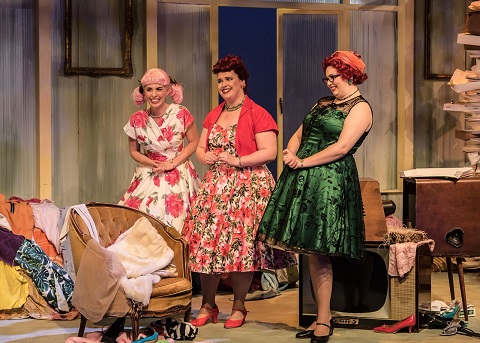 Margo Arsane as Parasha, Chloë Treharne as the Neighbour, Jade Moffat as Mother. Photo credit: Cliva Barda.
Margo Arsane as Parasha, Chloë Treharne as the Neighbour, Jade Moffat as Mother. Photo credit: Cliva Barda.
Margo Arsane’s Parasha is no Sleeping Beauty, although the soprano’s free-floating folk tune did - despite, initially, a slightly hard edge to the tone - evoke a dreamy wistfulness as she flicked through a fashion magazine, nonchalantly scattering random pages onto the tumbling towers of textiles upon which she was perched. Clearly, the household is in need of a housekeeper to bring the columns of hats and mountains of fabric under control: even the chandelier is strewn with debris. And, the cunning and resourceful Parasha knows just the person, and the plan, having pragmatically prepared a bra-rope to assist Vassili’s entrance through the window.
Arsane captured Parasha’s capriciousness and vivacity, and moved easily from the plaintive modality of her folk lament to the decorative exuberance of the role’s coloratura demands. However, though the opera was performed in English translation, sadly - as one fellow audience member was heard to remark - Arsane might as well have been singing in Hungarian, so weak was her diction; and this was a failing that was common to the cast, who at times struggled to be heard above the chugging rhythms and vamps of the wind-dominated instrumental accompaniment.
This was a particular problem for Jade Moffat, as Parasha’s Mother; her complaints about the dearth of good servants lay quite low in her voice and were lost within the orchestral texture. However, in the more sparsely accompanied passages, Moffat revealed a richly coloured mezzo soprano, and formed a neat comic double-act with Chloë Treharne’s Neighbour.
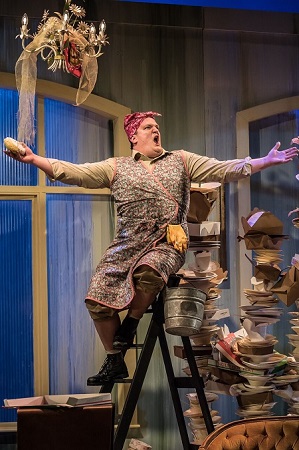 John Findon as Vassili. Photo credit: Cliva Barda.
John Findon as Vassili. Photo credit: Cliva Barda.
Vassili was exuberantly performed by tenor John Findon who had previously impressed in the role of the flirtatious fop, Oscar, in Martinů’s Alexandre bis in June earlier this year. Findon gave another characterful and technically assured performance. Vassili’s gypsy song of loneliness was ardent and his manner flamboyantly masculine. It wasn’t clear, however, why having lathered up shaving suds in a bucket he need to climb a step-ladder to shave; and, though, Vassili scarpered deftly when his cover was blown by the surprise return of Parasha’s mother, the swift ending felt somewhat anti-climactic.
Wheeler guided the instrumentalists nimbly through the ever-changing time signatures and rhythmic asymmetries, and he drew forth some of the liveliness and colour of Stravinsky’s inventive score. But there was neither quite enough jazzy vibrancy from the wind and brass, nor breathless excitement in the ensembles. Moreover, the repetitive, rugged folky accompaniments often overpowered the singers.
Robinson and Kimak swept away the household clutter revealing a minimalist set for Tchaikovsky’s final opera Iolanta, a one-act piece that he composed to form a double bill with The Nutcracker. Using plain, sliding screens, an invalid’s bed, black and yellow triangular hazard signs, and some futuristic scientific equipment, they suggest at once a convent, hospital and nuclear laboratory - as the chorus of twenty-six ‘orderlies, armour bearer’s administrators, nurses, nuns and scientists come and go, gathering fruit, tending the patient, conducting experiments. It’s a world far from the mountain region of southern France in the 15th century which was the original locale of the libretto, fashioned by Tchaikovsky’s brother, Modest, from Henrik Hertz’s play ‘King René’s Daughter’. Gone, too, are the hedge roses and fruit trees which adorn Iolanta’s lush garden - the verdure reduced to a bunch of red and white blooms atop the coverlet of the princess’s coverlet. But, the retinal imagery - darting, iris-streaking beams of light; swirling bottomless dark pupil-pits - of K. Yoland’s video designers effect, at the opening and conclusion, a convincing translation to a fantastical zone where myth, magic, medicine and mystery collide.
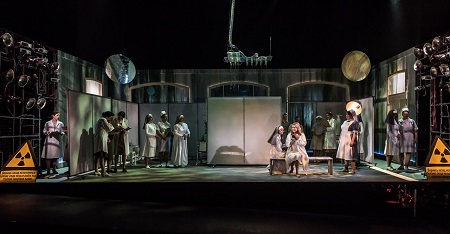 Photo credit: Cliva Barda.
Photo credit: Cliva Barda.
Iolanta, daughter of the Provençal King René, has been blind from birth. To protect her from knowledge of her affliction, her father has secluded her from the world; the ladies-in-waiting who attend her are forbidden under pain of death to refer to mention the power of sight, or light. A Moorish physician, Ibn-Hakia, tells the King that he can cure Iolanta, but only if she realizes that she is blind. Iolanta has been betrothed to Robert Duke of Burgundy; the latter knows nothing of her condition and wishes to be released from this contract so that he can wed his beloved Mathilde. Ignoring warnings not to enter Iolanthe’s garden, Robert and his companion Count Vaudémont stumble upon Iolanta; Robert is afraid and flees but Vaudémont falls instantly in love. When he realises that she is blind, he describes the power of the visual sense to Iolanta. Learning of Vaudémont’s disclosure, the distraught King condemns him to death. To save her beloved, Iolanta undergoes the cure. Robert persuades the King to abandon the betrothal and the opera ends in matrimonial rejoicing and a hymn to God’s light.
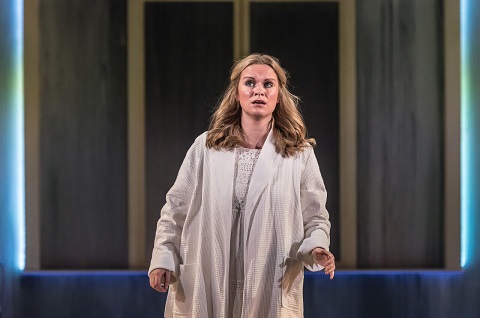 Joanna Marie Skillett as Iolanta. Photo credit: Cliva Barda.
Joanna Marie Skillett as Iolanta. Photo credit: Cliva Barda.
For this half of the GSMD double bill, the Russian text was retained and the cast seemed to cope admirably with the linguistic demands. As Iolanta, Joanna Marie Skillett negotiated the parlando and arioso lines of the opening fluently. Her soprano has not quite enough lyrical fulsomeness to allow one to imagine her, yet, as Tatyana, but her fairly light, even voice was well-suited to evoking Iolanda’s outer fragility and inner passion, and as she gained in confidence Skillett deepened the poignancy of her portrayal.
Dominick Felix was a stirring Vaudémont, powerful throughout the range and with a glowing top. He wrung every drop of emotion from his affecting encounter with Iolanta - as when, singing of his infatuation, he asks the princess for a rose the colour of her cheeks and is gifted a white flower by the sightless girl. Their climactic duet - in which he explains the meaning of ‘light’, only to be answered by her insistence that she does not need light in order to praise the Creator - was a blaze of music brightness; as the duo’s melodies embraced one to a tremendous orchestral outpouring the effect was wonderfully affirmative.
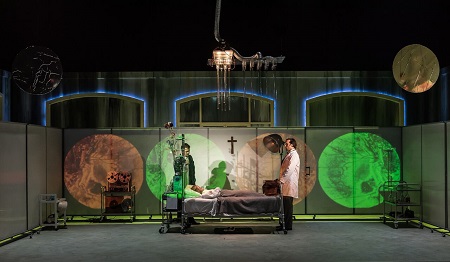 David Ireland as King René and Joseph Padfield as Ibn-Hakia. Photo credit: Cliva Barda.
David Ireland as King René and Joseph Padfield as Ibn-Hakia. Photo credit: Cliva Barda.
David Ireland communicated both King René’s stubborn sternness and the softness of his filial love - his prayer for his daughter’s recovery was dark-toned and moving, and Ireland garnered our sympathy despite the misguidedness of the patriarch’s actions. As the Moorish Ibn-Hakia, Joseph Padfield displayed a very focused baritone; he made the most of the physician’s modally inflected aria. Baritone Dominic Sedgwick preened fittingly as Robert, launching into an impassioned panegyric to Mathilde which betrayed the Duke’s self-absorption.
In the subsidiary roles, as Iolanta’s companions soprano Anna Sideris (Brigitta), mezzo soprano Bianca Andrew (Laura) and Moffat (Marta) led a charming women’s ensemble lulling Iolanta to sleep. Tenor Eduard Mas Bacardit as Alméric, armour-bearer to King René, and bass Bertie Watson as Bertrand, doorkeeper to the castle, completed the strong cast.
The enlarged instrumental ensemble skilfully created Iolanta’s world of darkness - a world rich in the sensory stimulations of sounds, scents and touch - notably in the prologue where dark-veiled woodwind gave way to the unfolding threads of solo strings and harp. Wheeler created an atmosphere of considerable tenderness and sorrow, which only served to make the conclusion, when all share a transfiguring vision of ‘the light’, even more spiritually uplifting.
Claire Seymour
Stravinsky: Mavra
Margo Arsane (Parasha); John Findon (Vassili); Jade Moffat (Mother); Chloë Treharne (Neighbour)
Tchaikovsky: Iolanta
Joanna Skillett (Iolanta); Dominick Felix (Vaudémont); Dominic Sedgwick (Robert); David Ireland (King René); Joseph Padfield (Ibn-Hakia); Anna Sideris
(Brigitta); Bianca Andrew (Laura); Jade Moffat (Marta); Eduard Mas Bacardit (Alméric); Bertie Watson (Bertrand); Chorus (of orderlies, armour bearers,
administrators, nurses, nuns and scientists).
Kelly Robinson - director, Dominic Wheeler - conductor, Bridget Kimak - designer, Declan Randall - lighting designer, K. Yoland - video designer.
The Guildhall School of Music and Drama Silk Street Theatre; Monday 31st October 2016.
image=http://www.operatoday.com/Iolanta%20set%202.jpg image_description=Iolanta, GSMD product=yes product_title=A Russian double bill at the GSMD product_by=A review by Claire Seymour product_id= Above: IolantaPhoto credit: Clive Barda